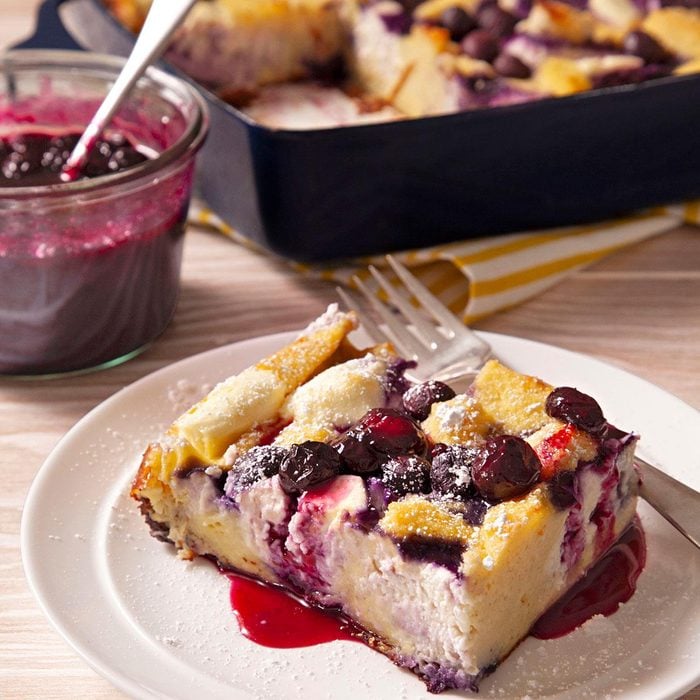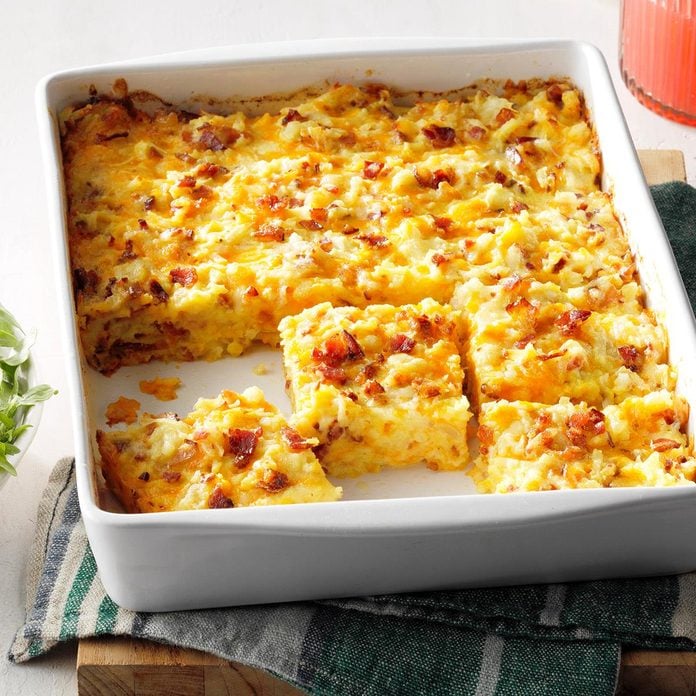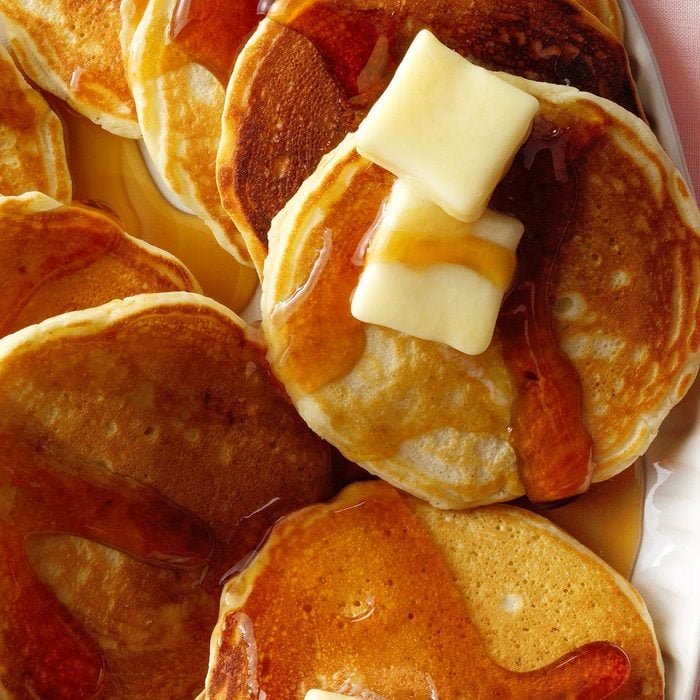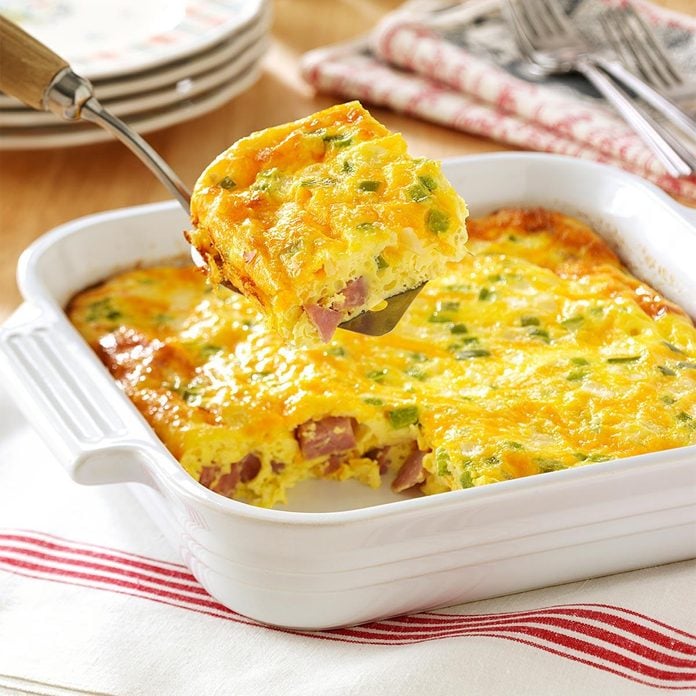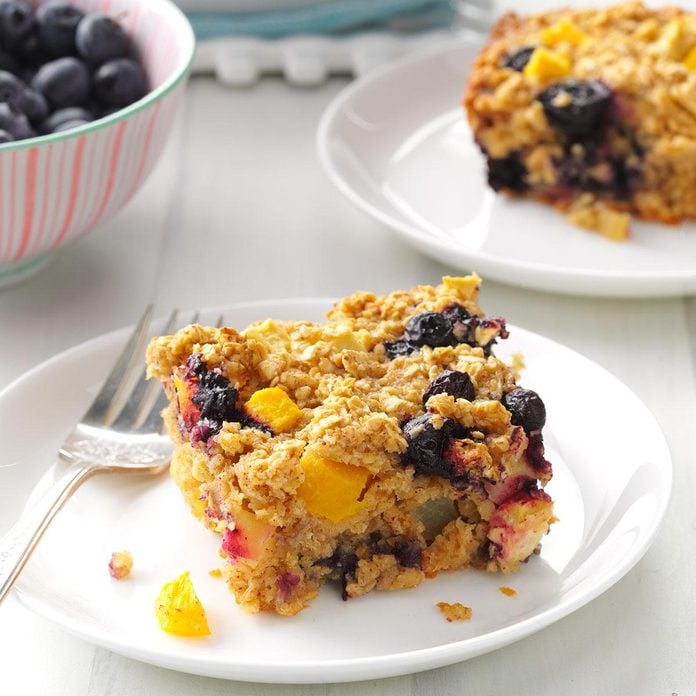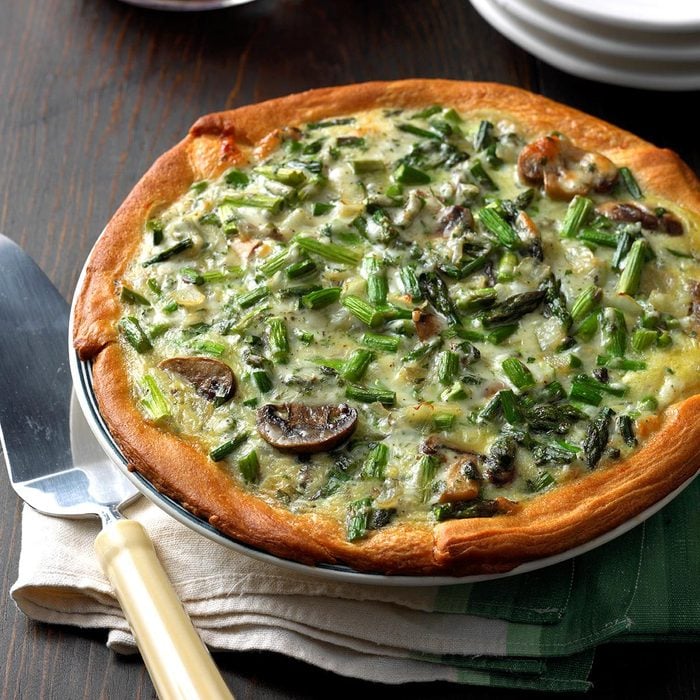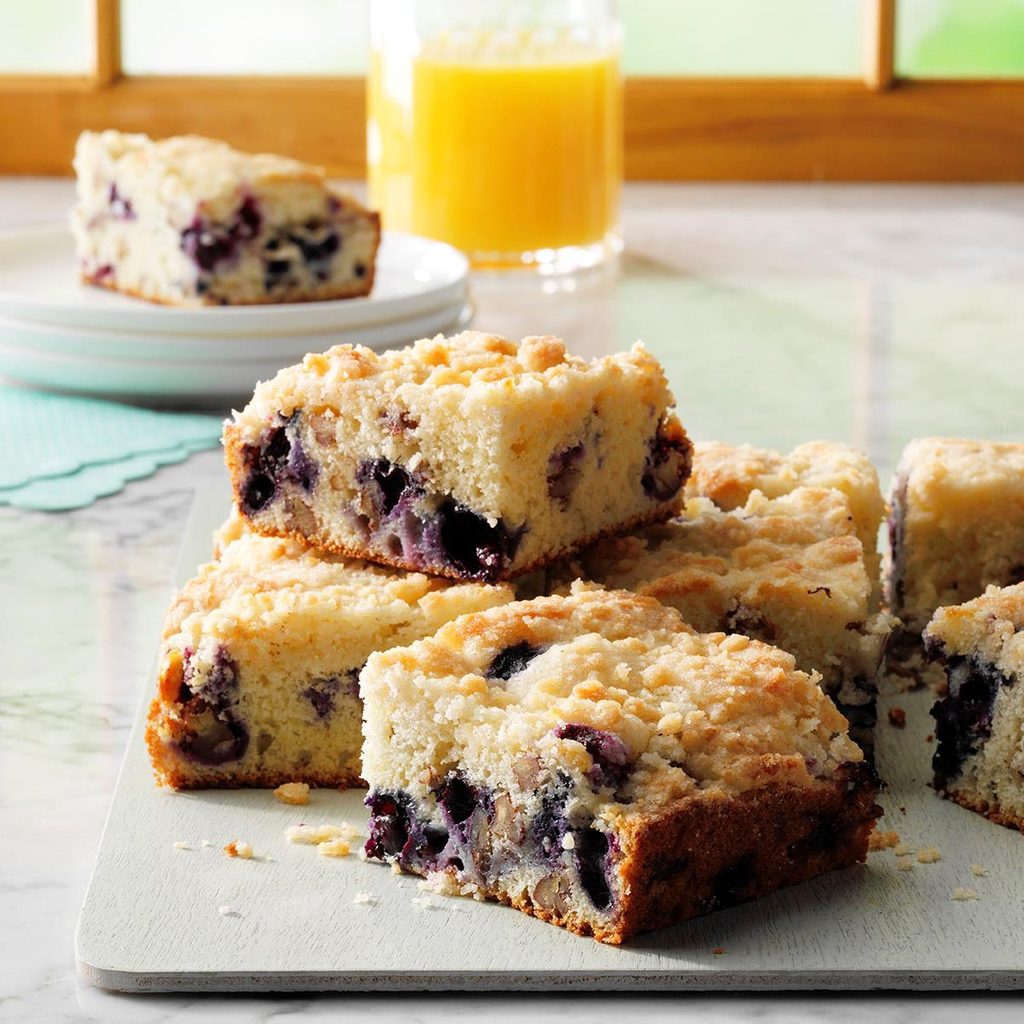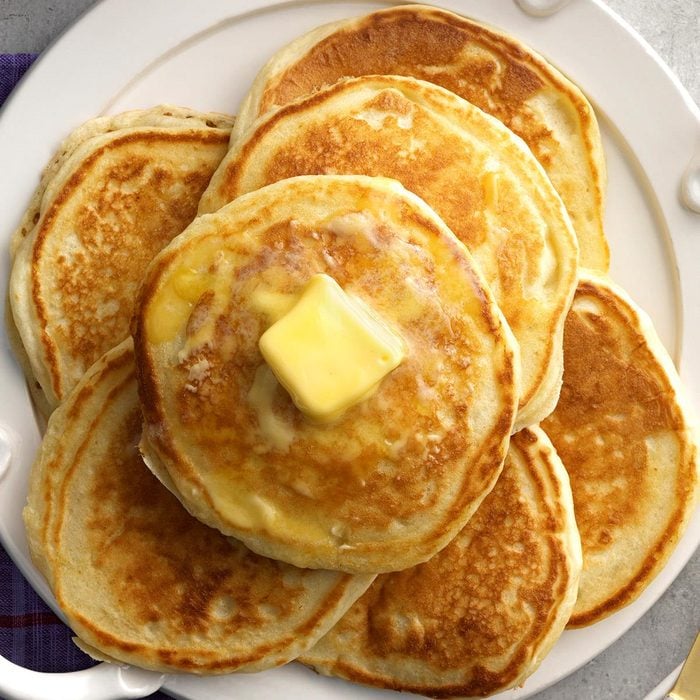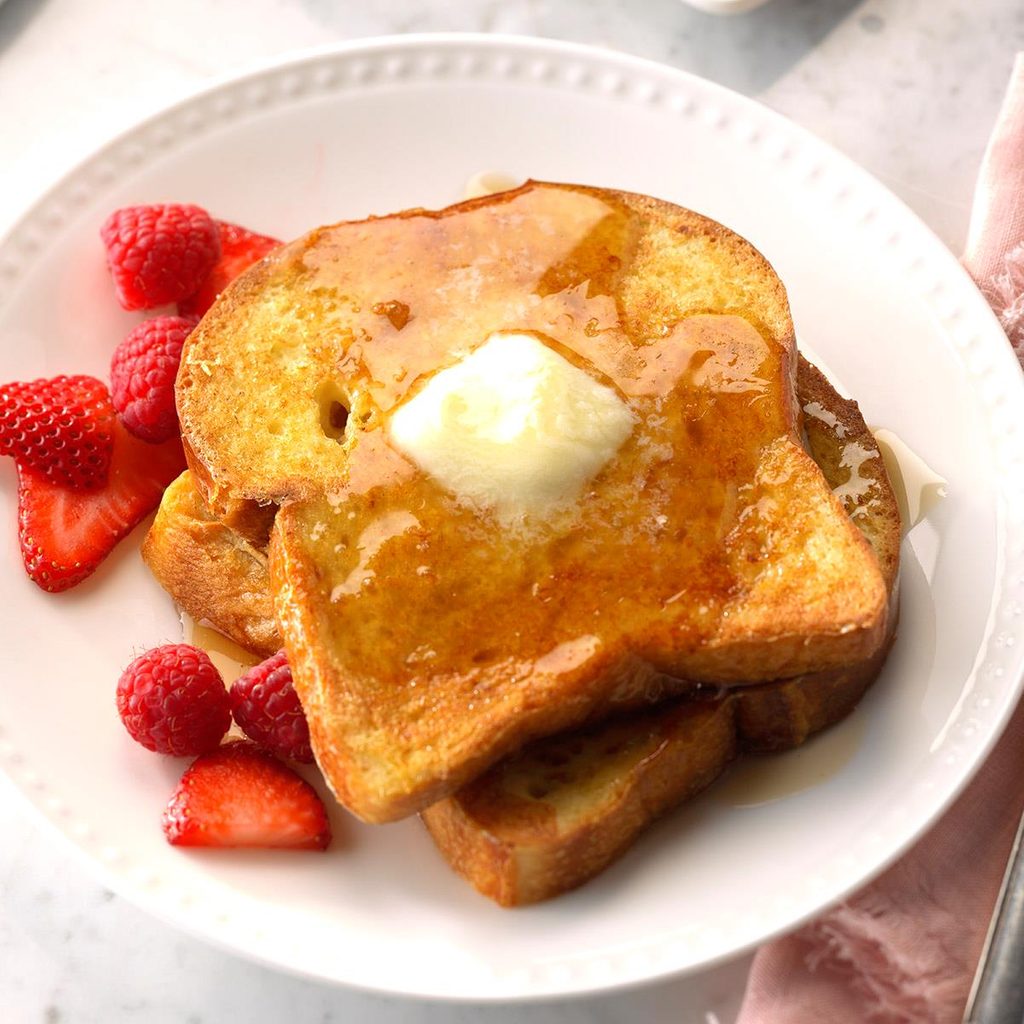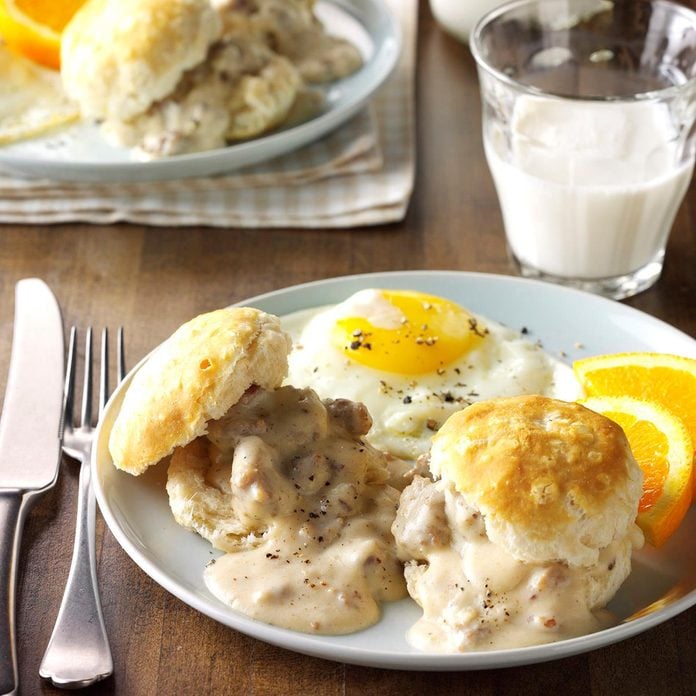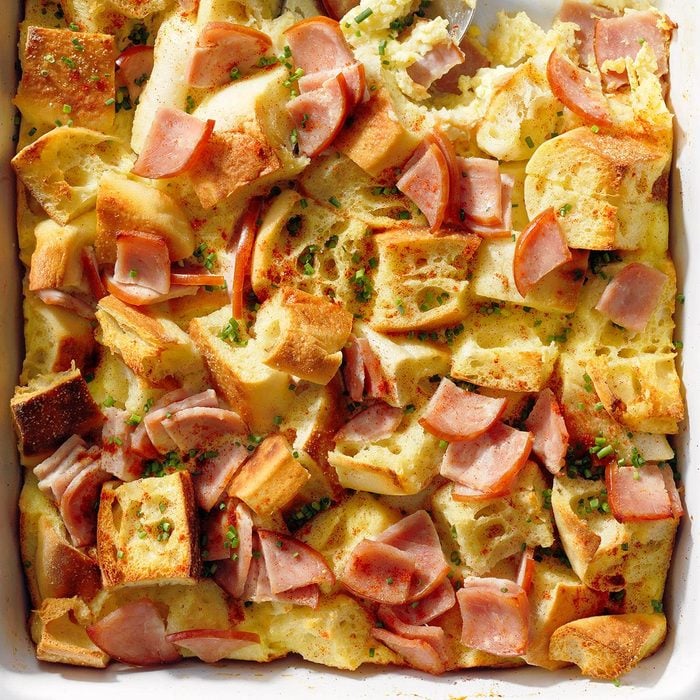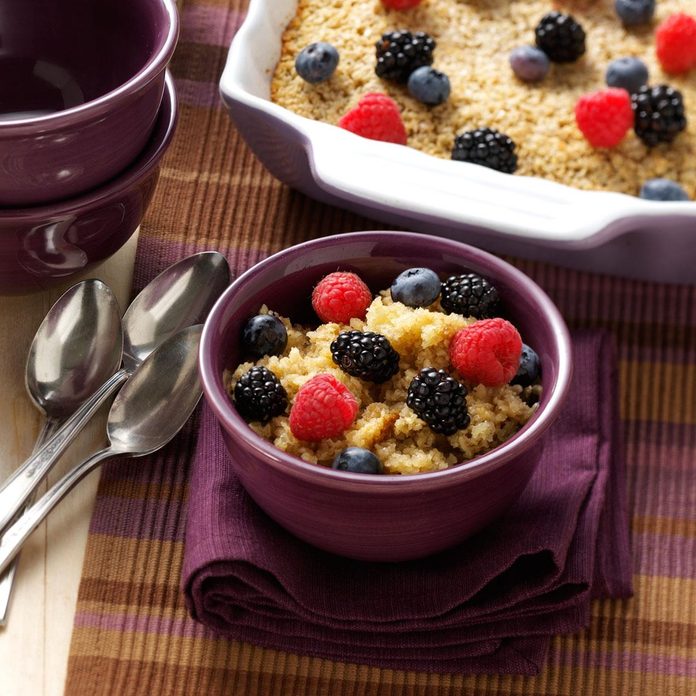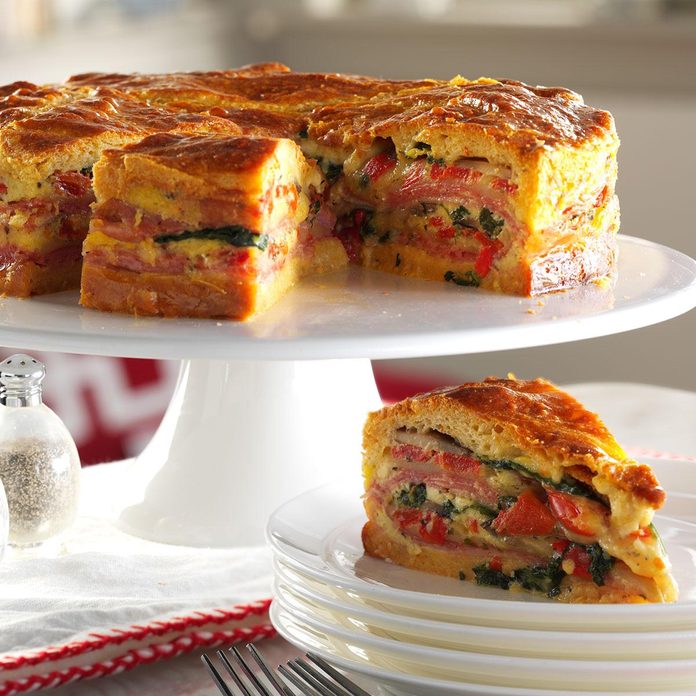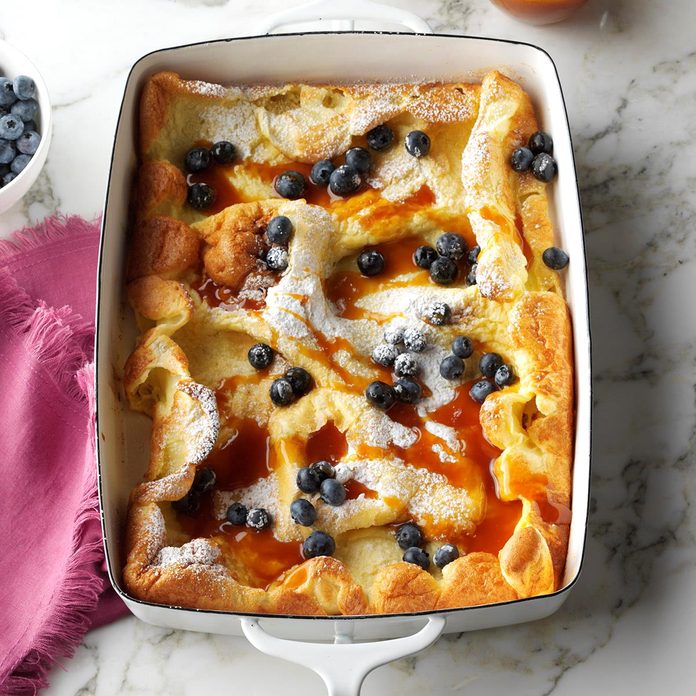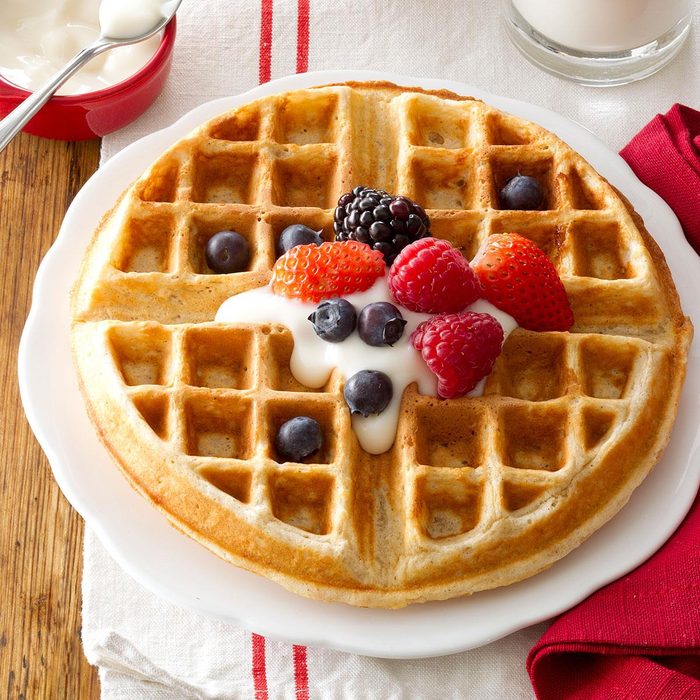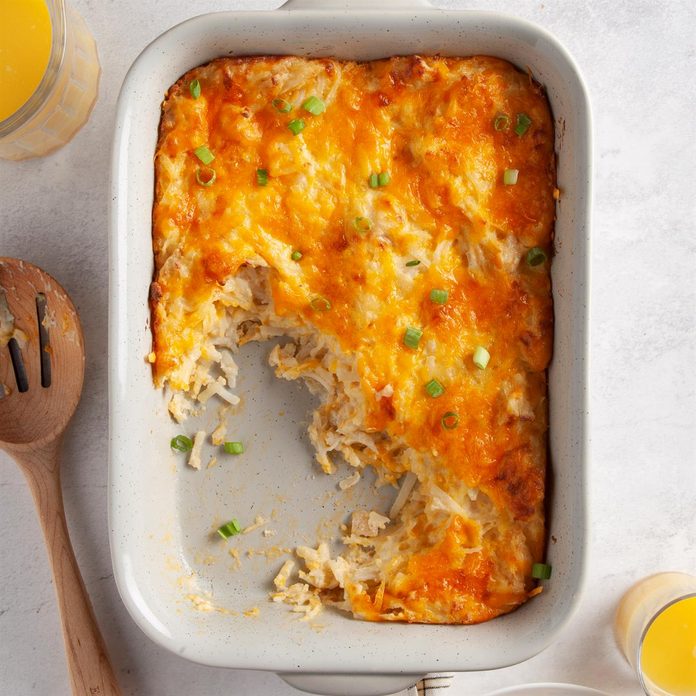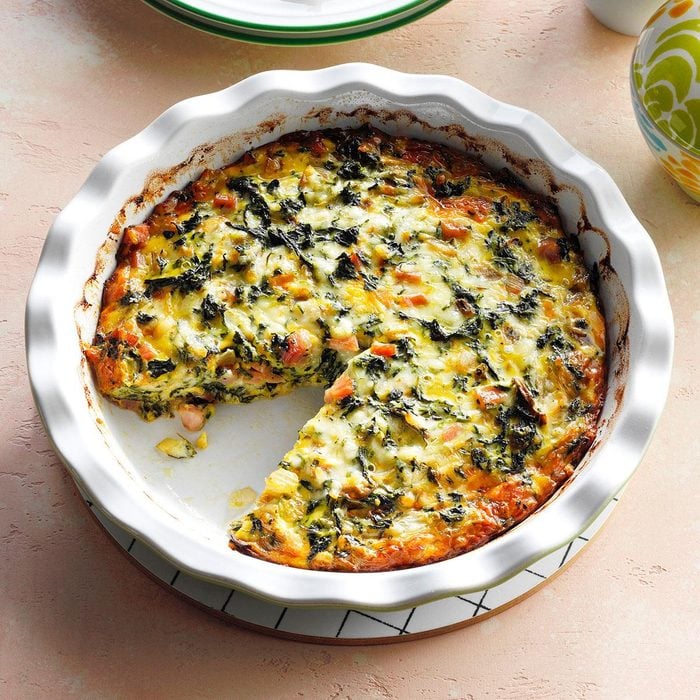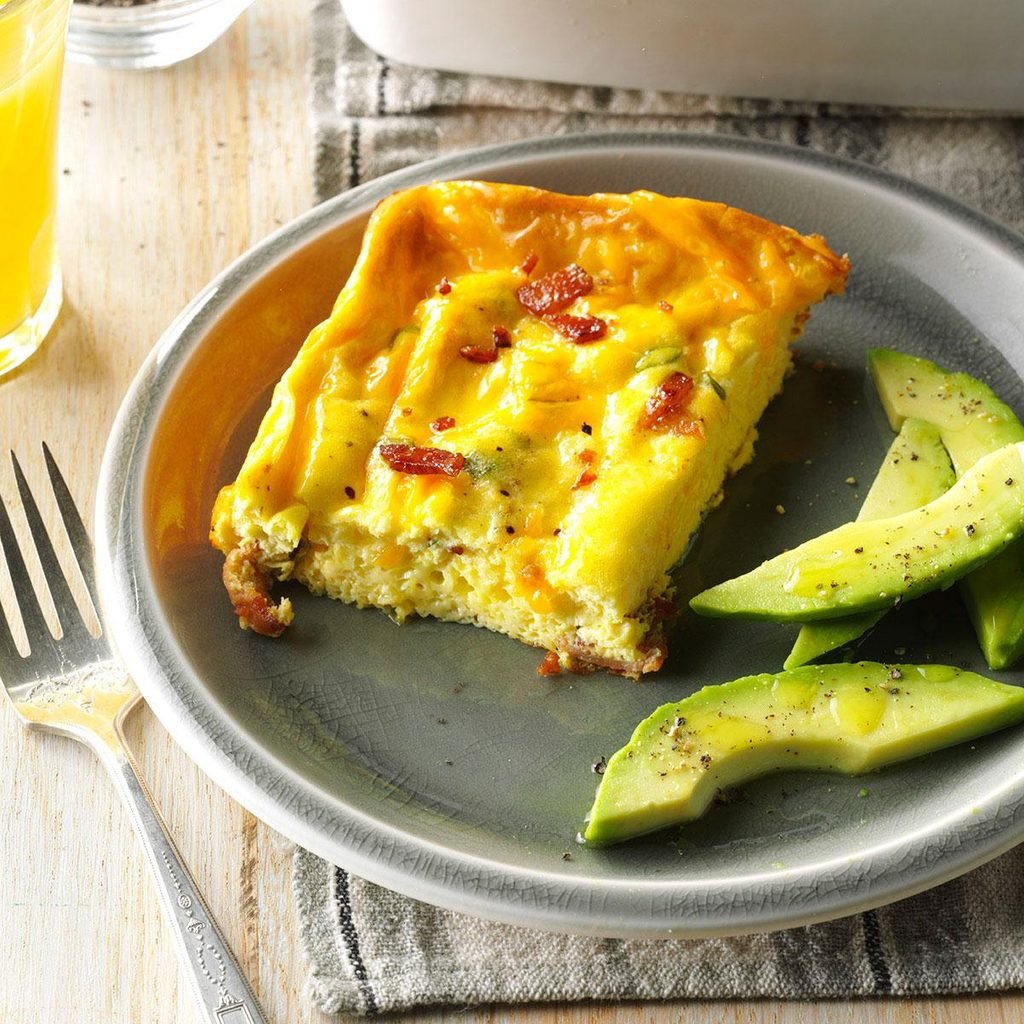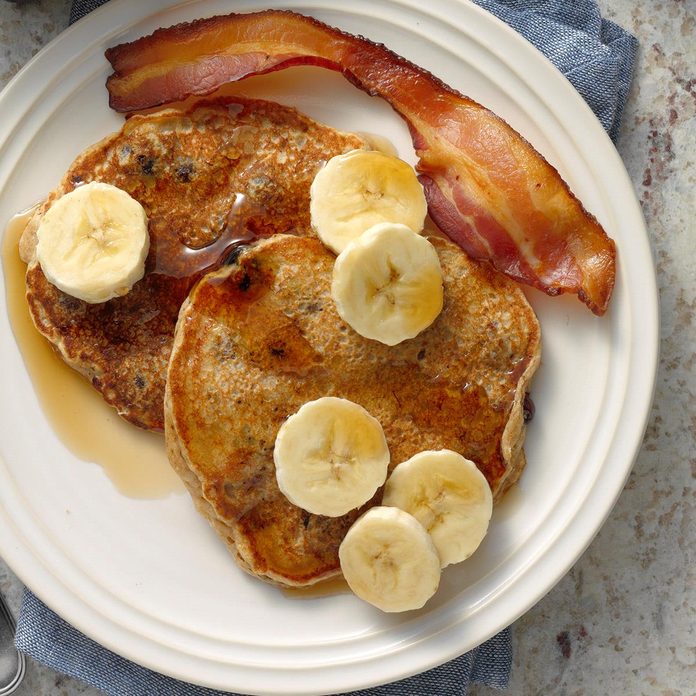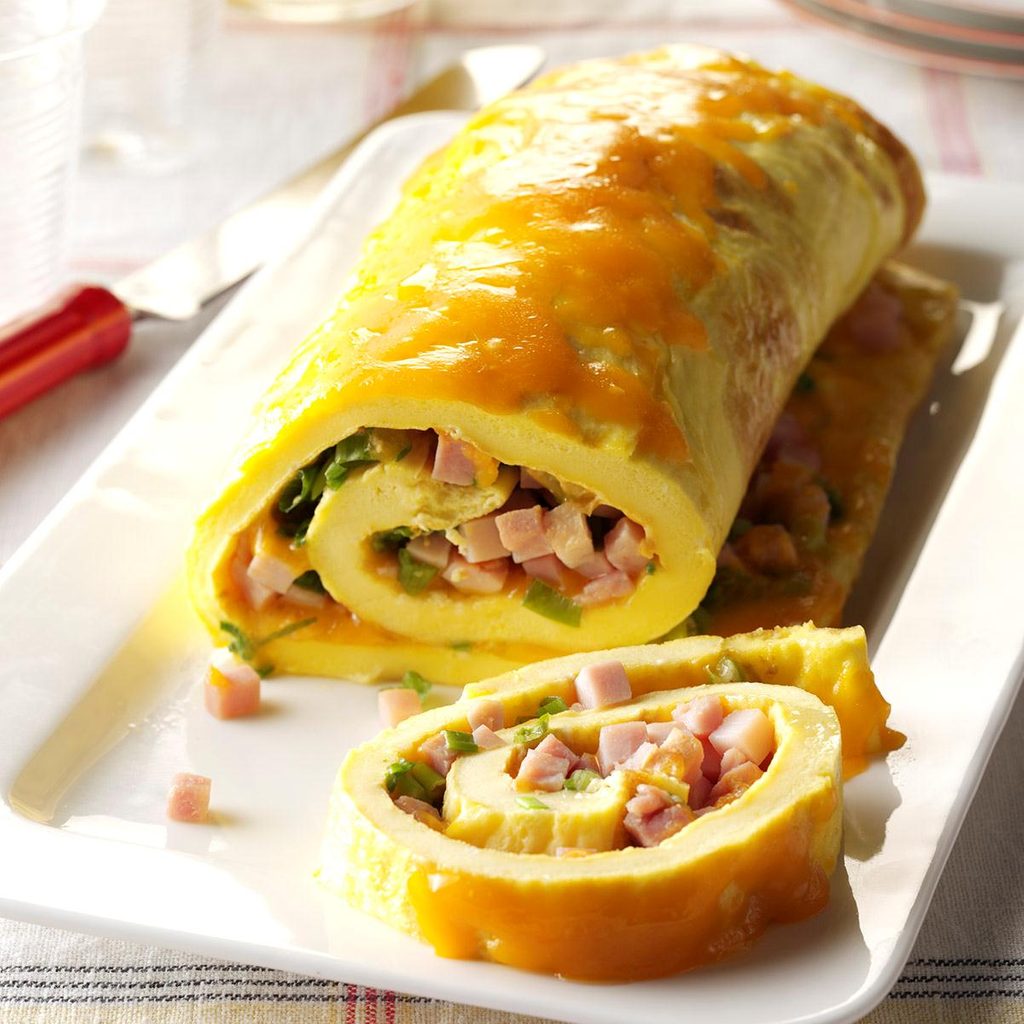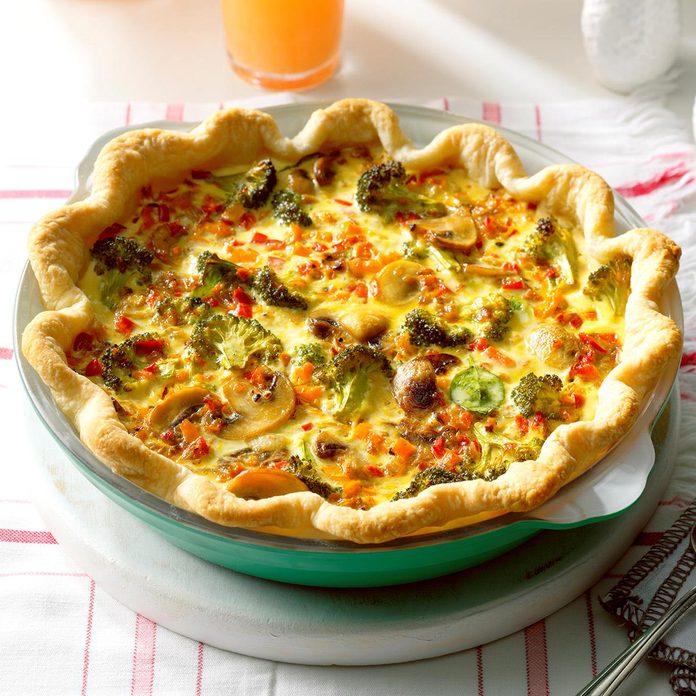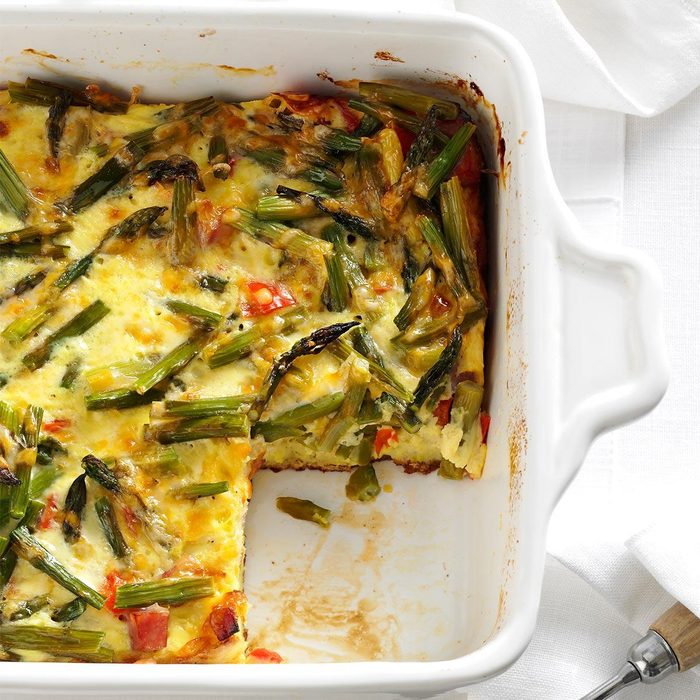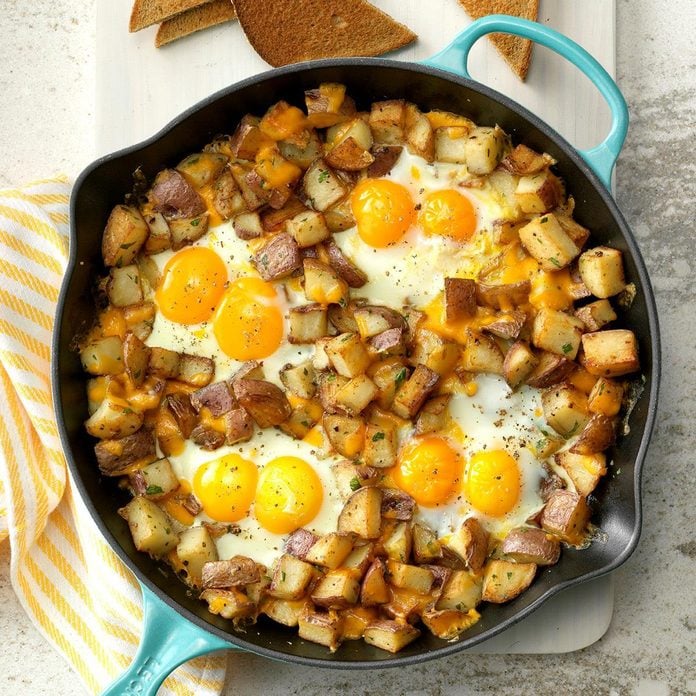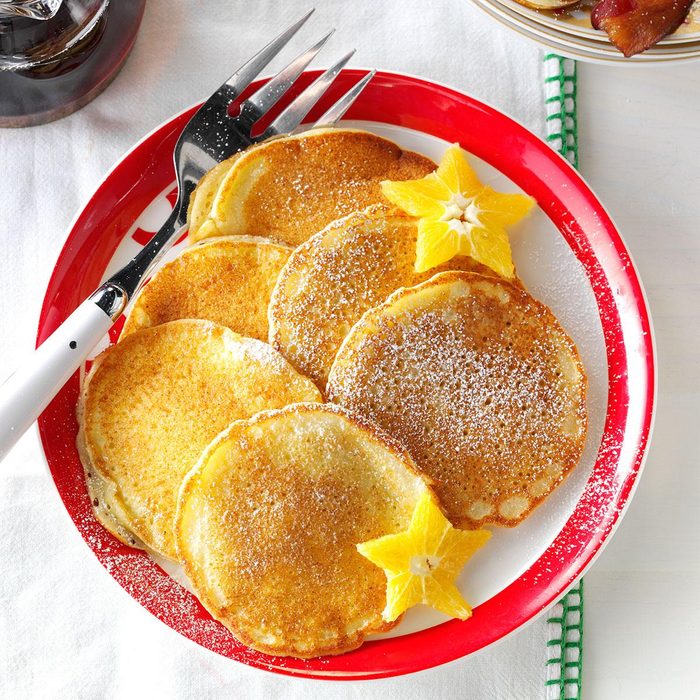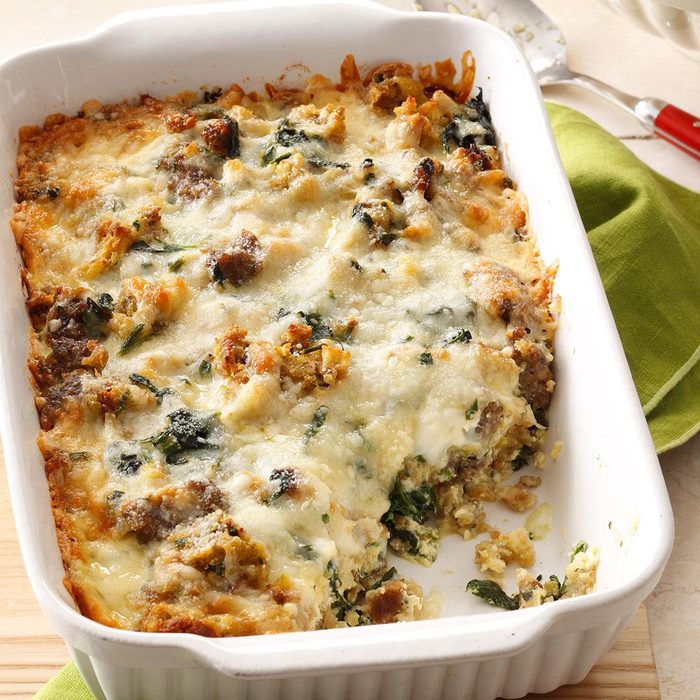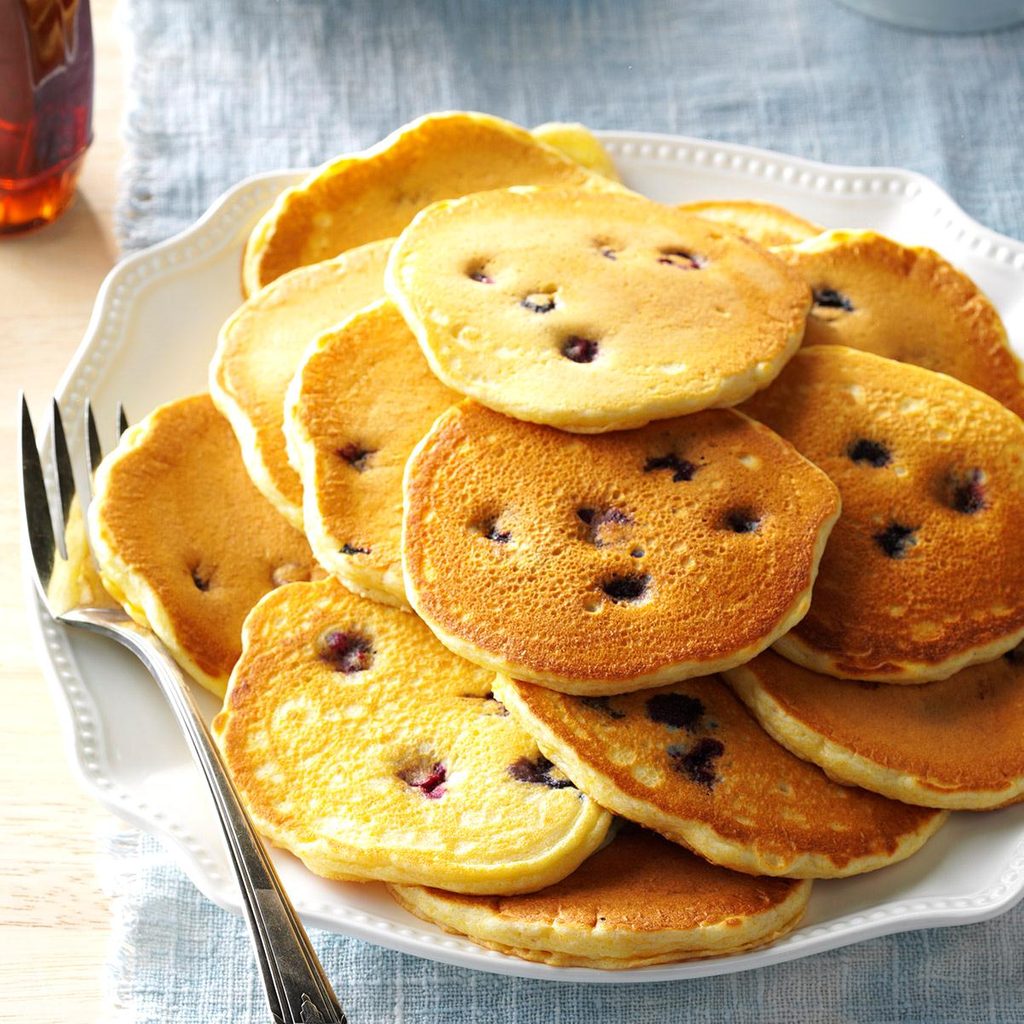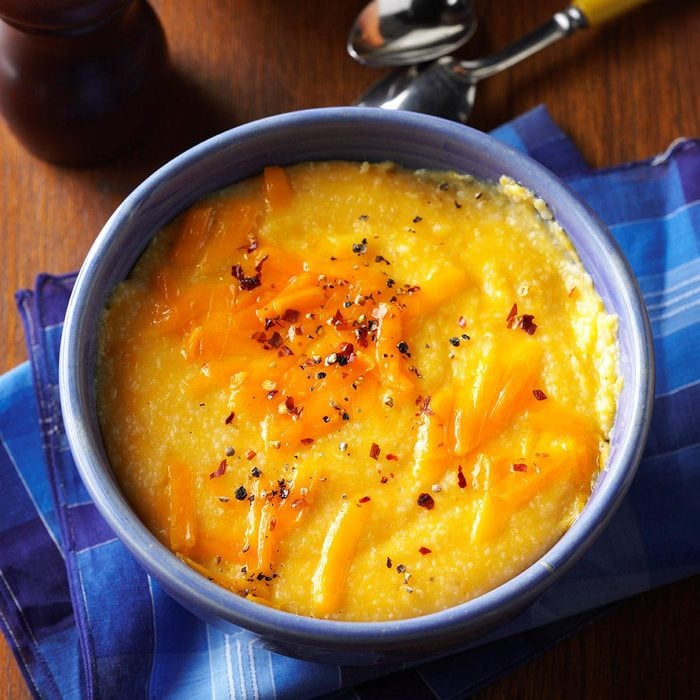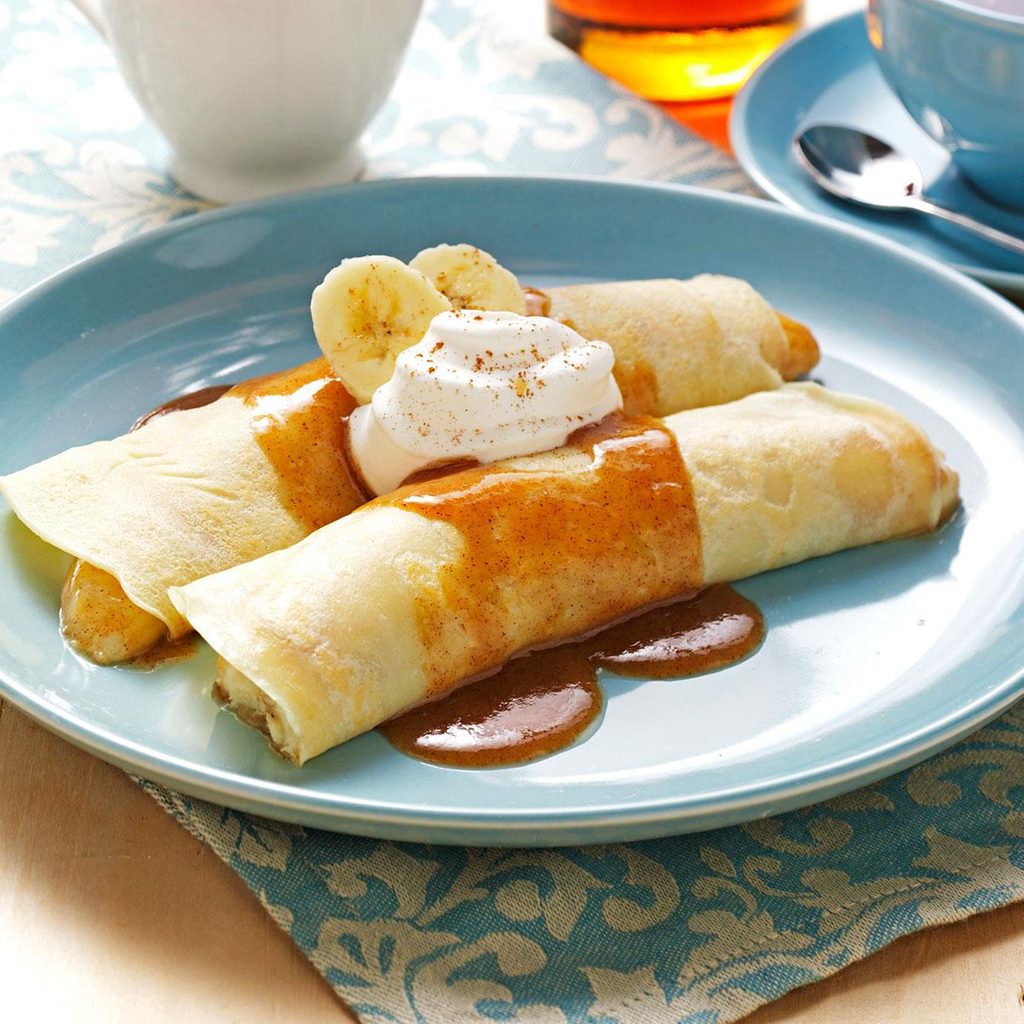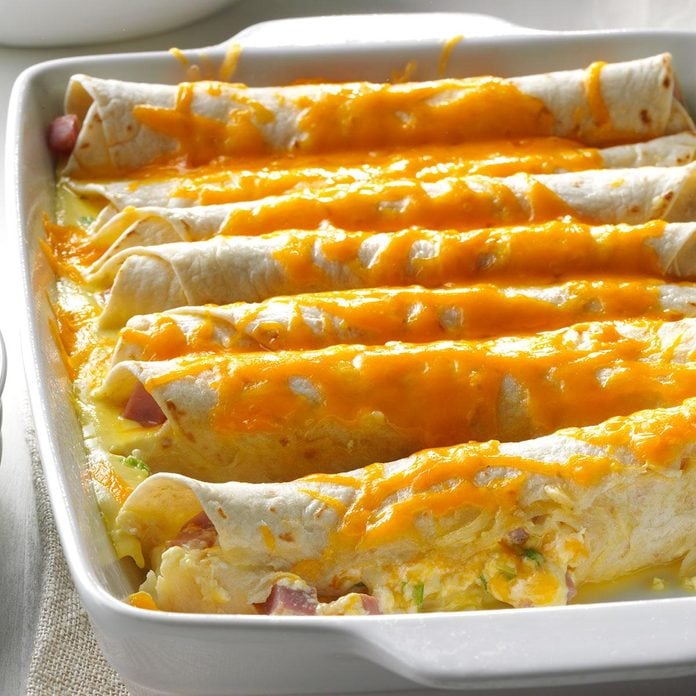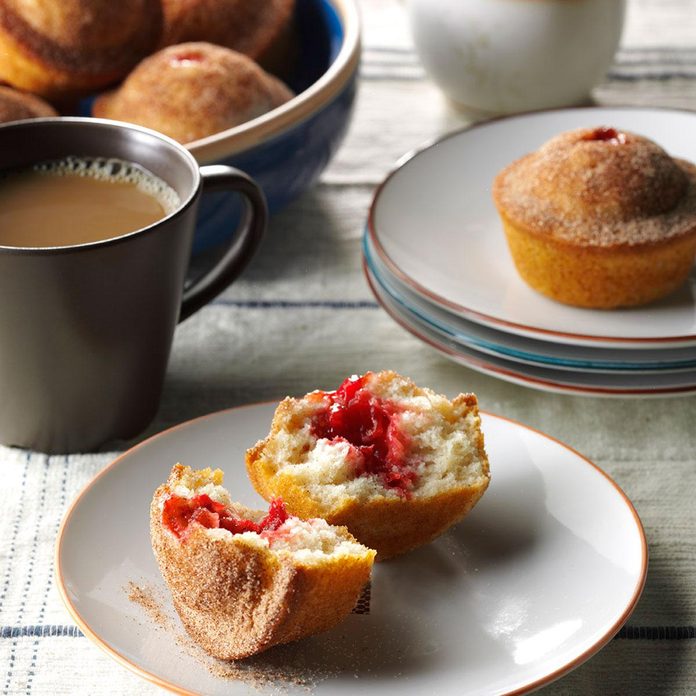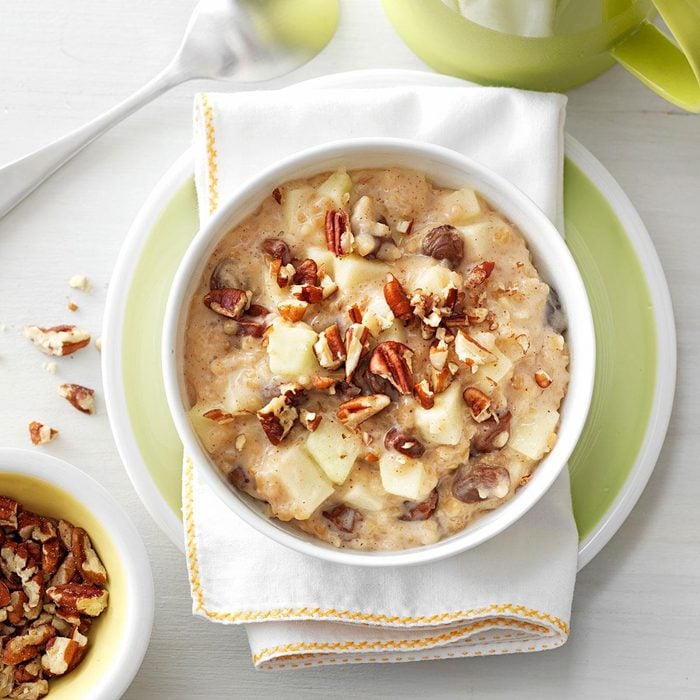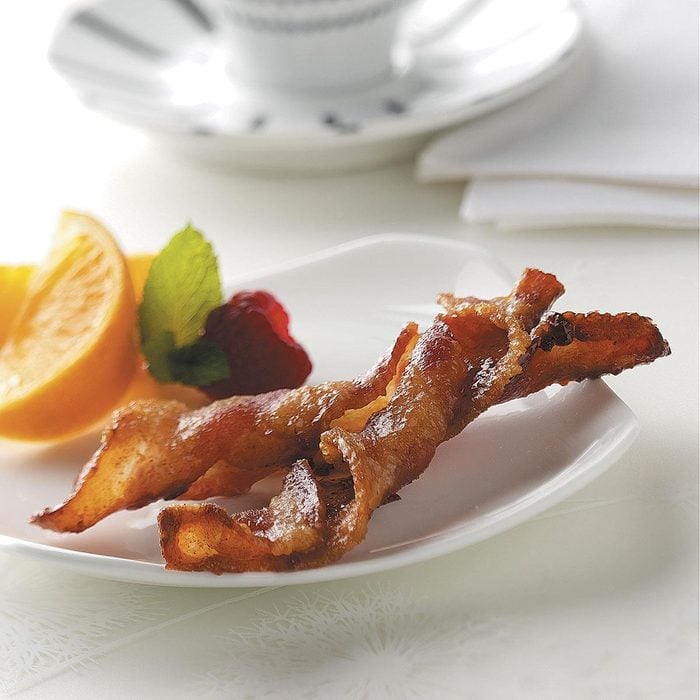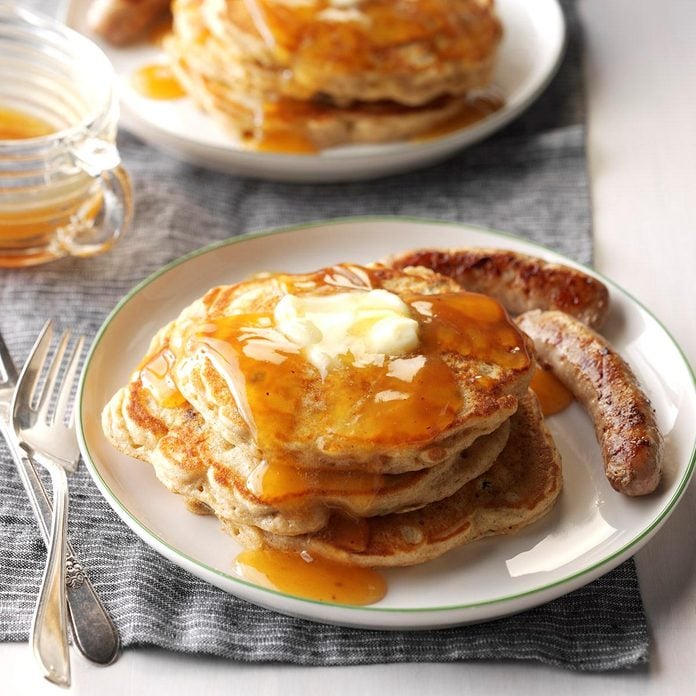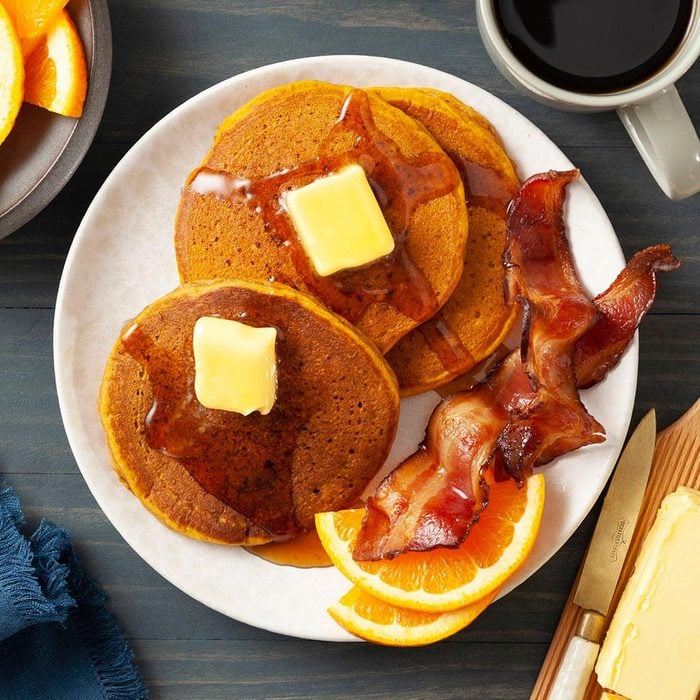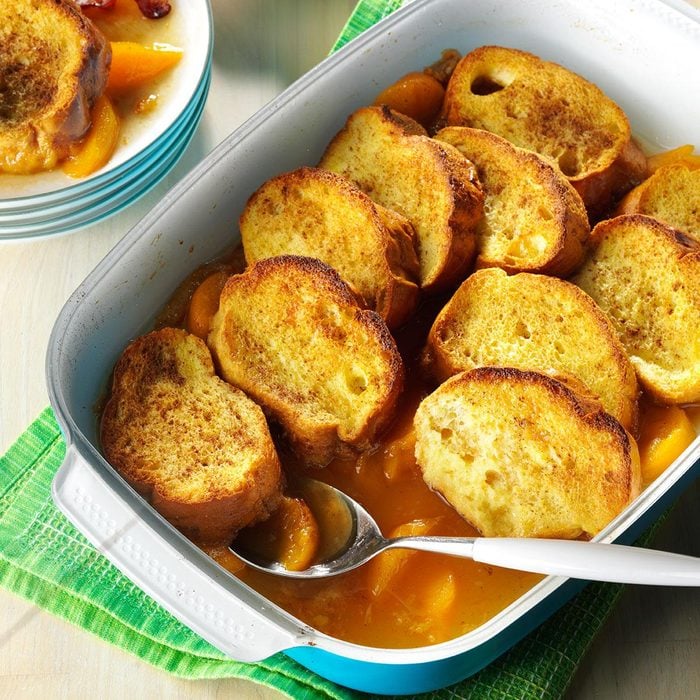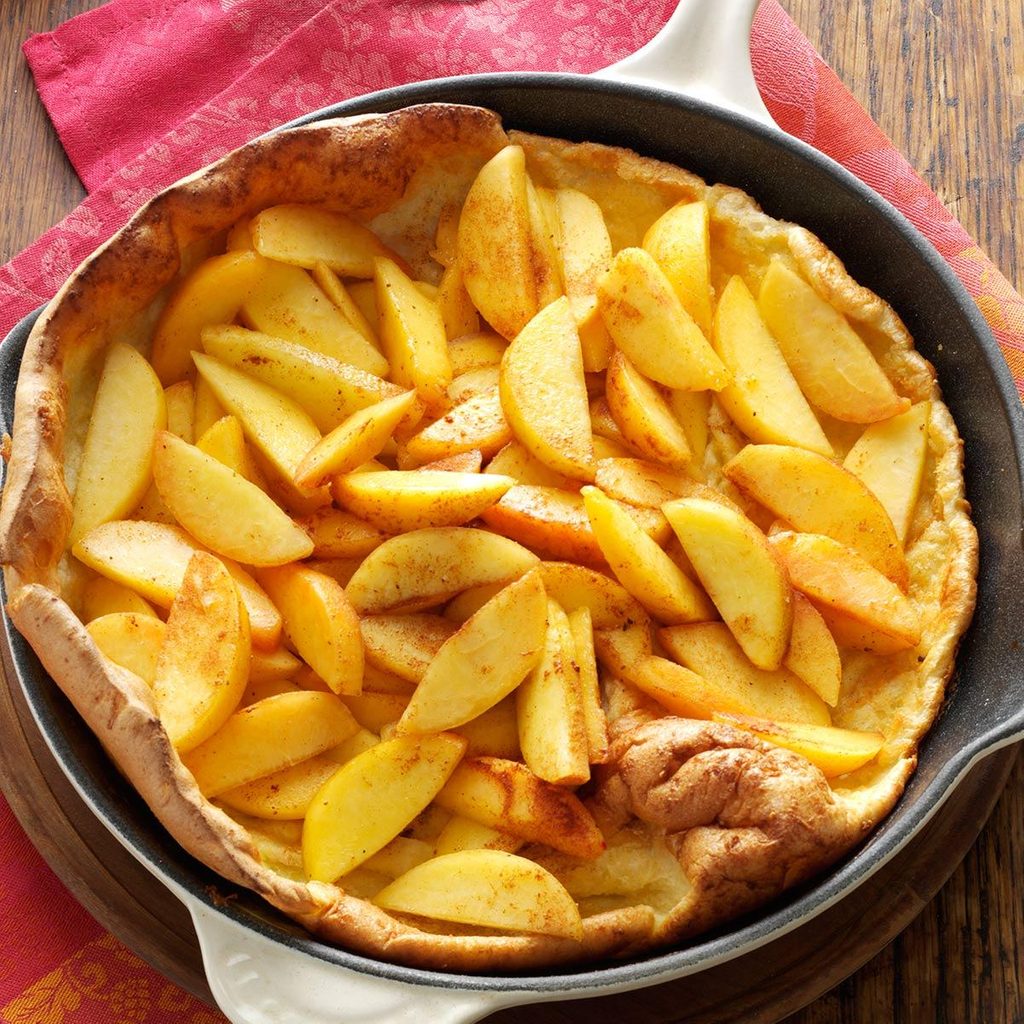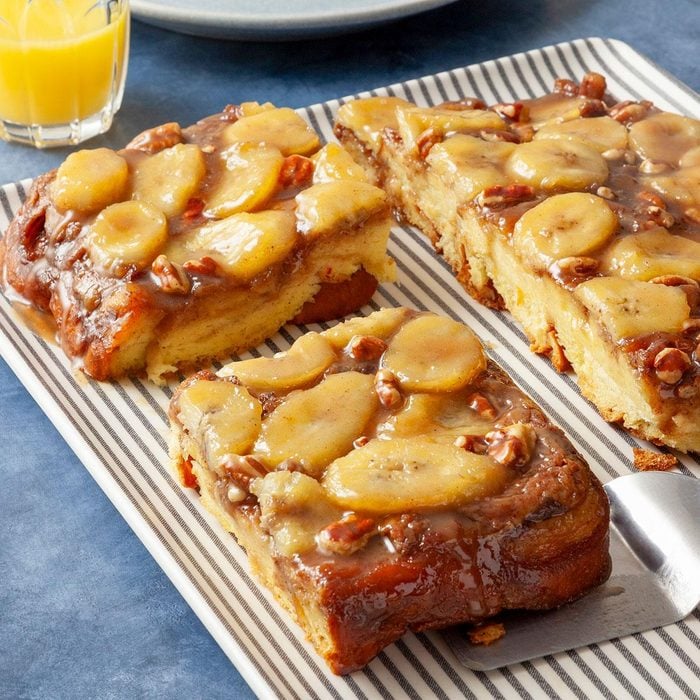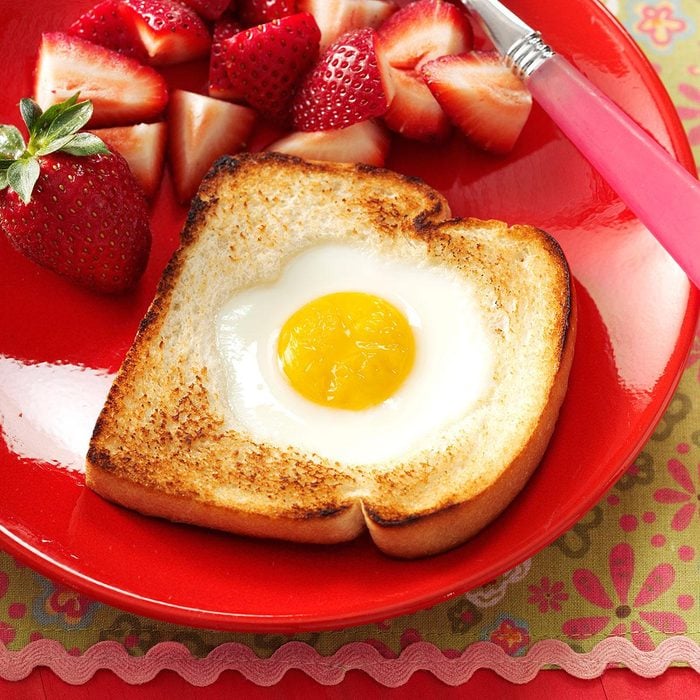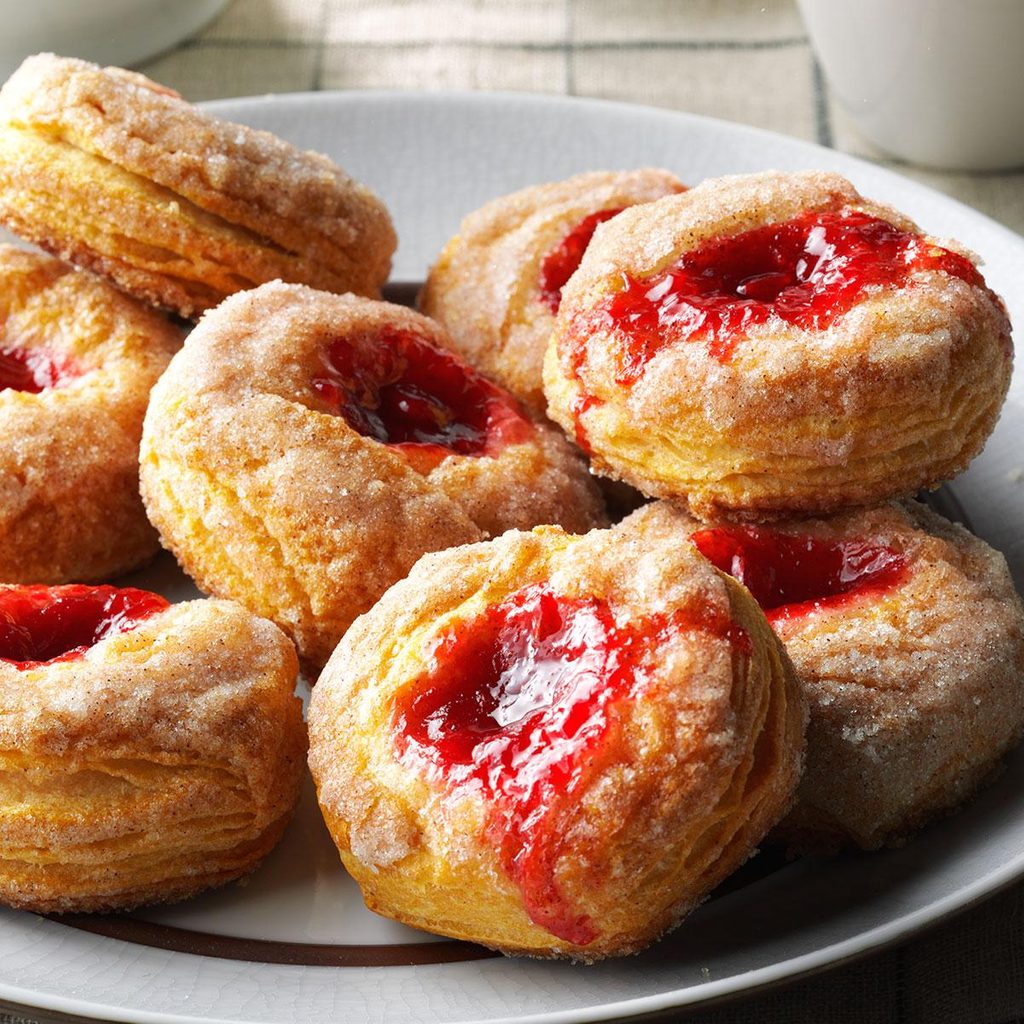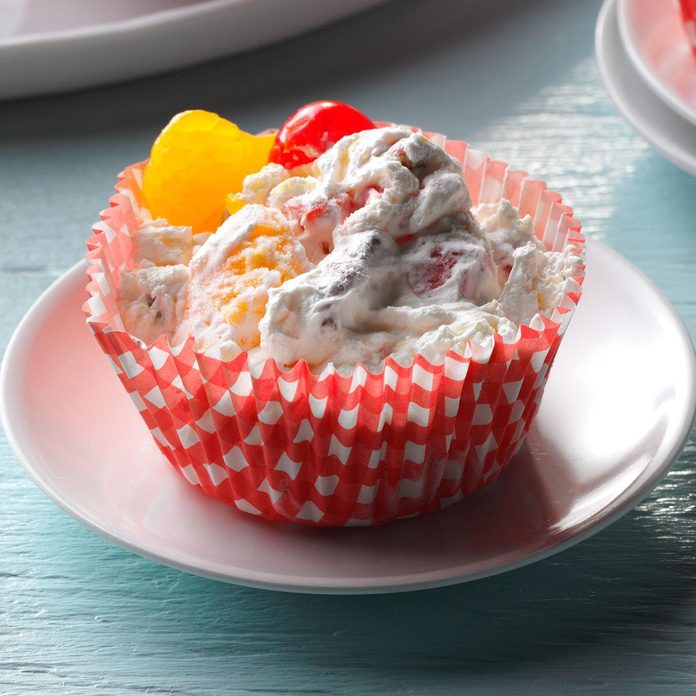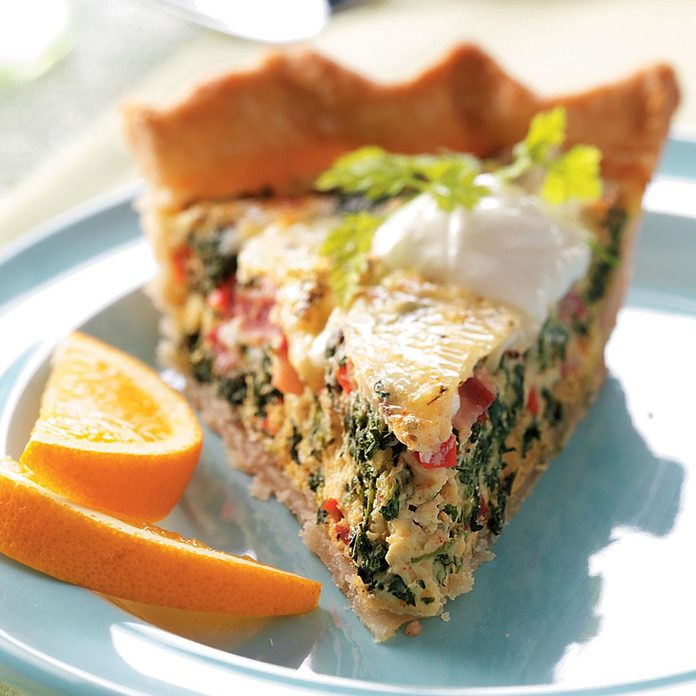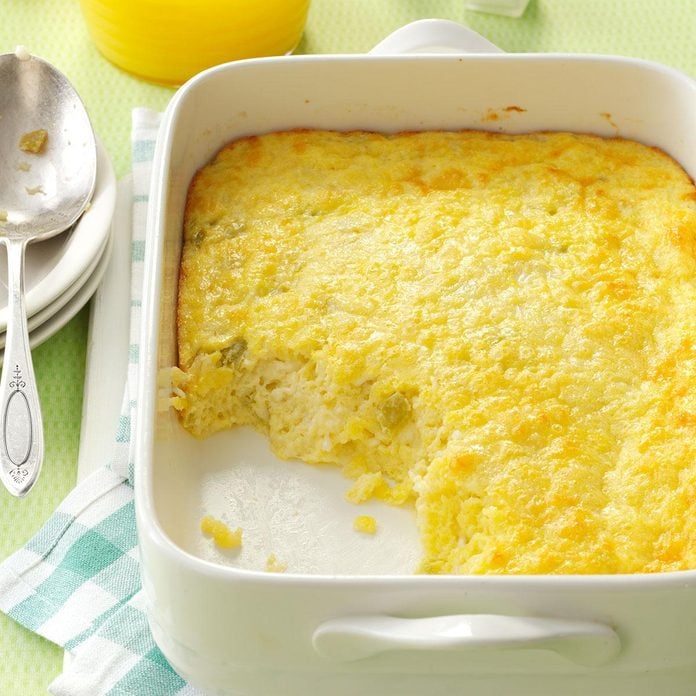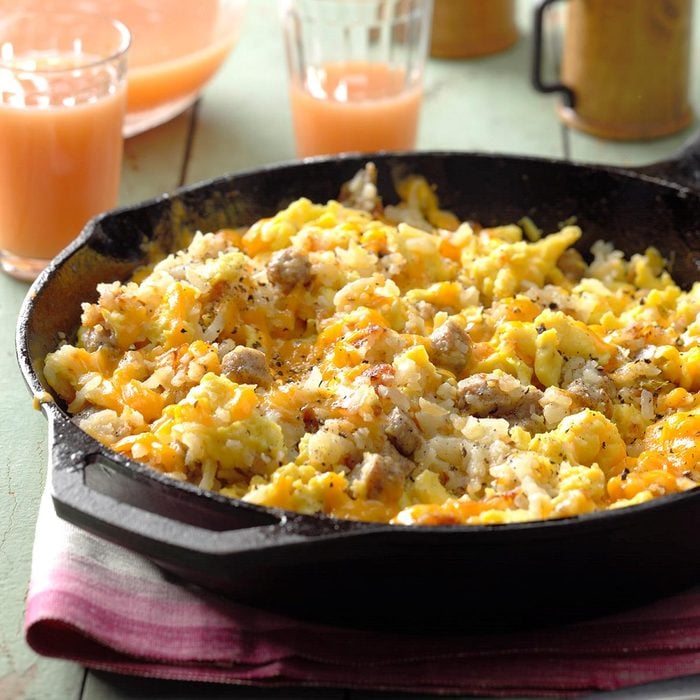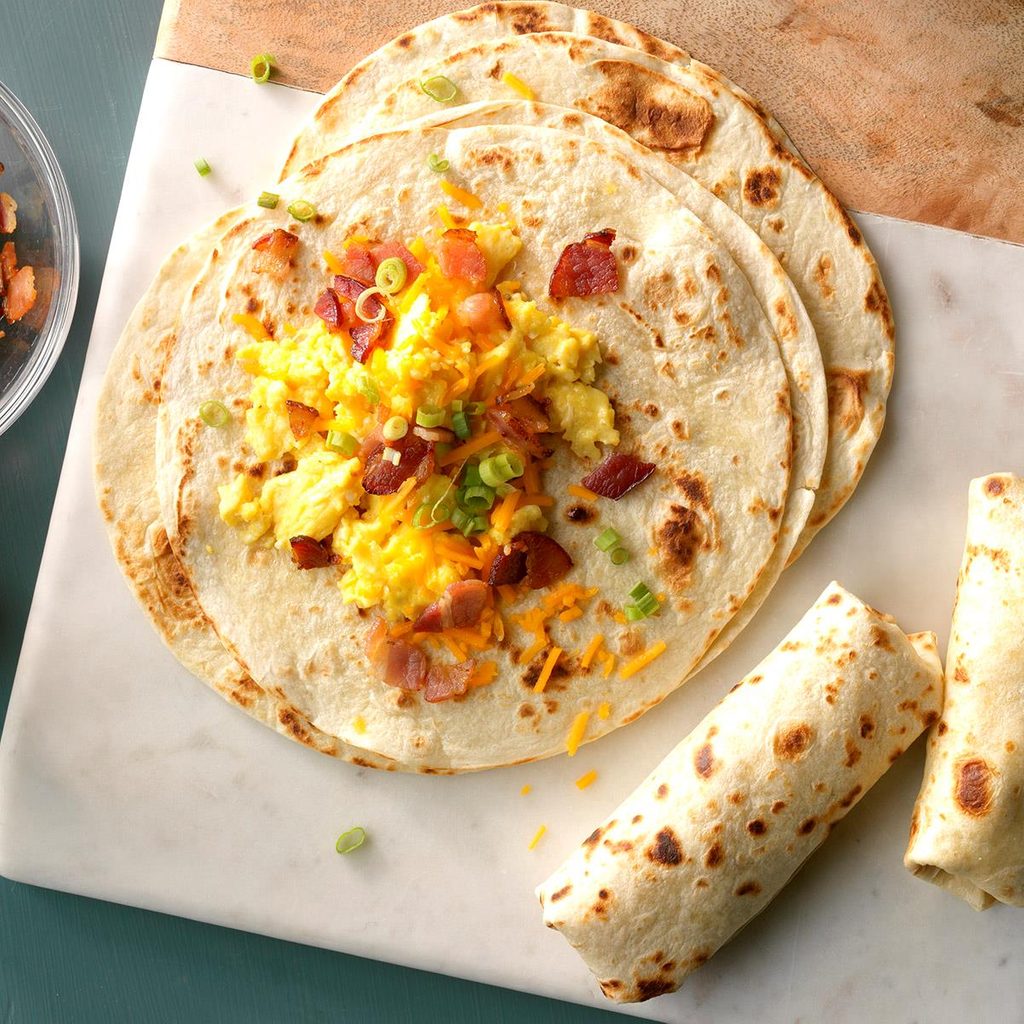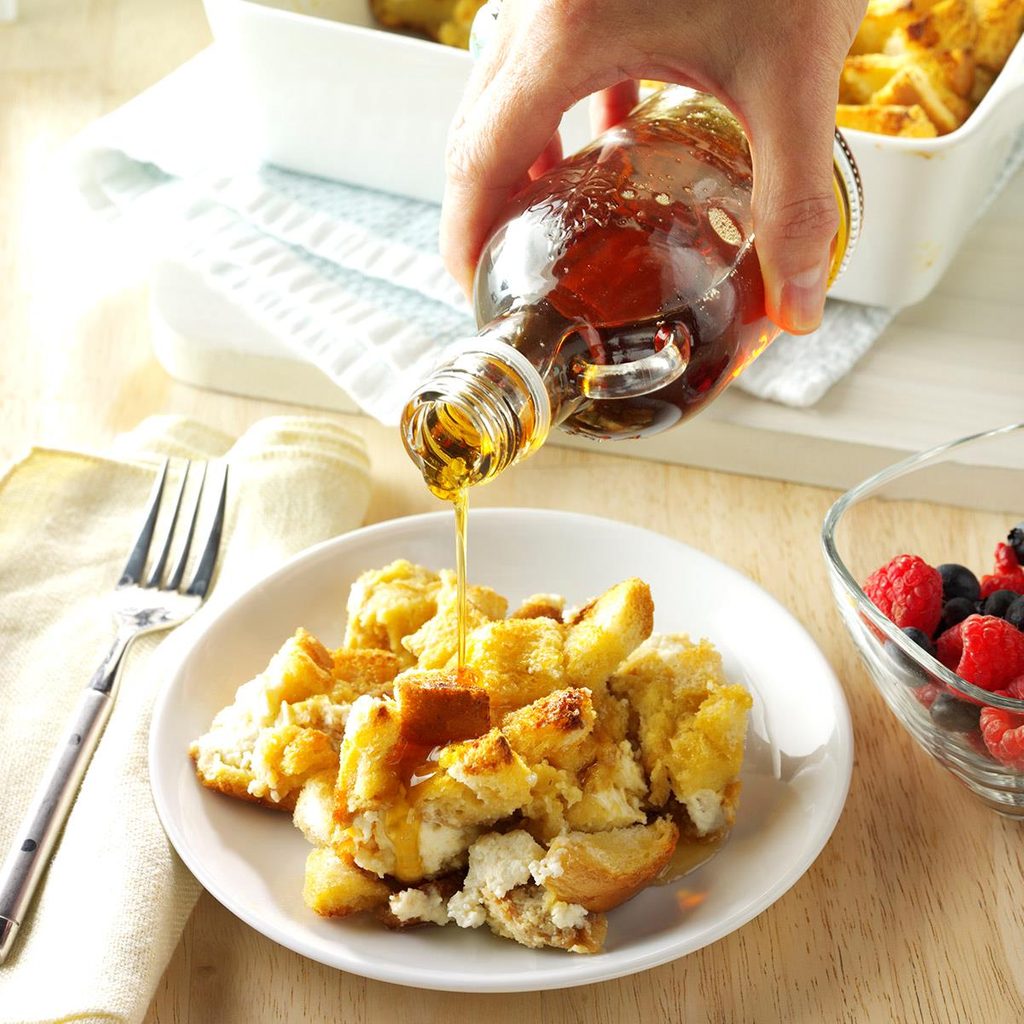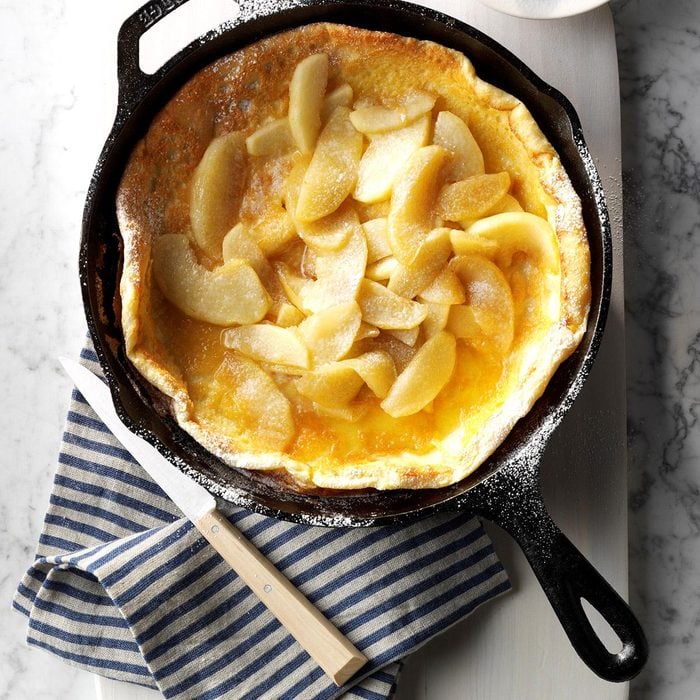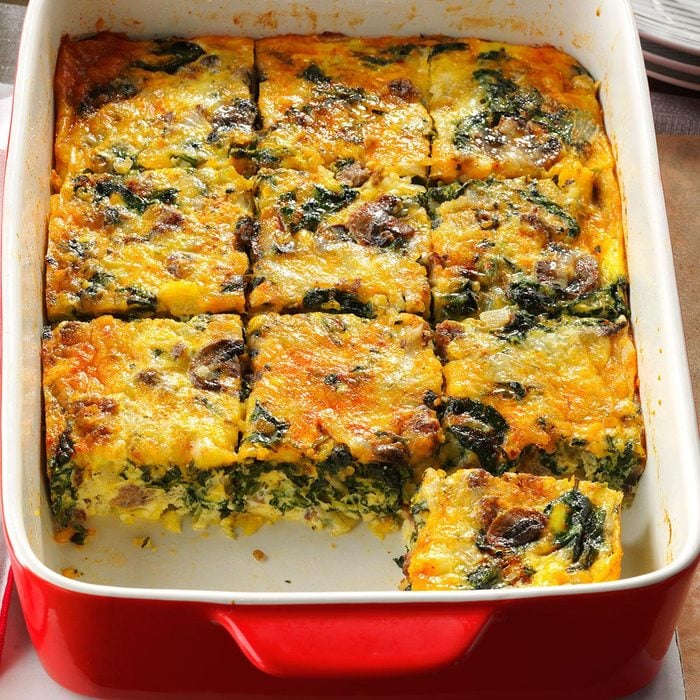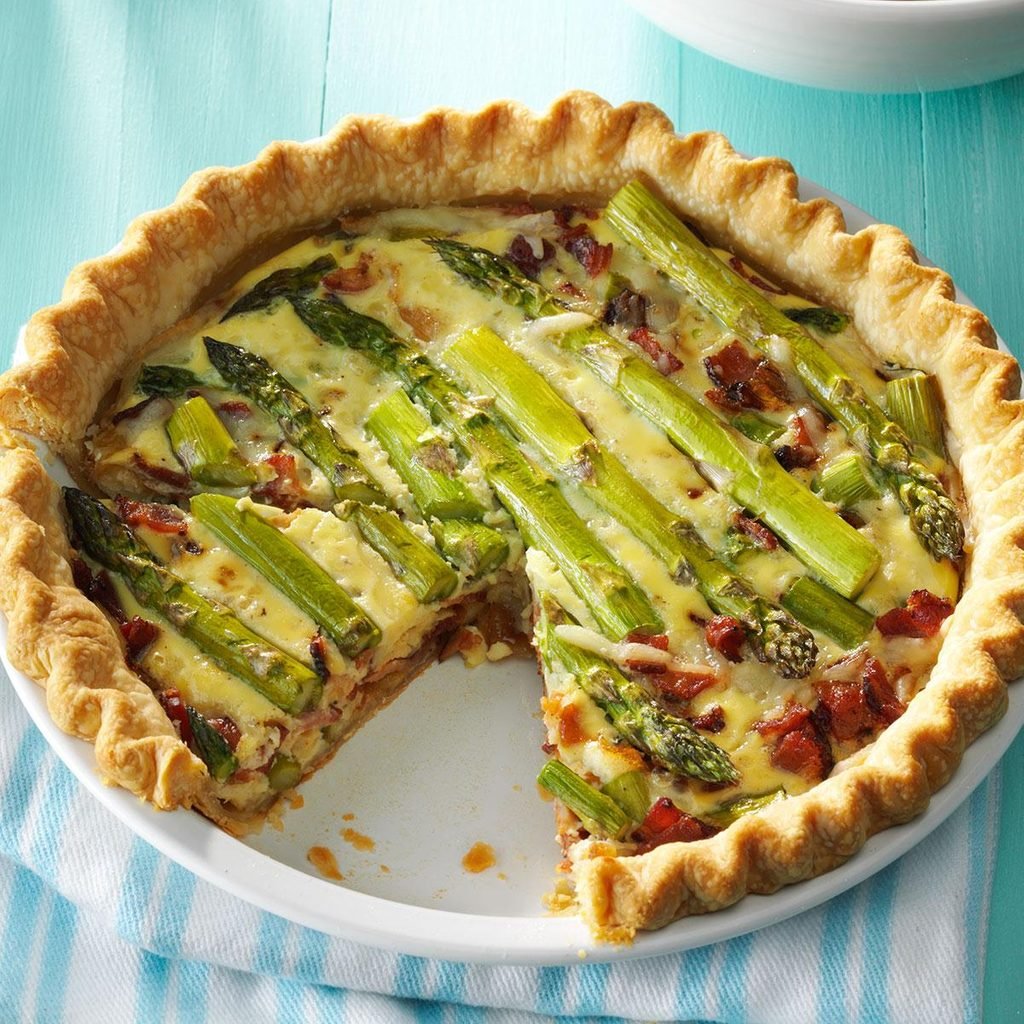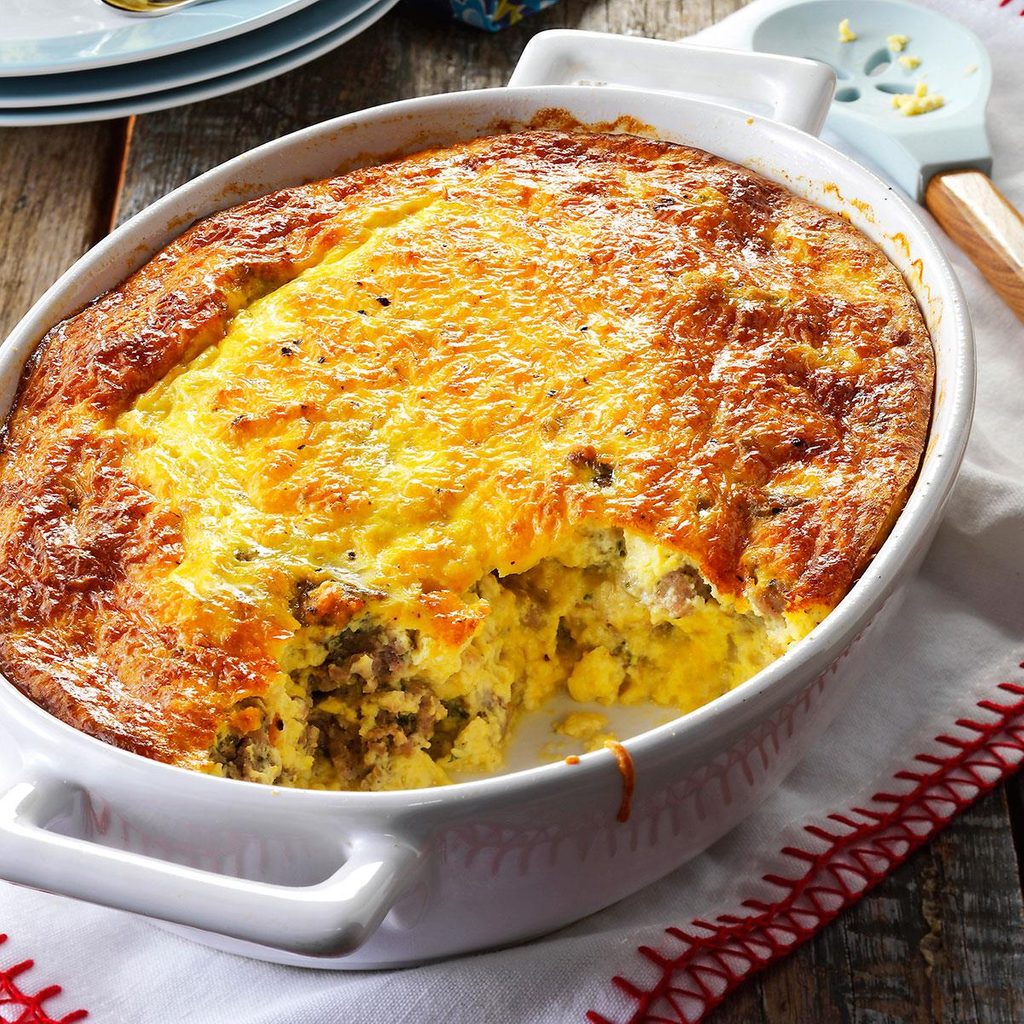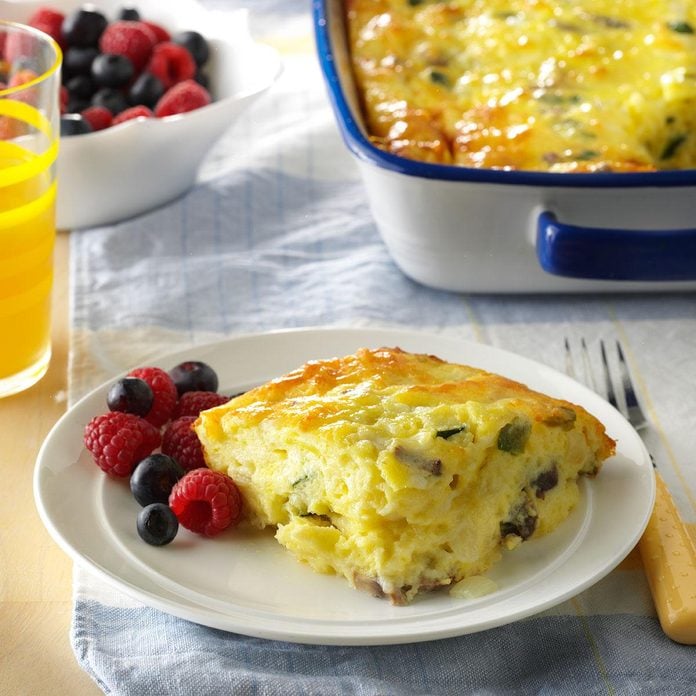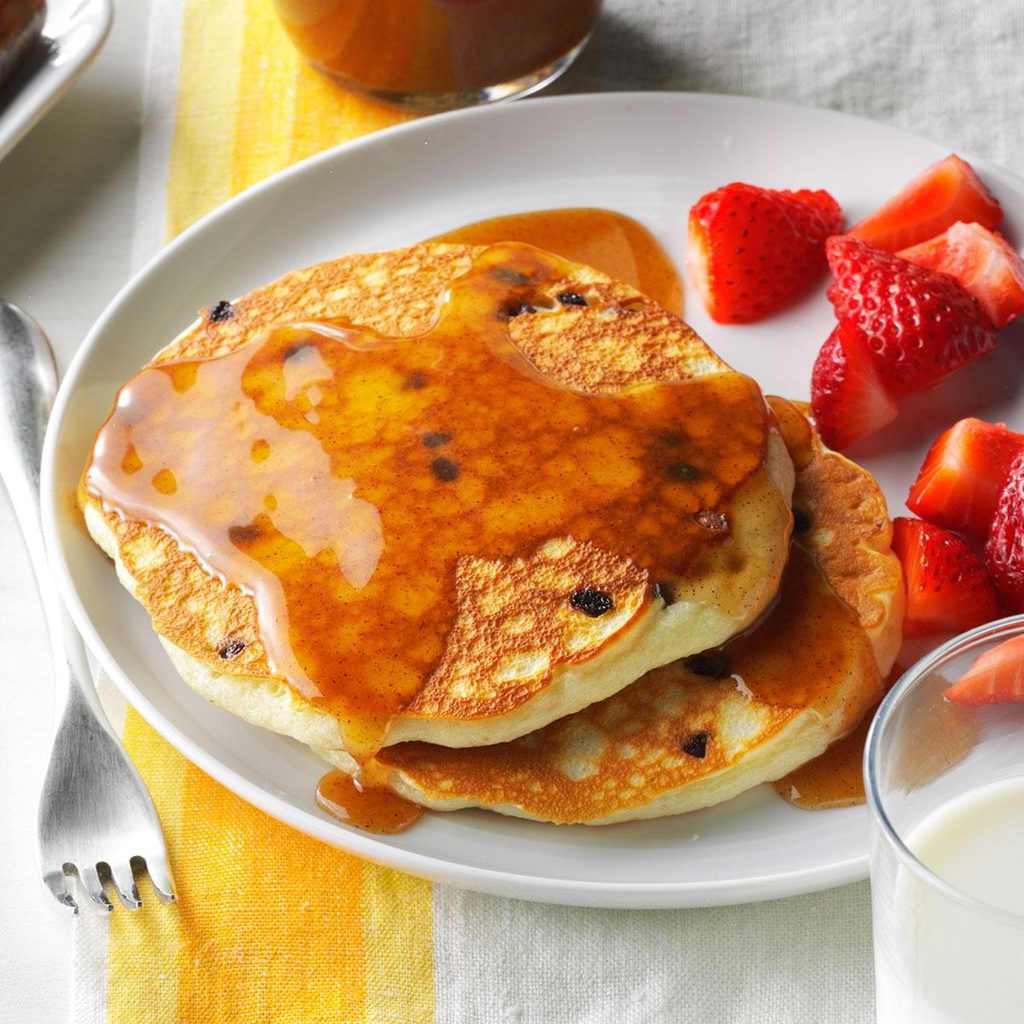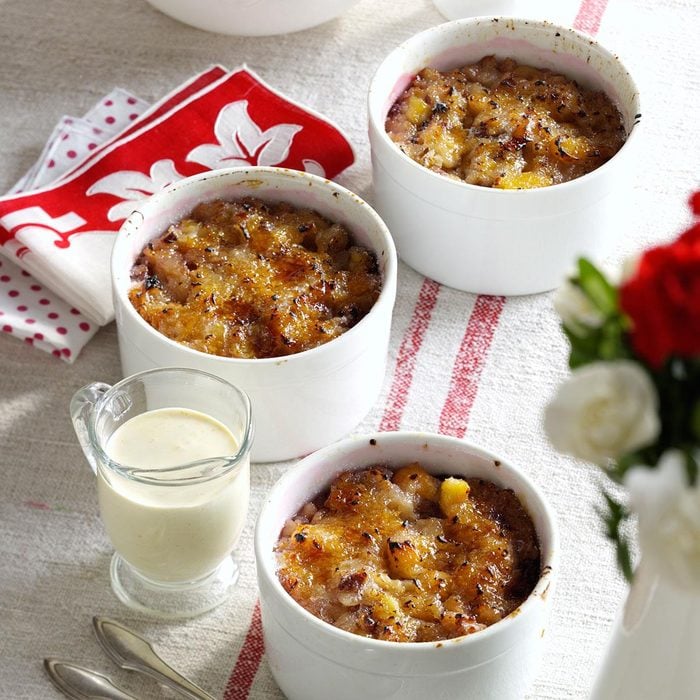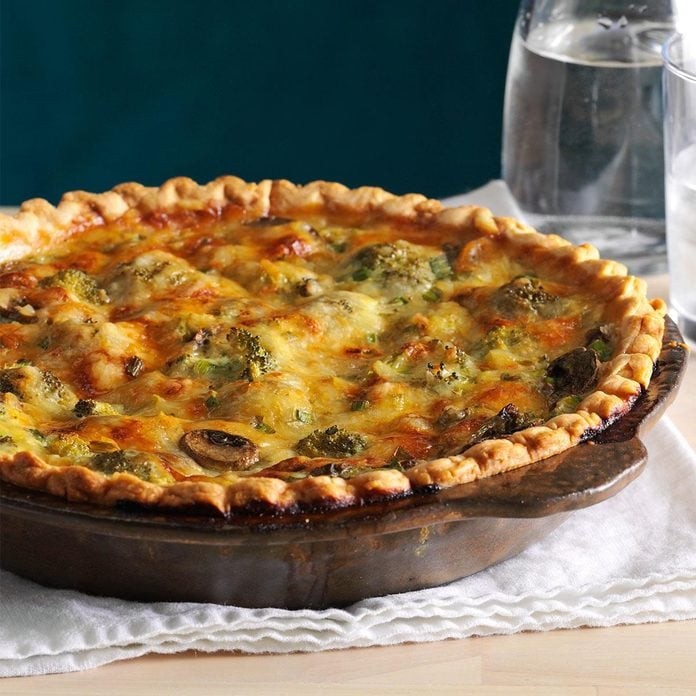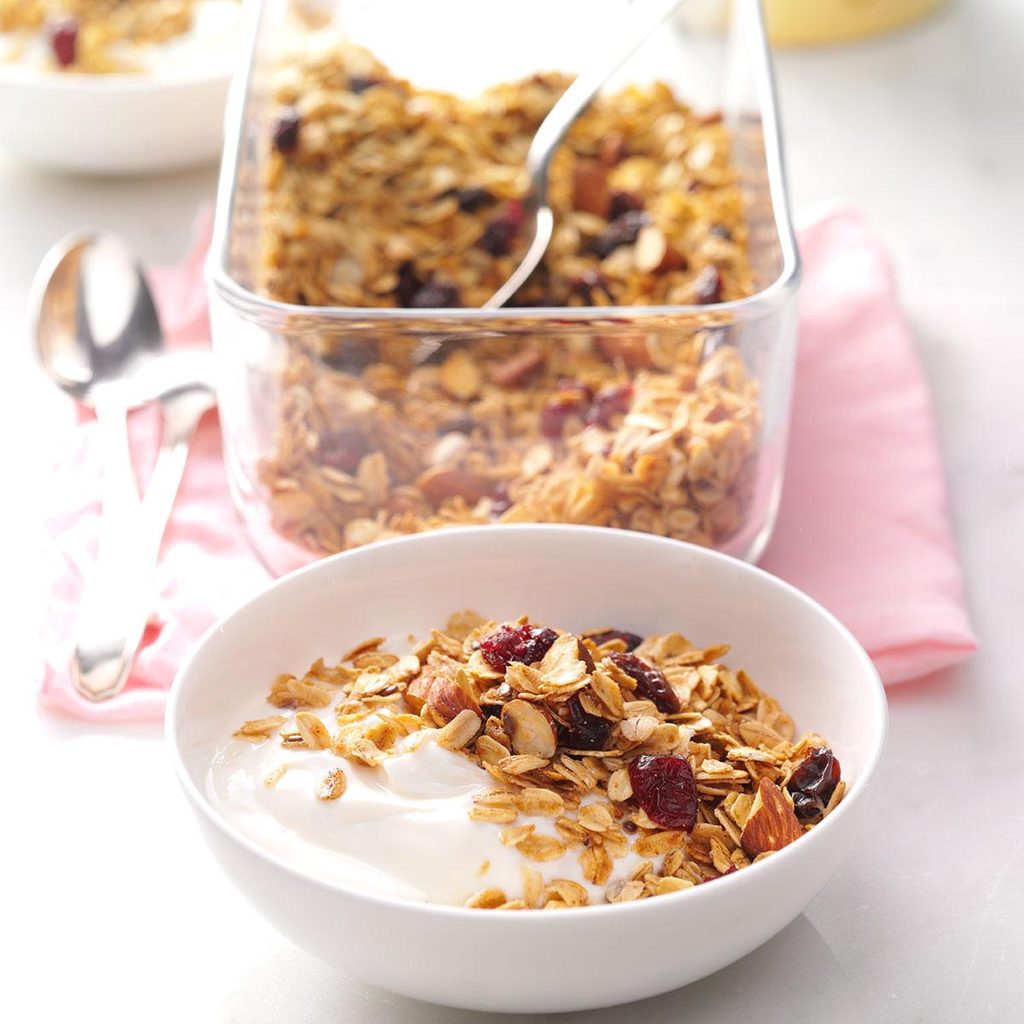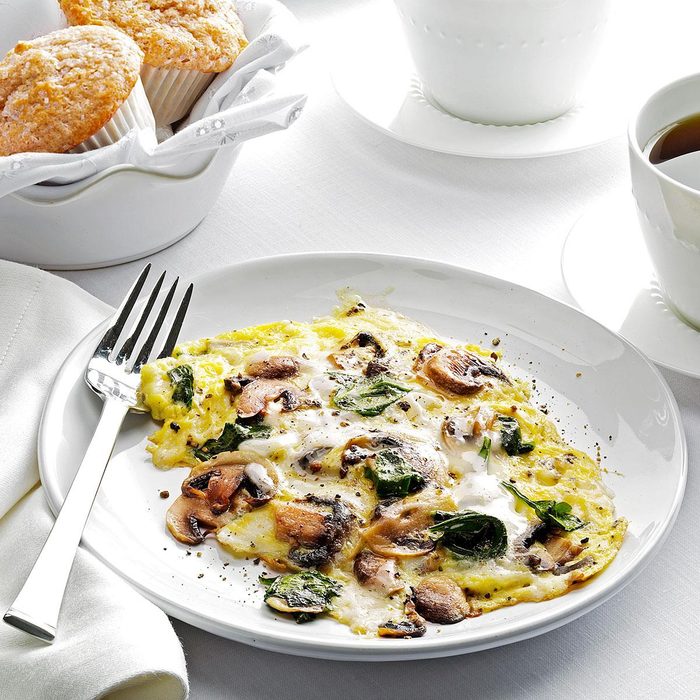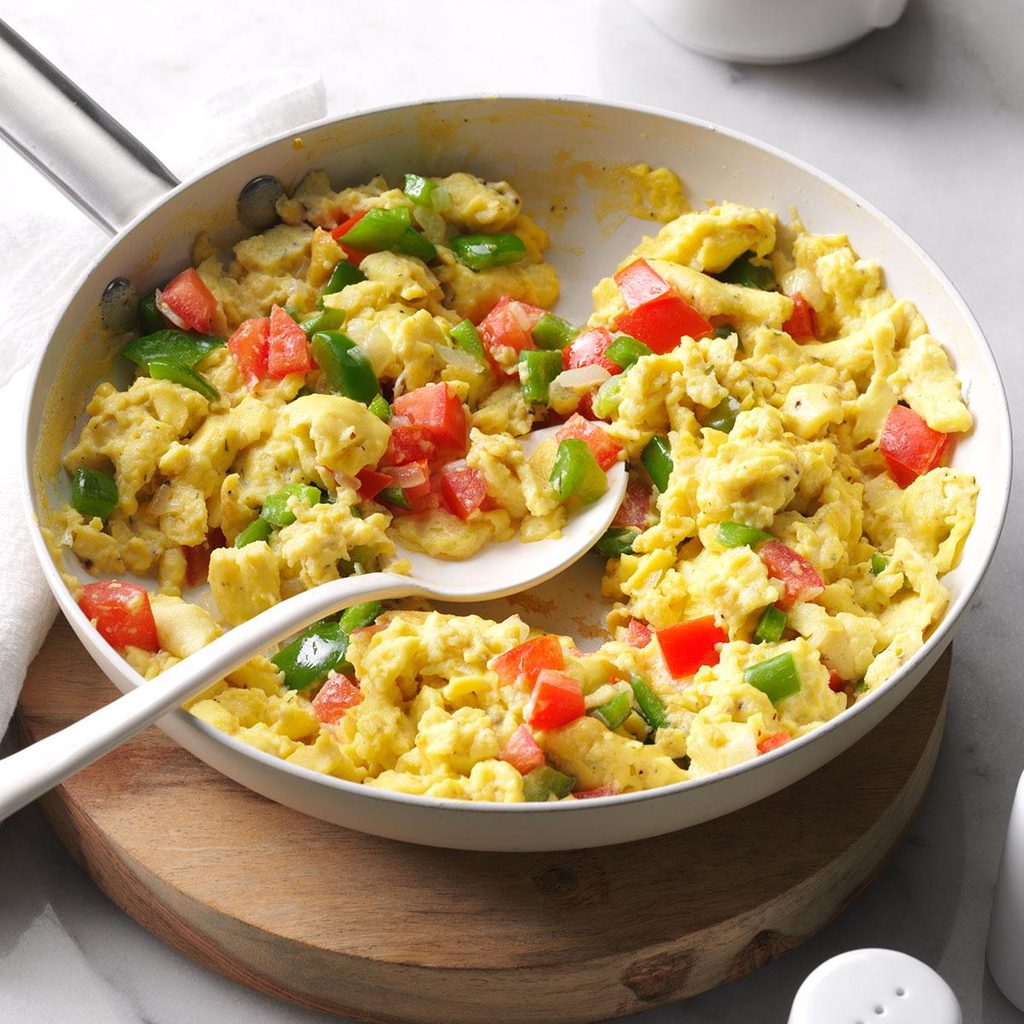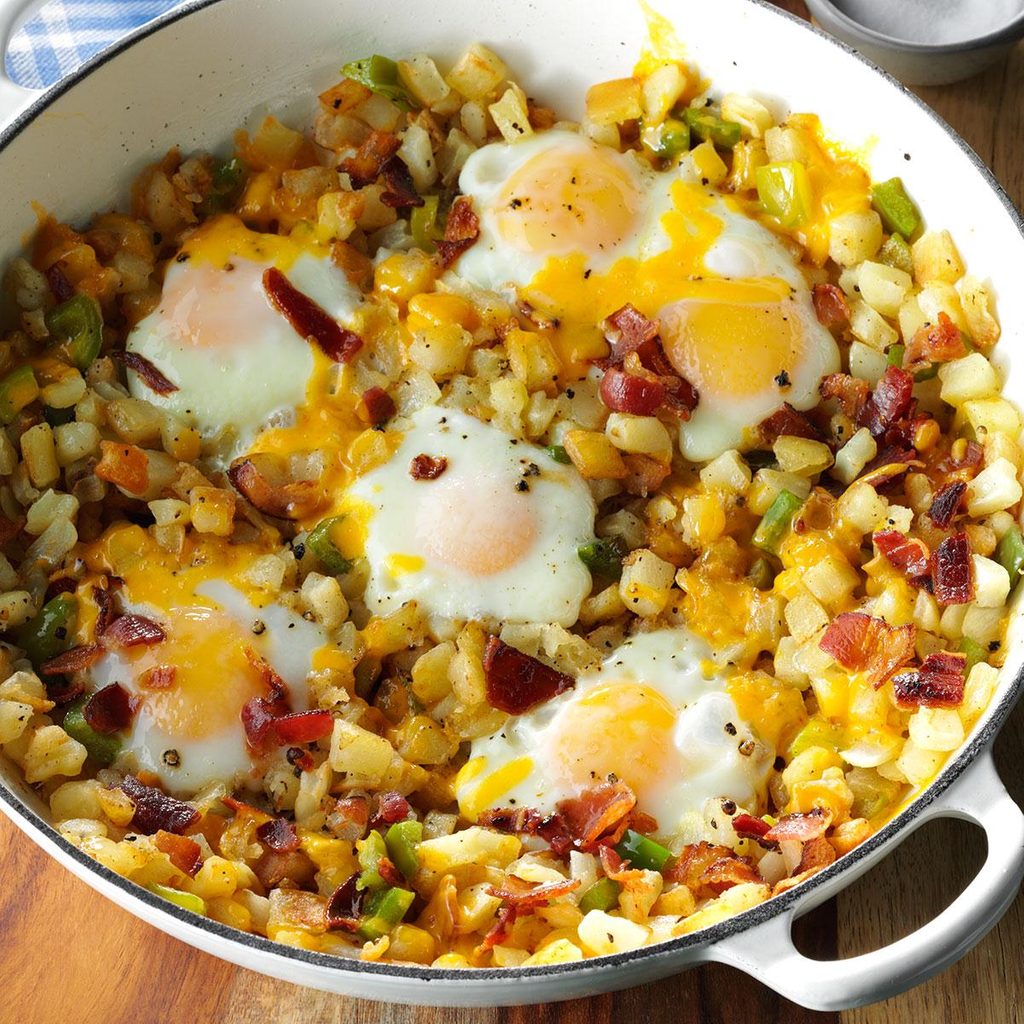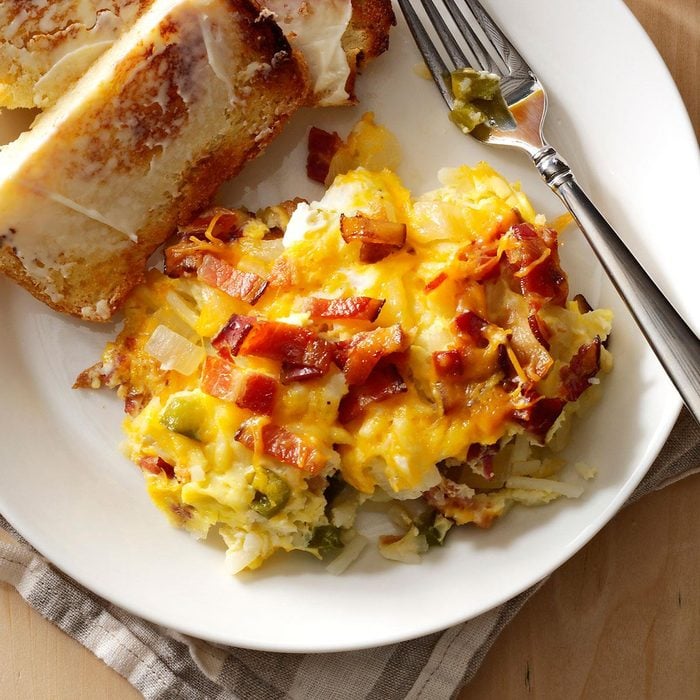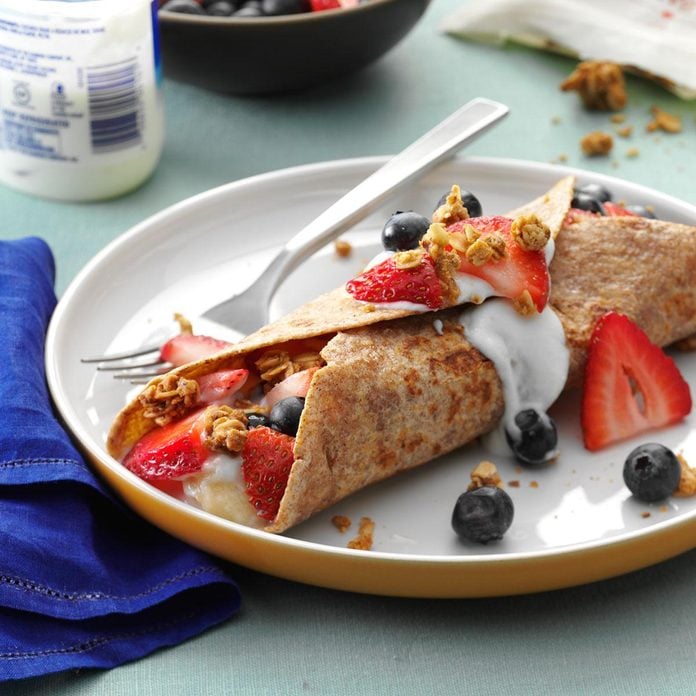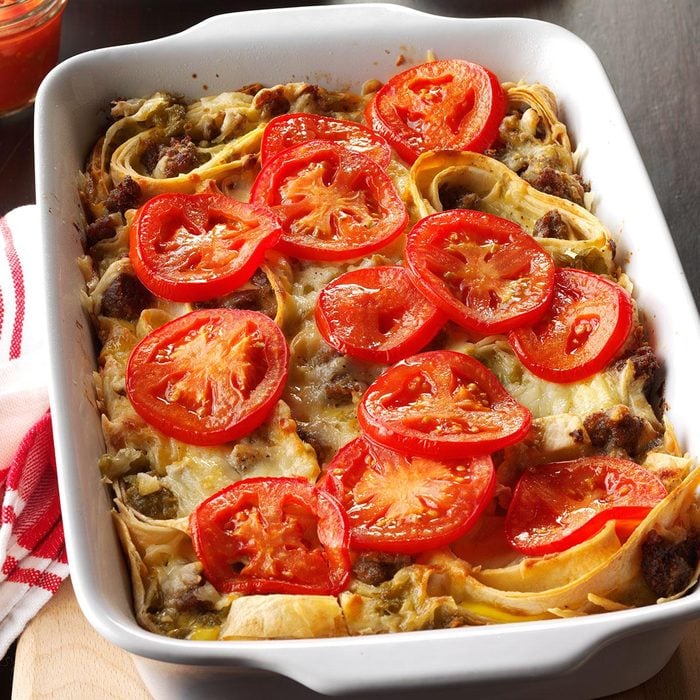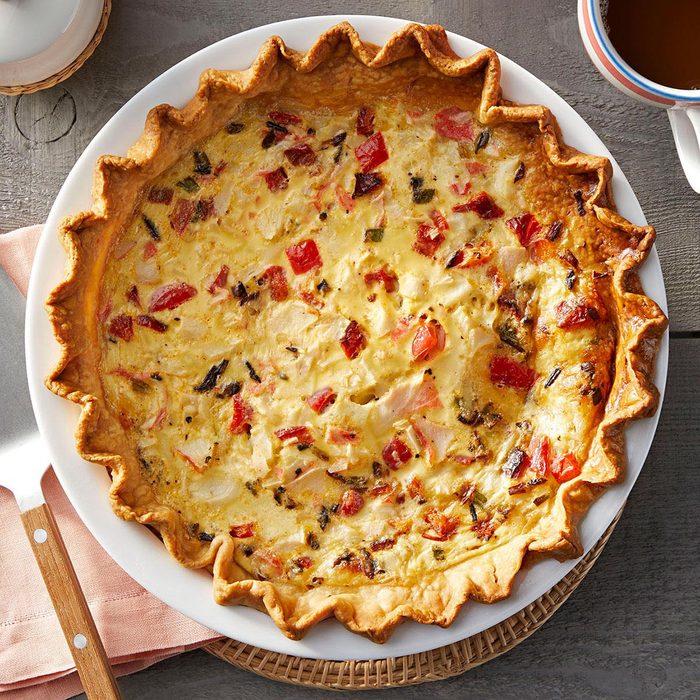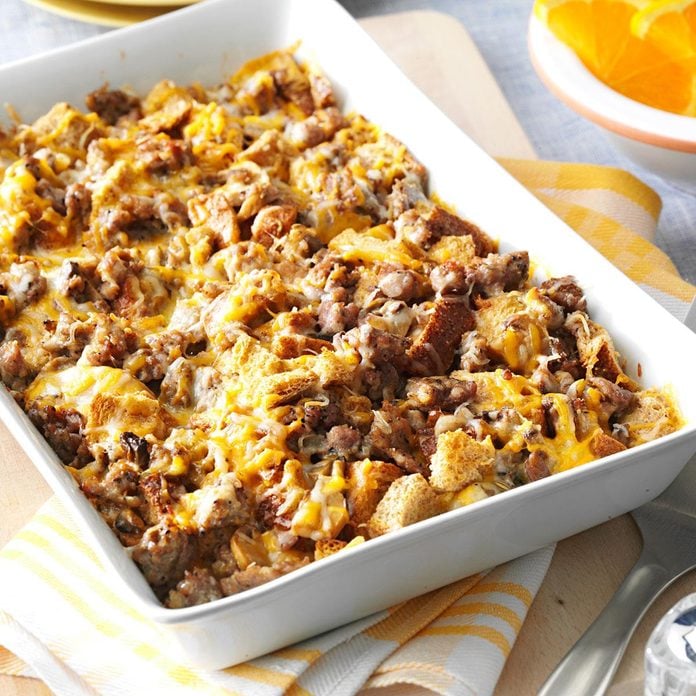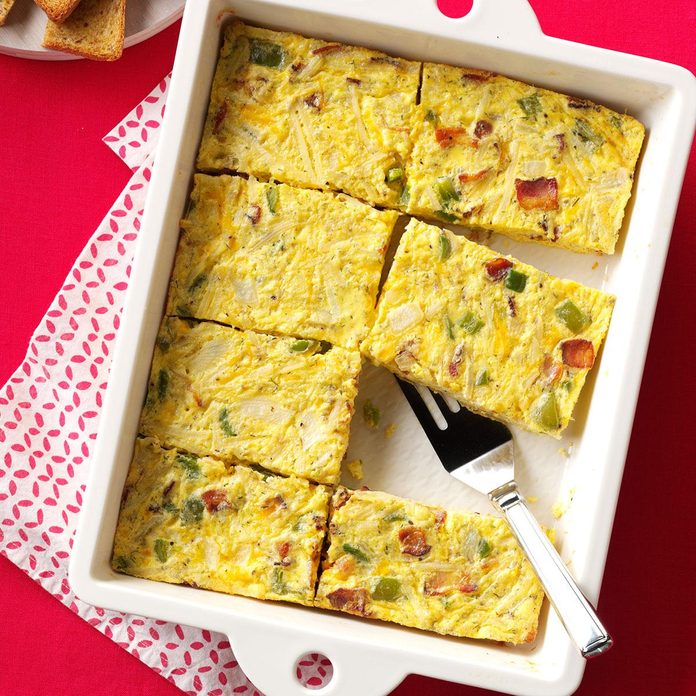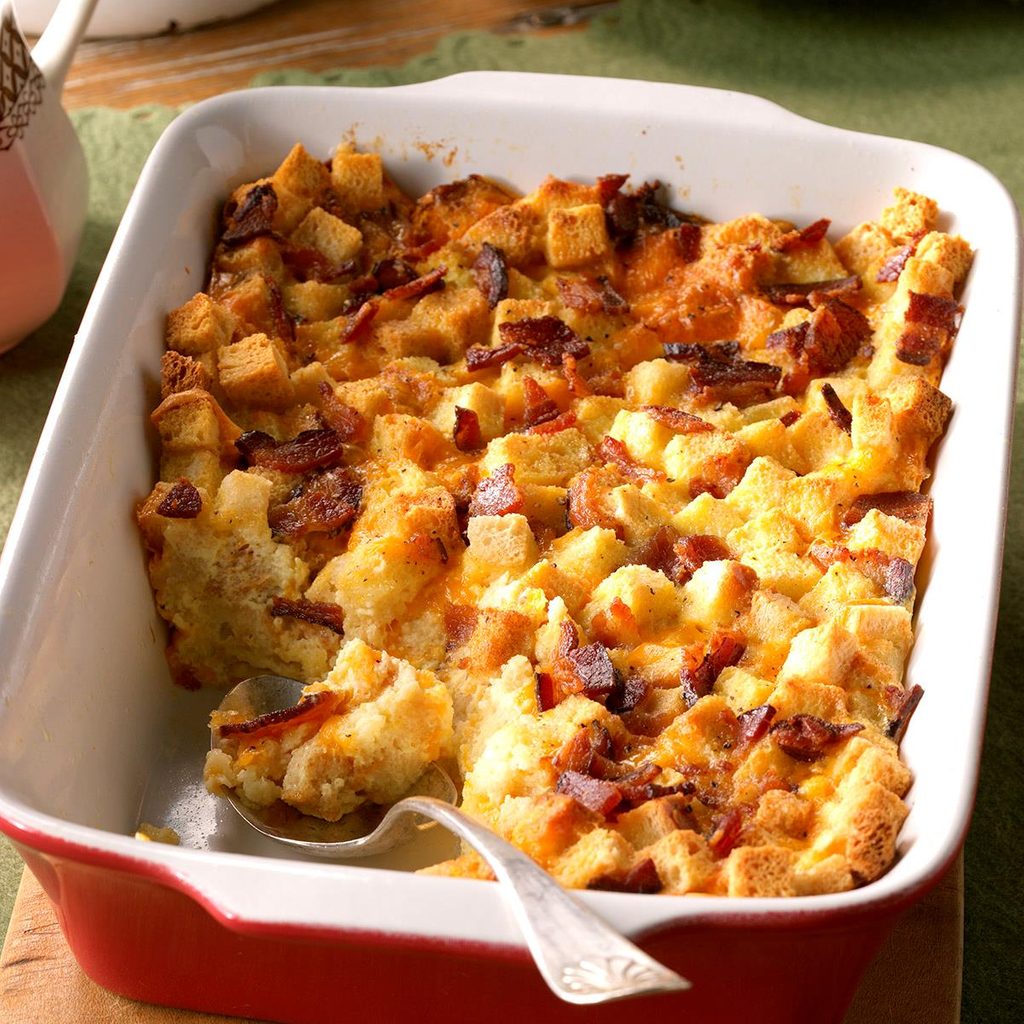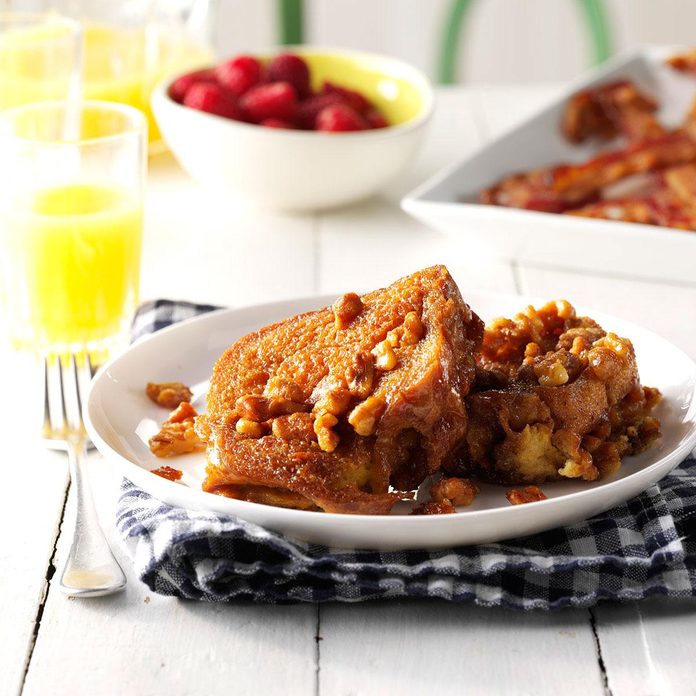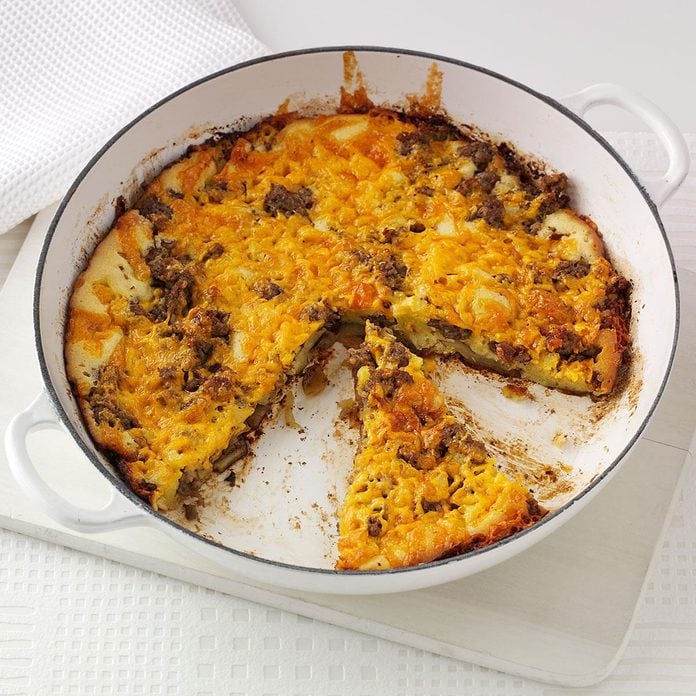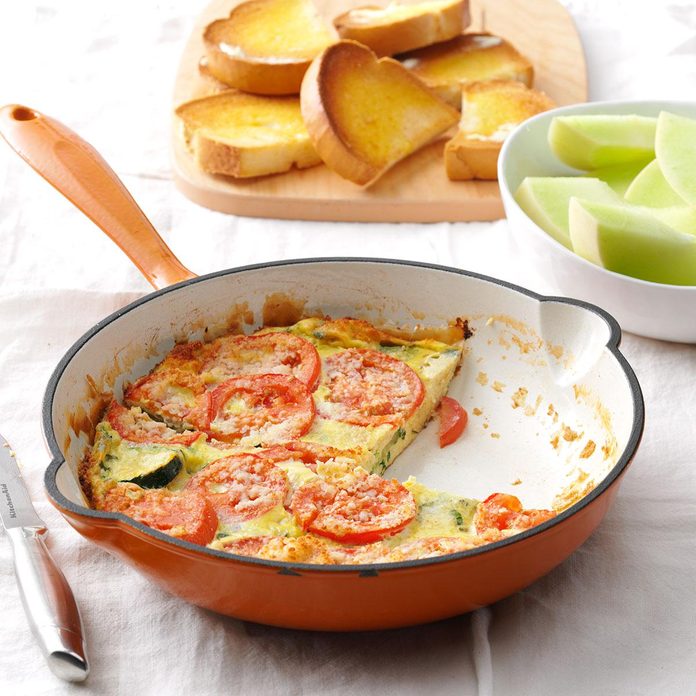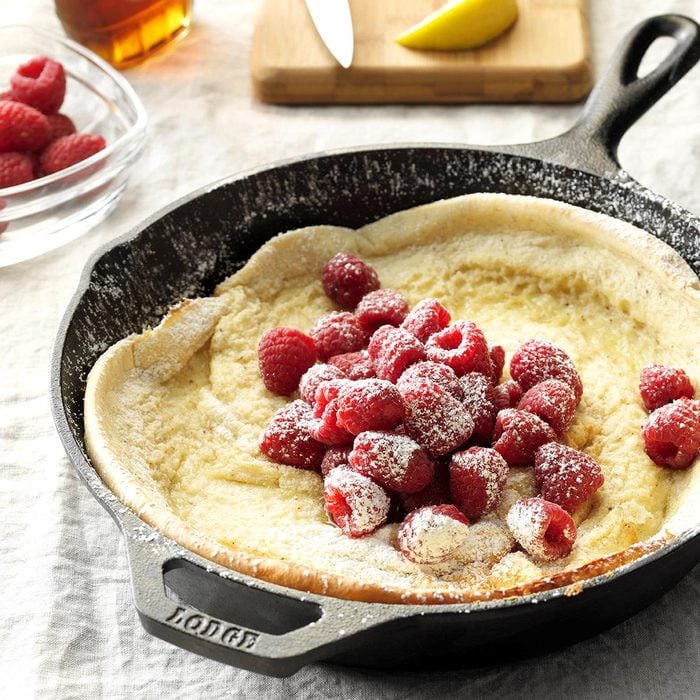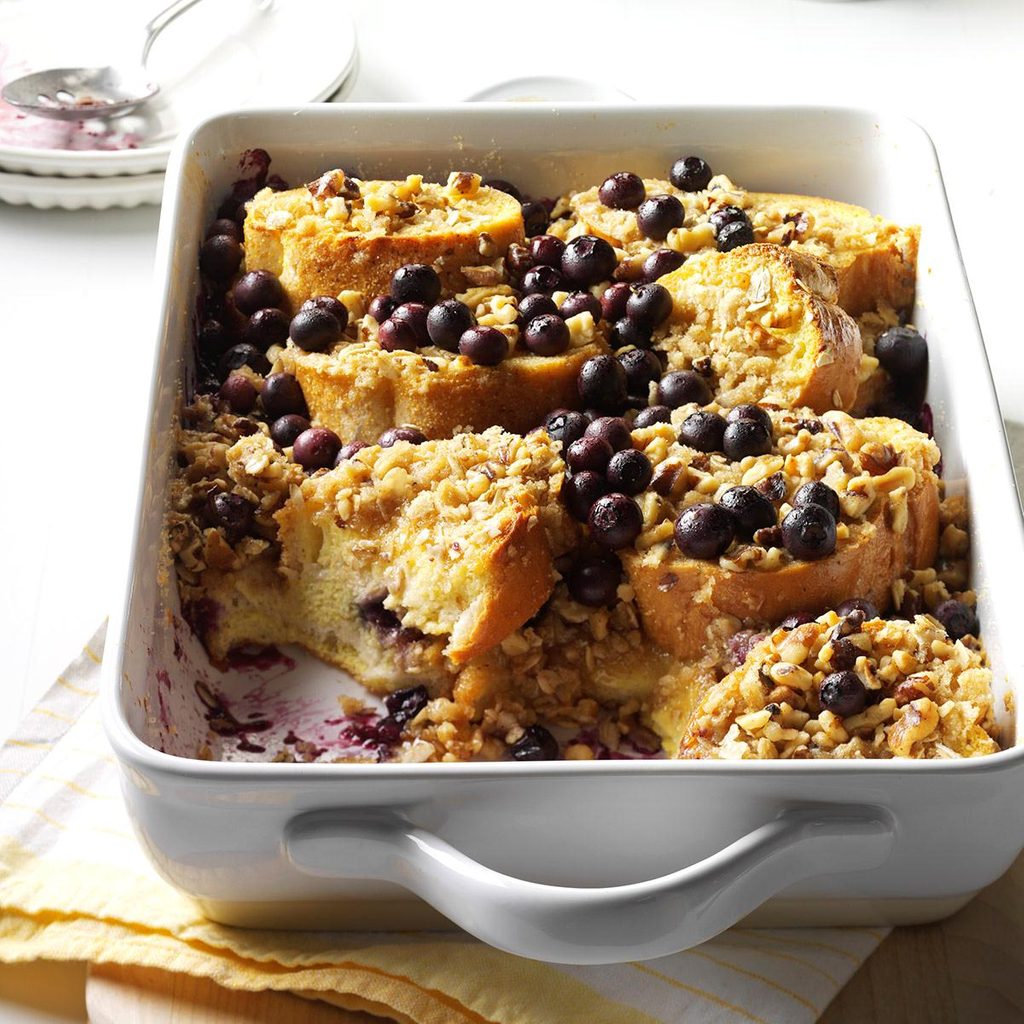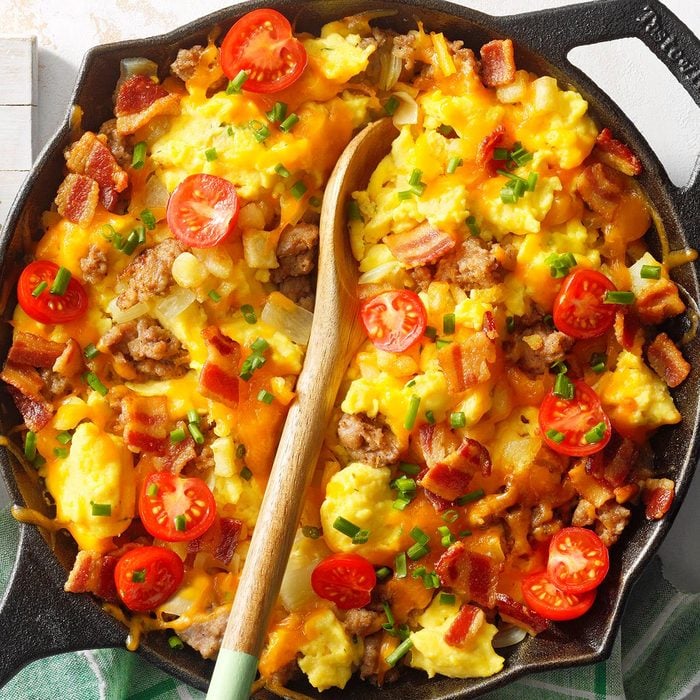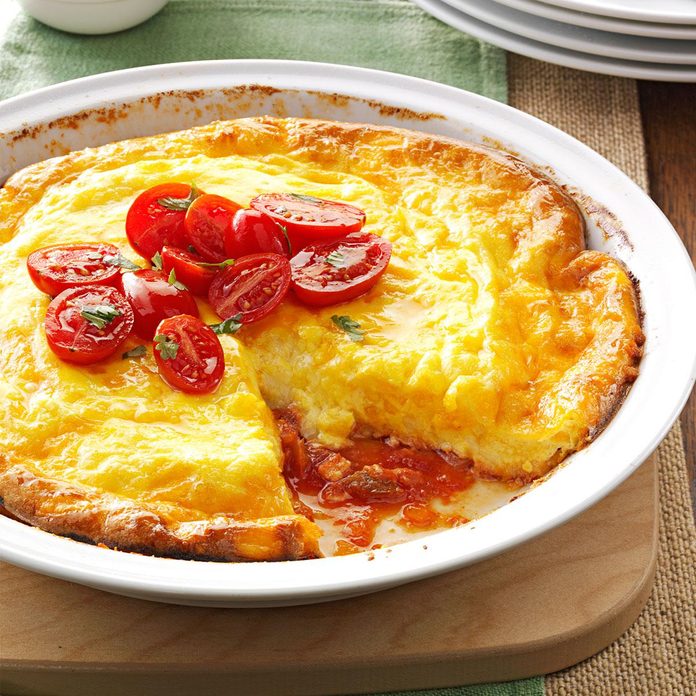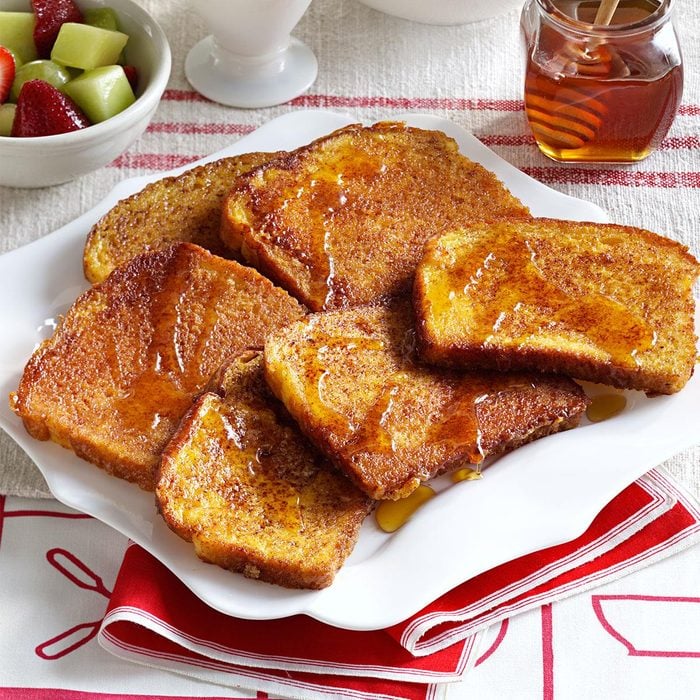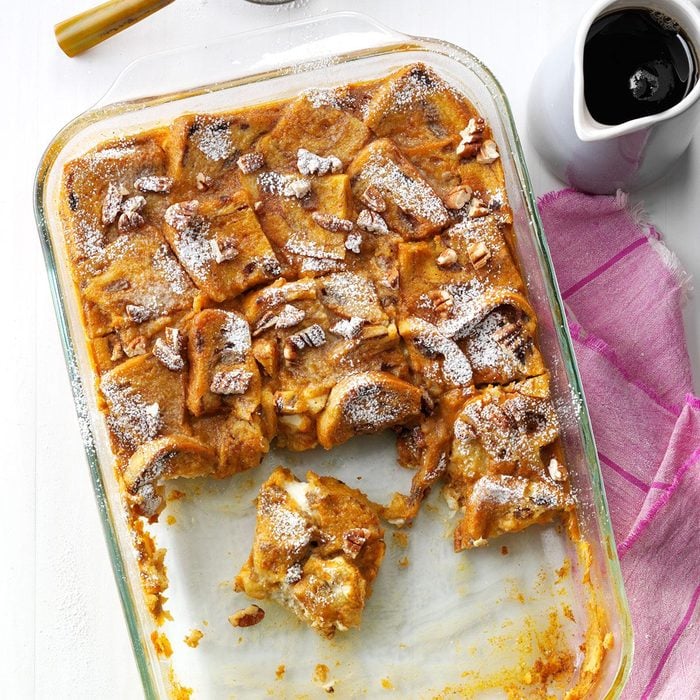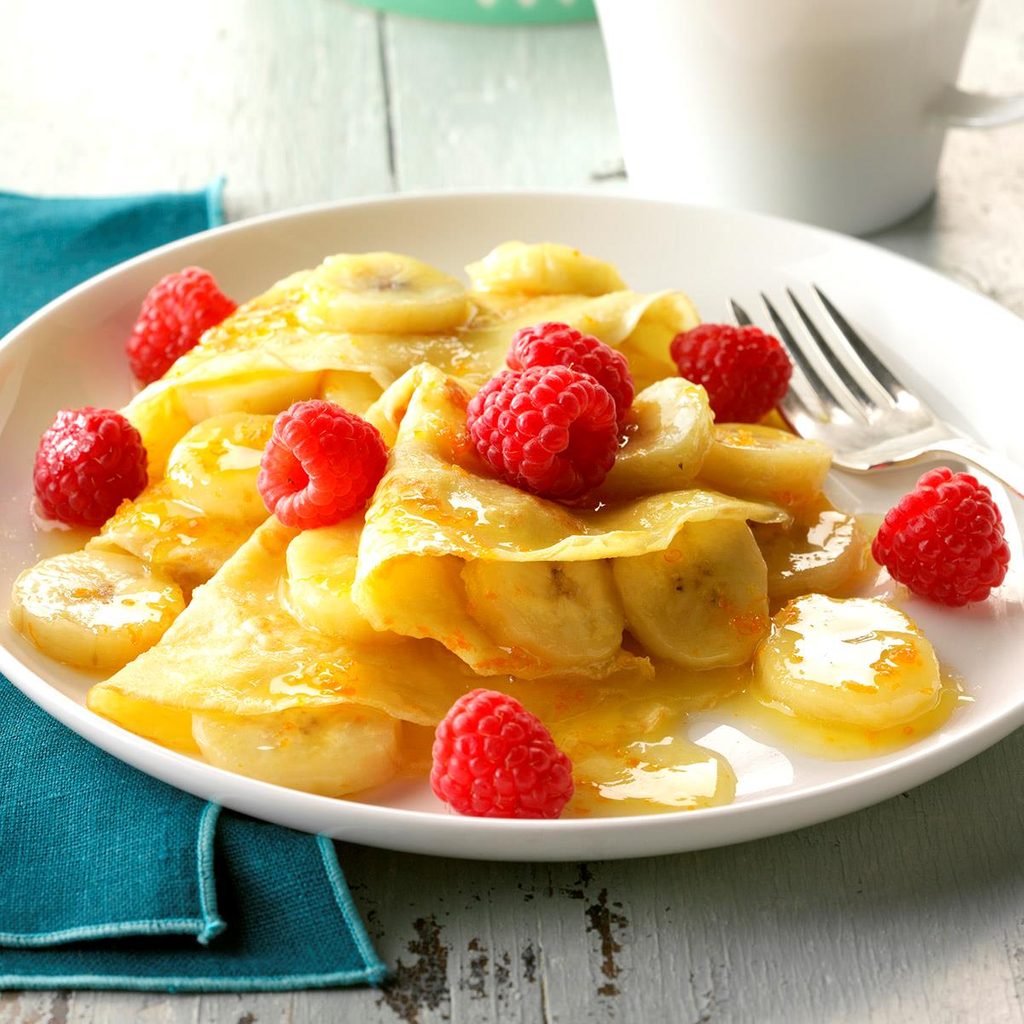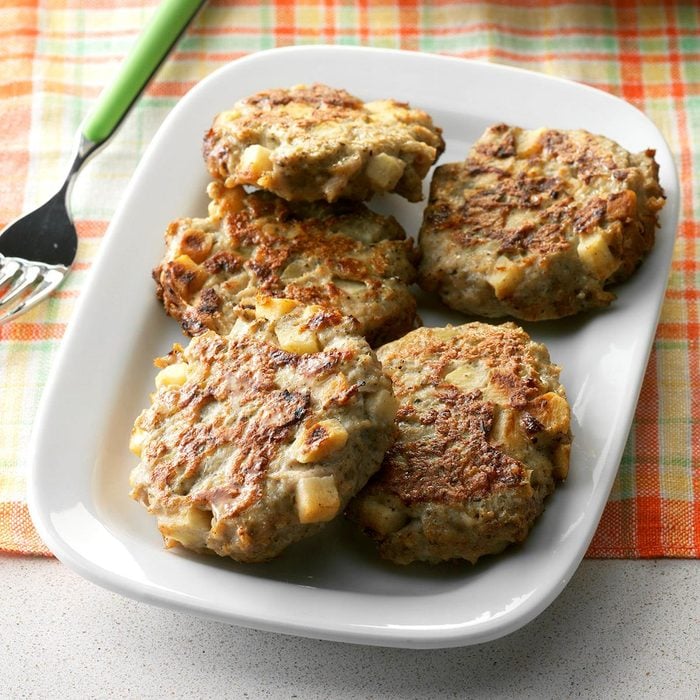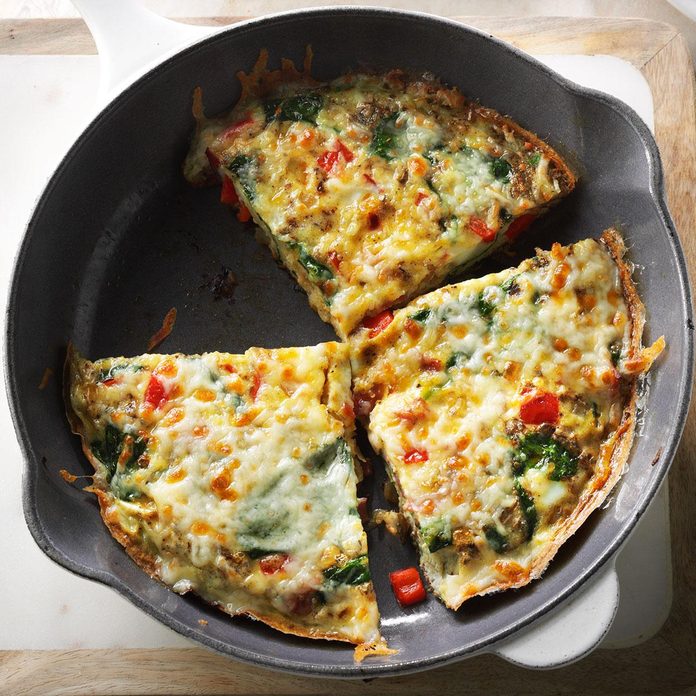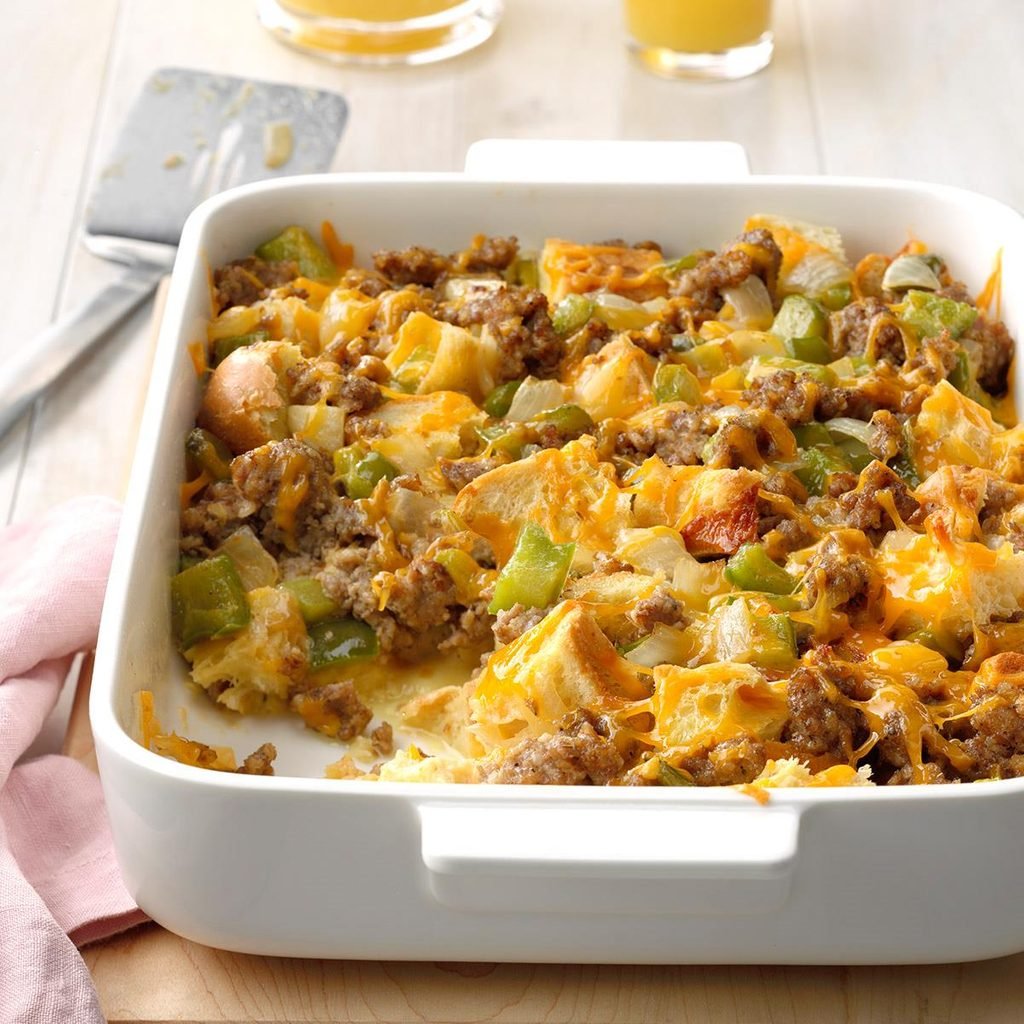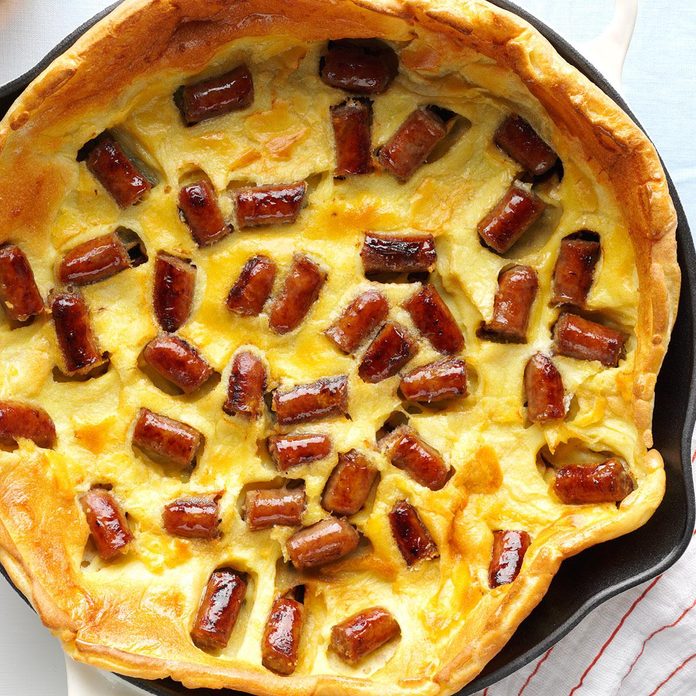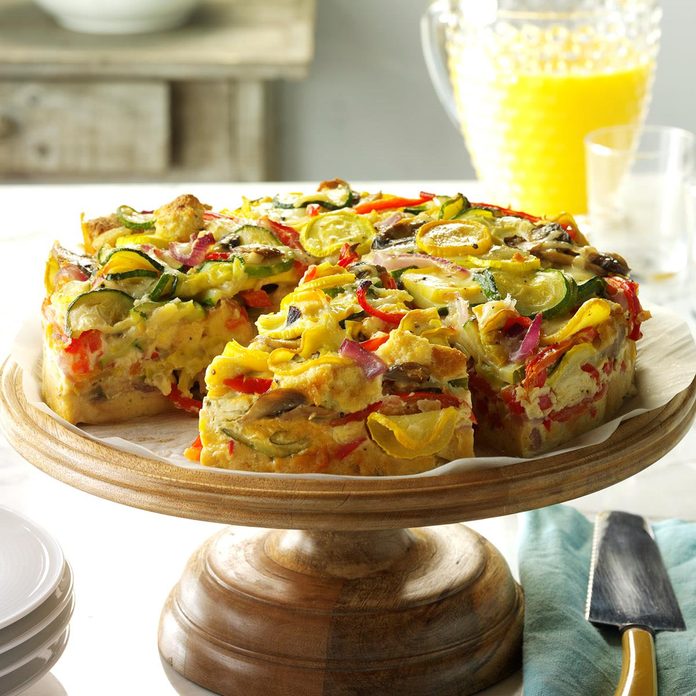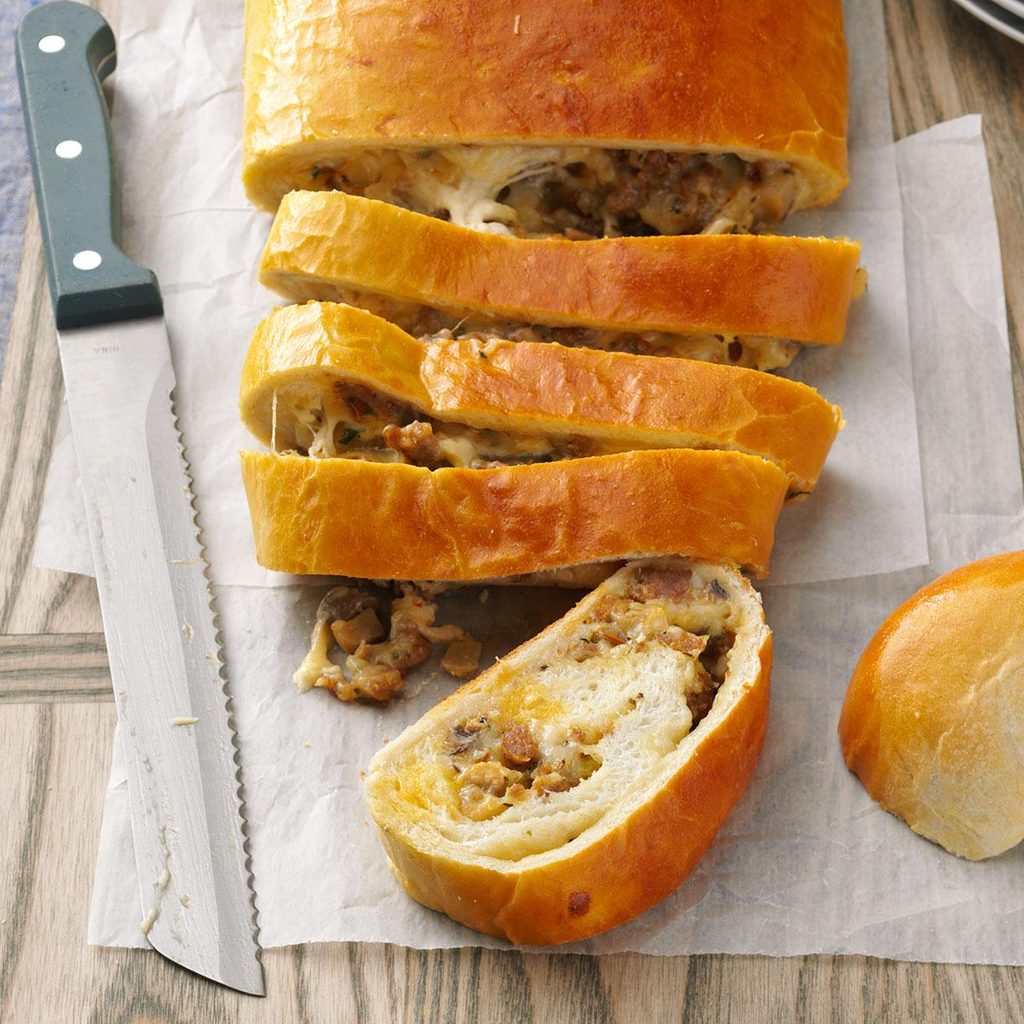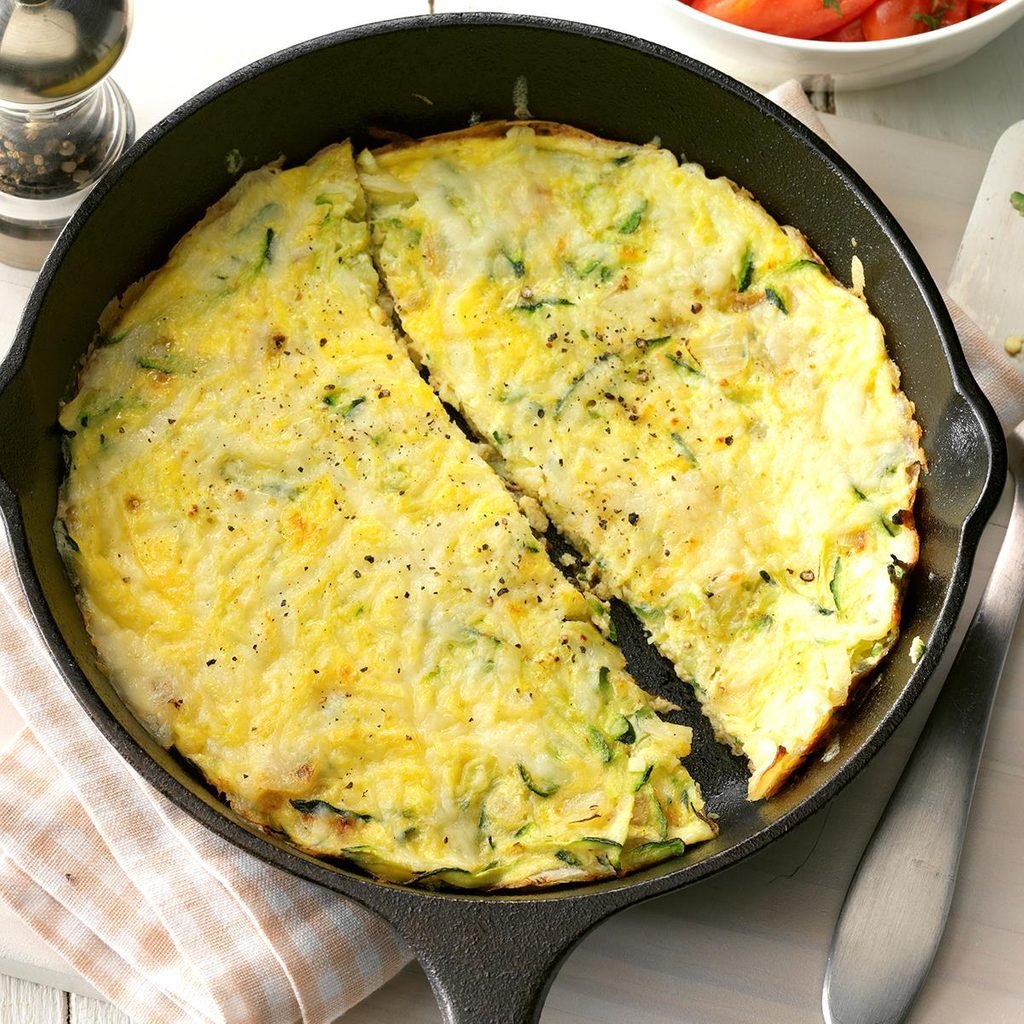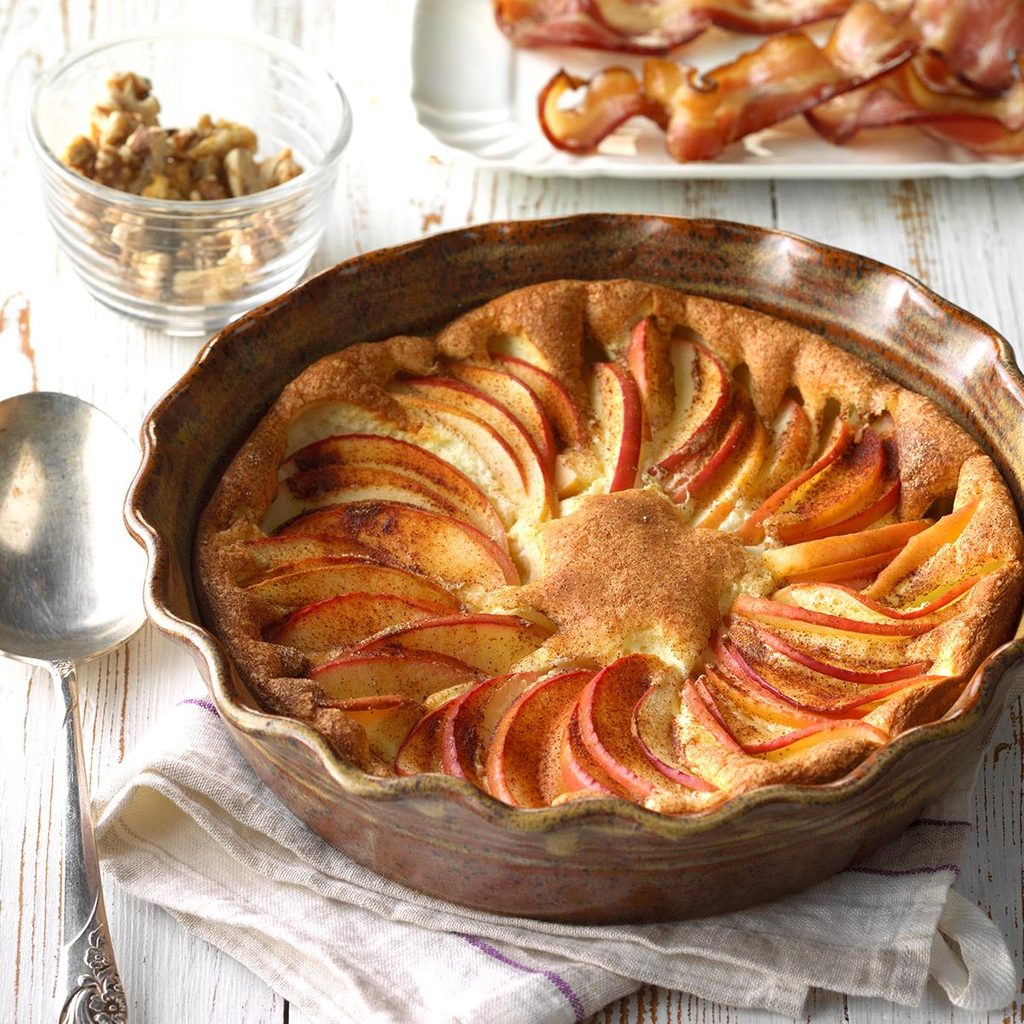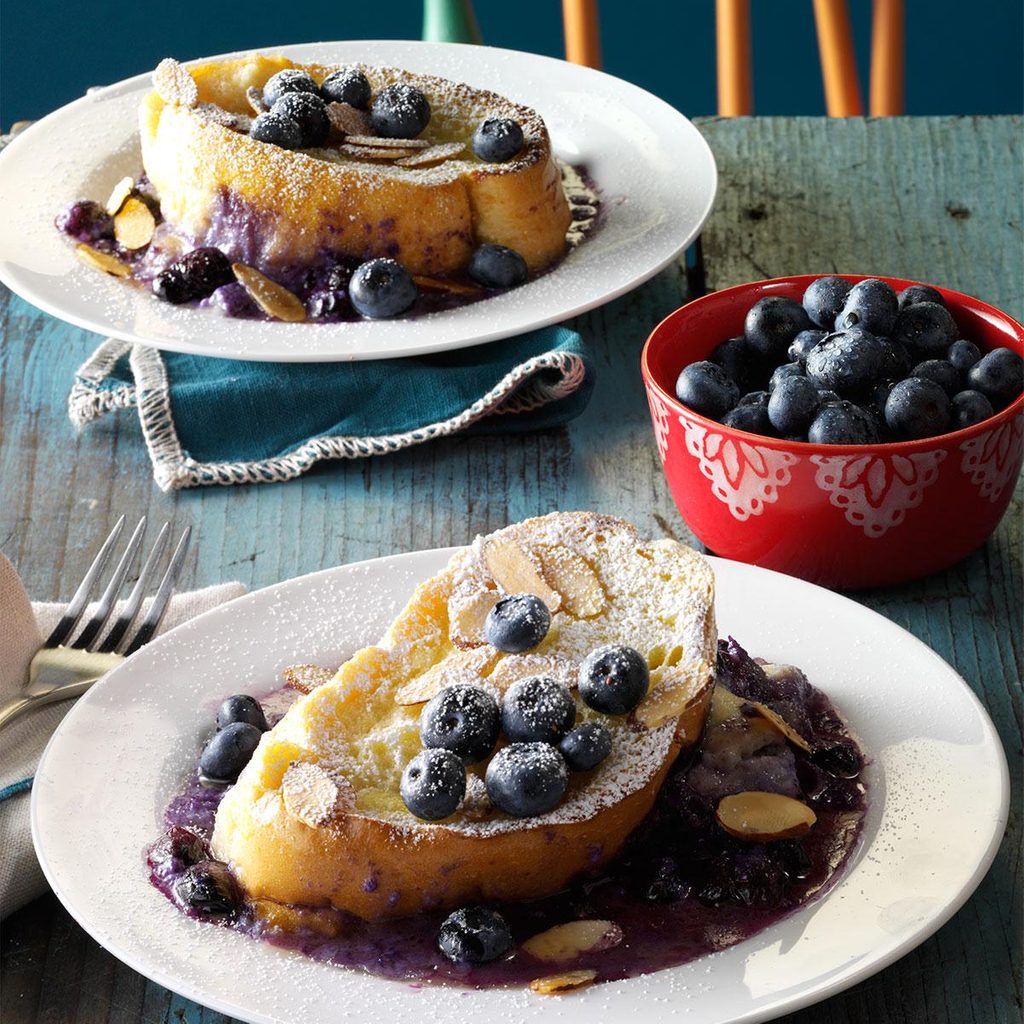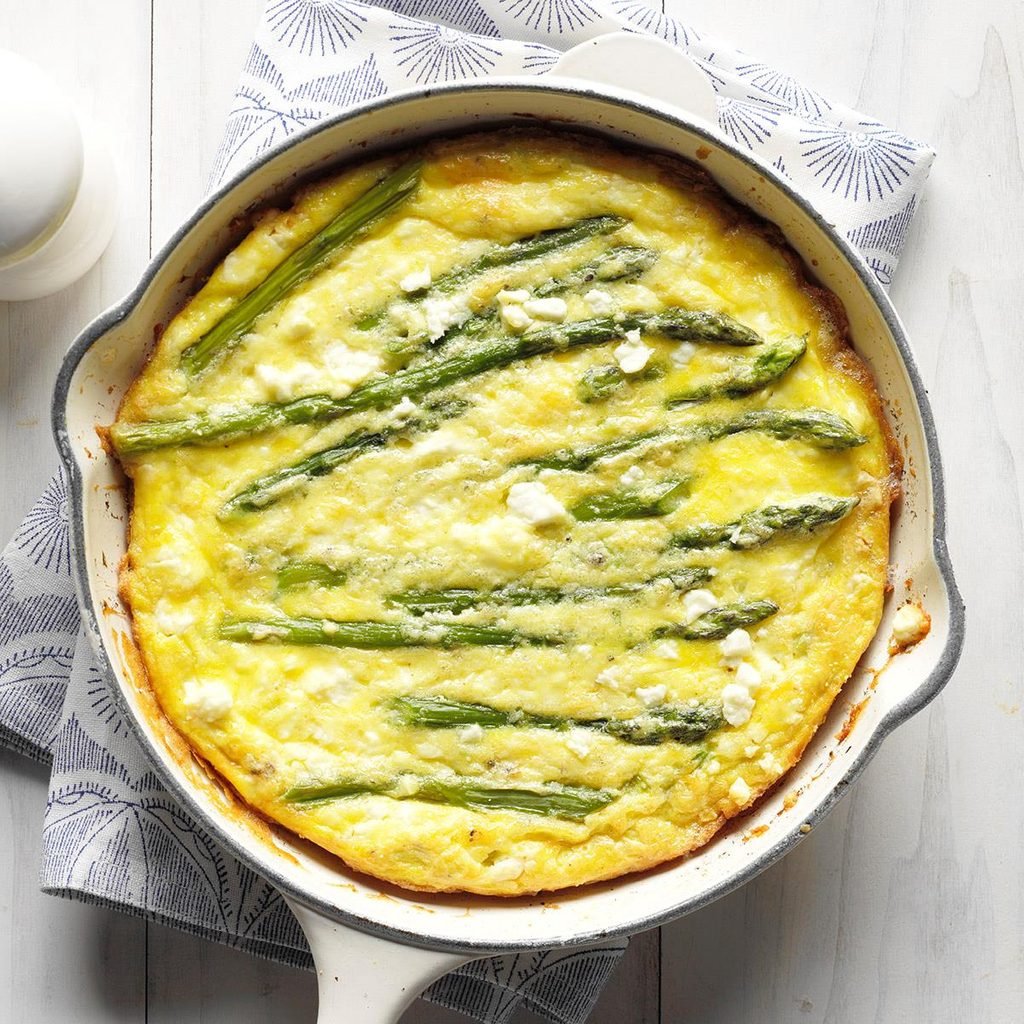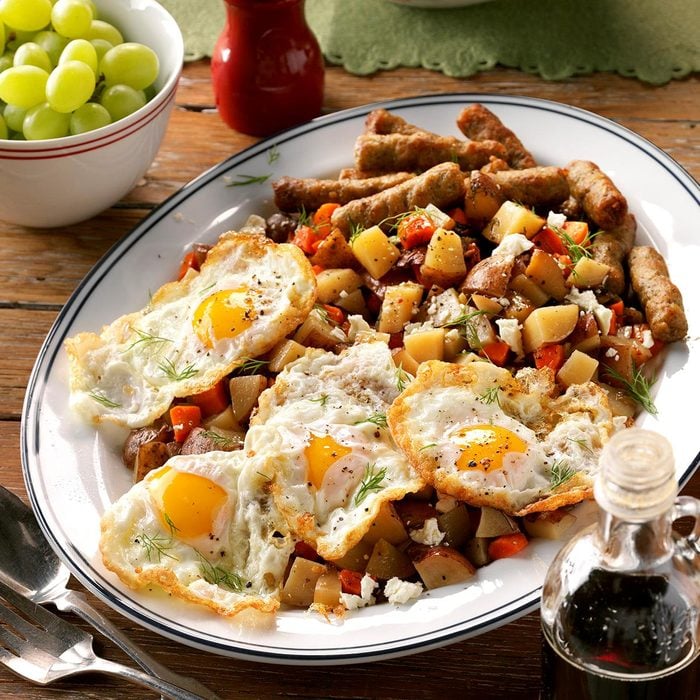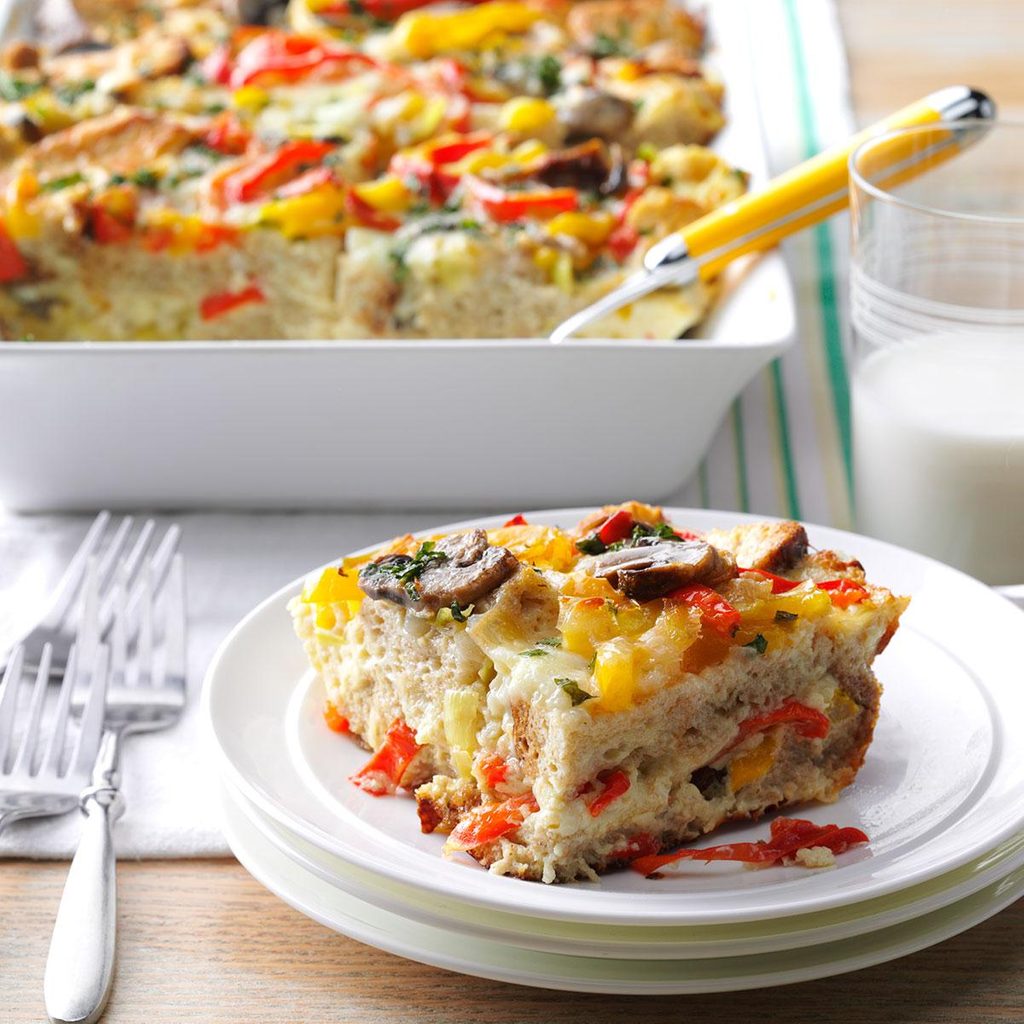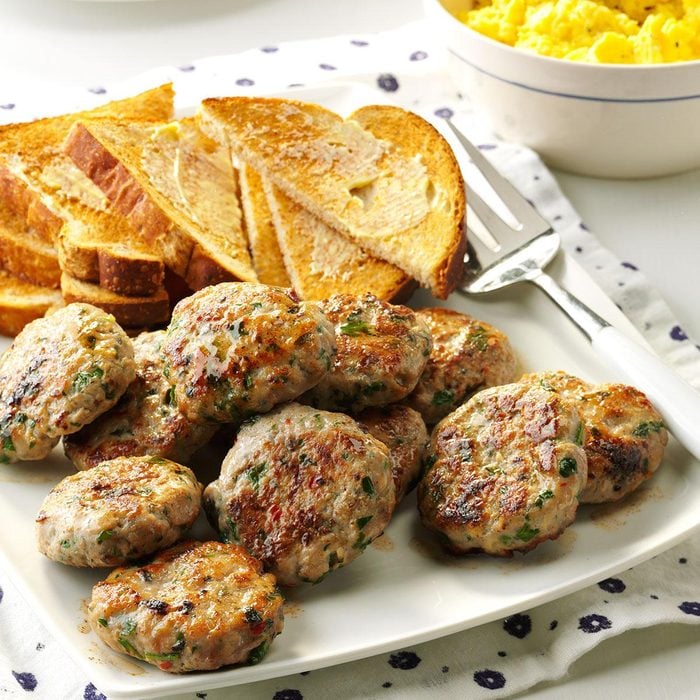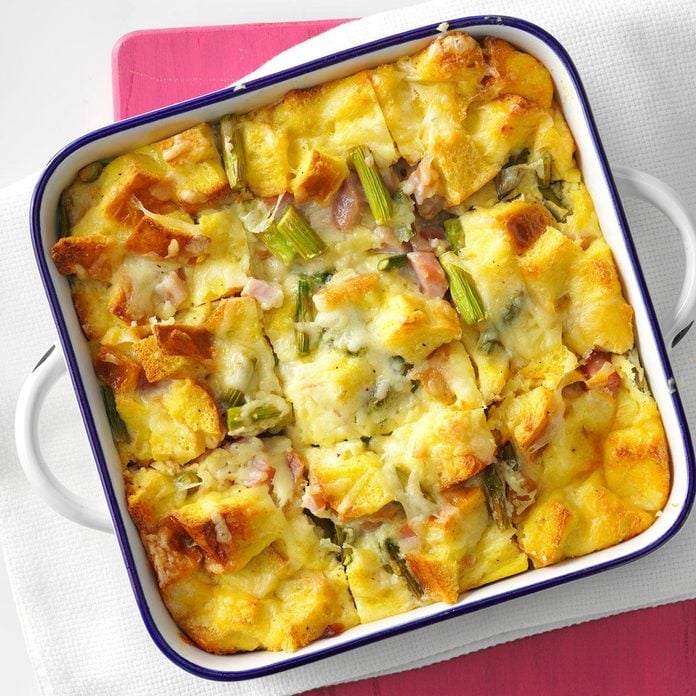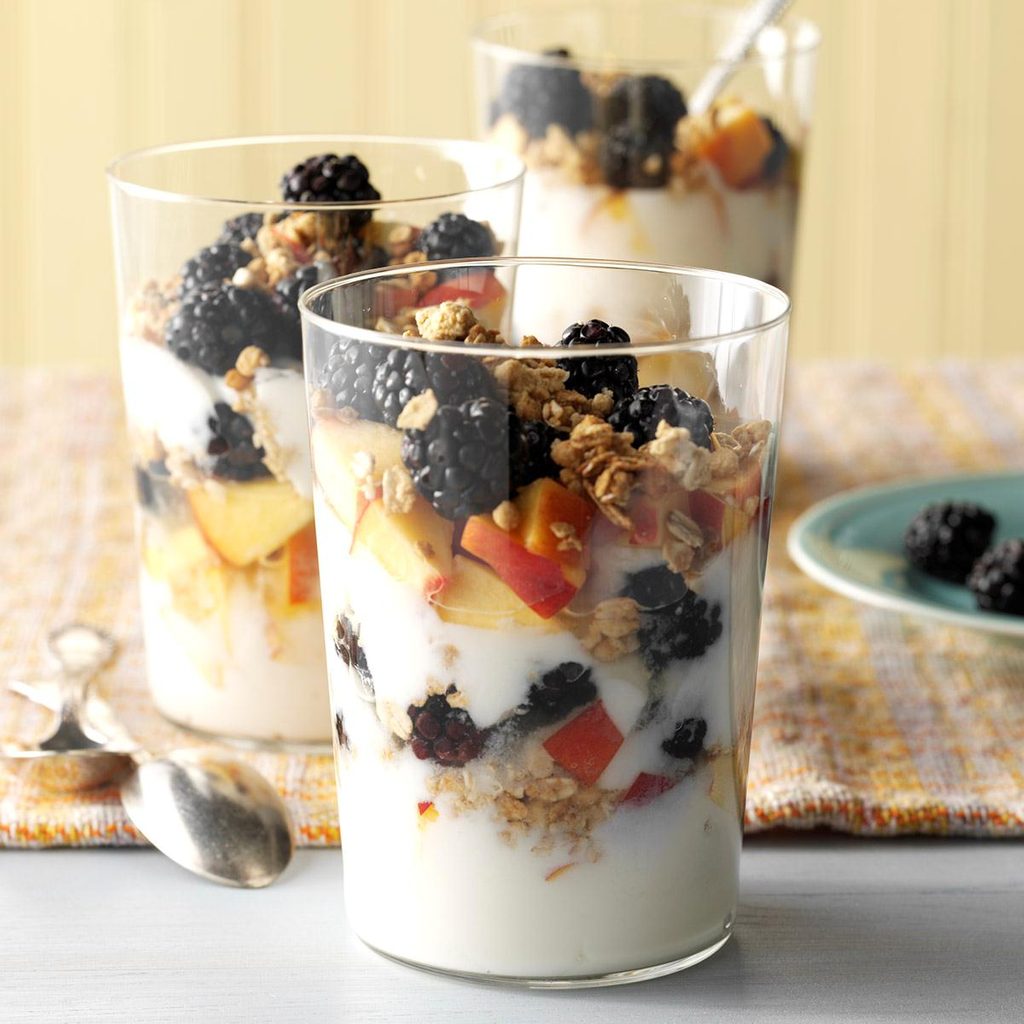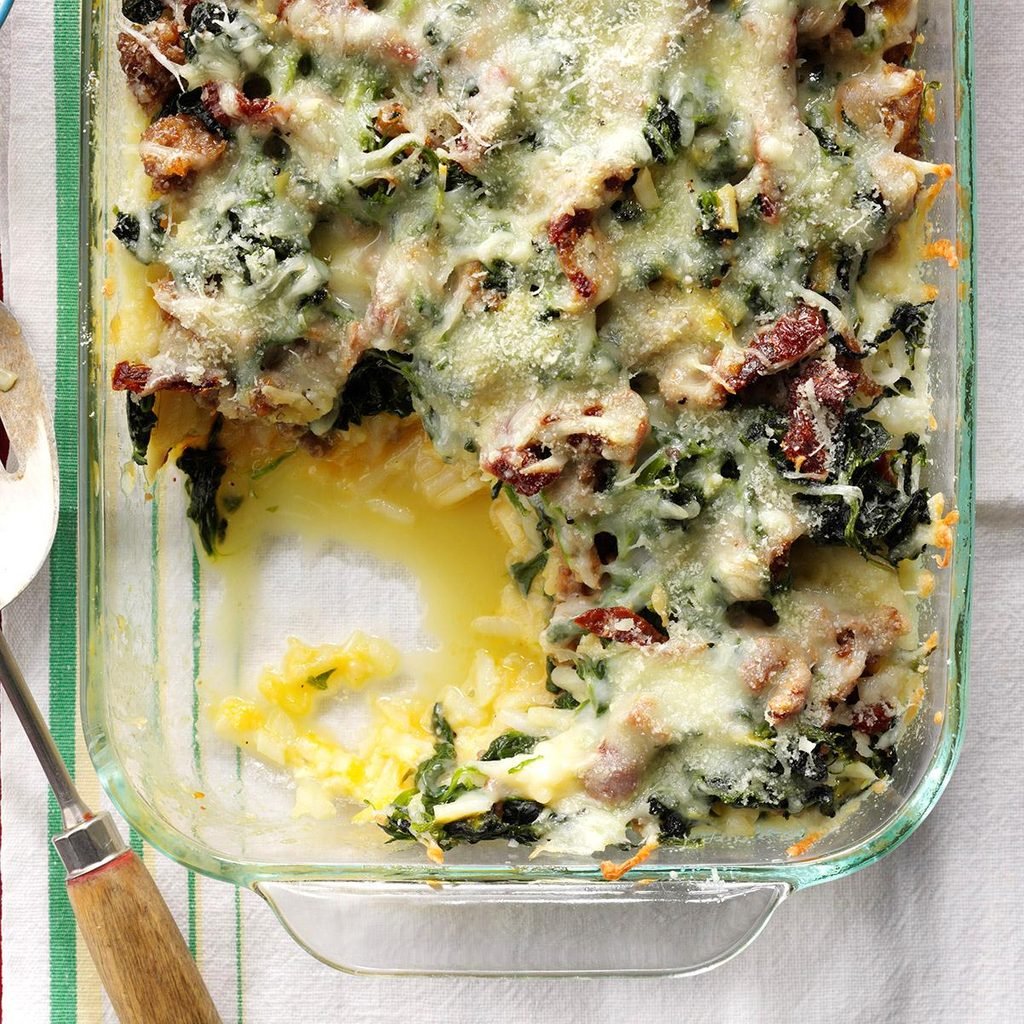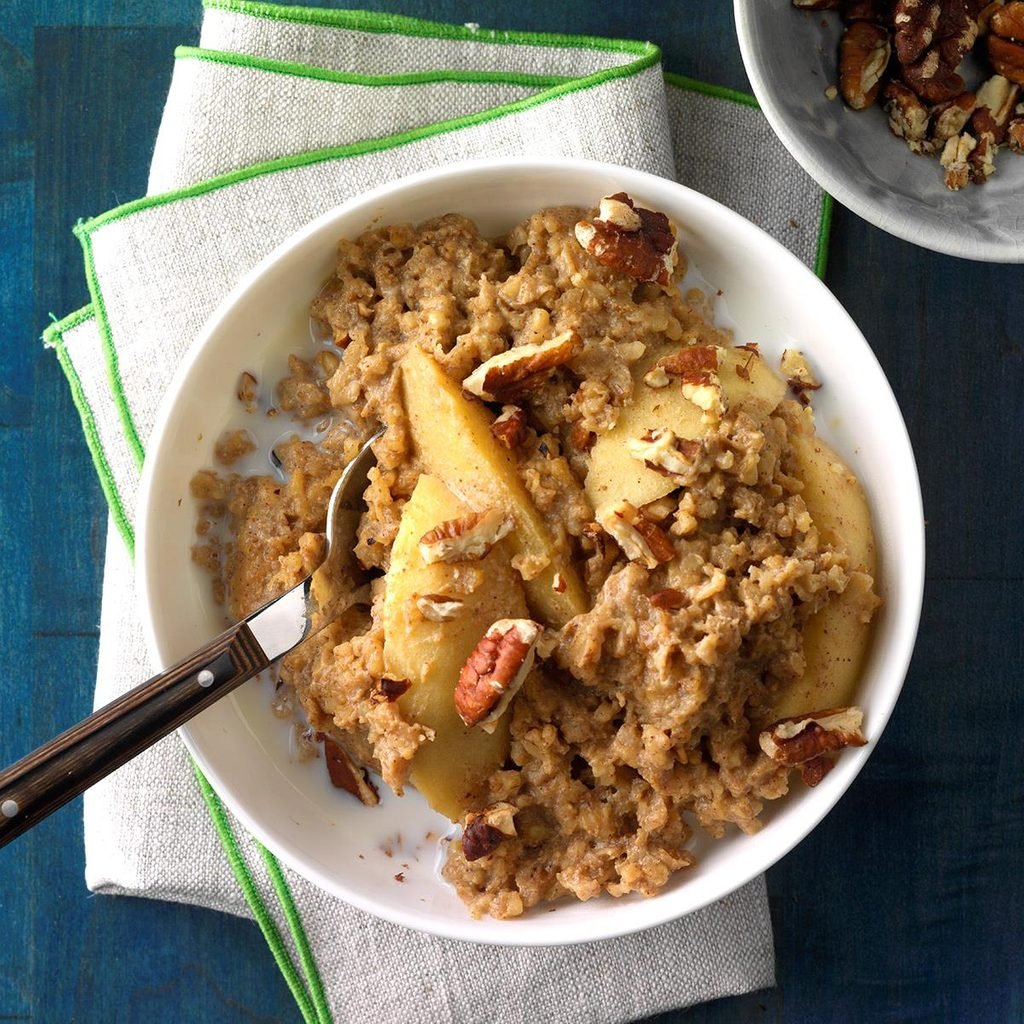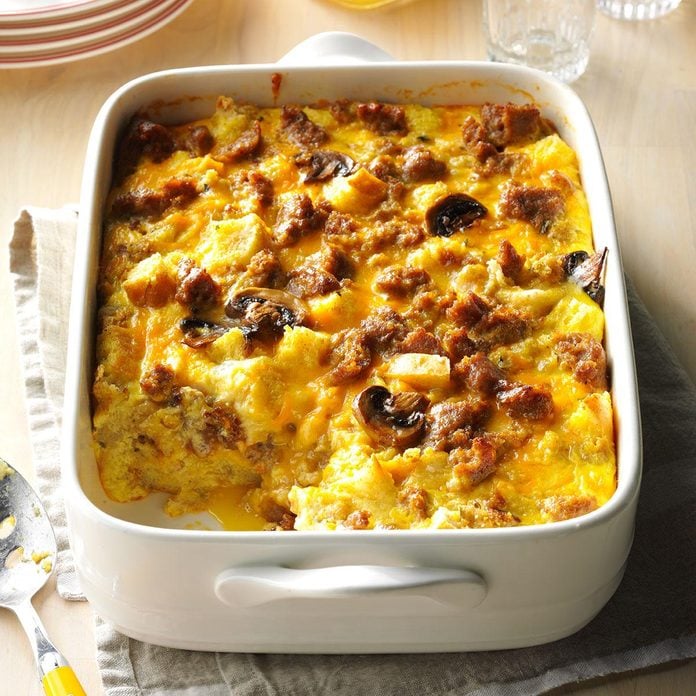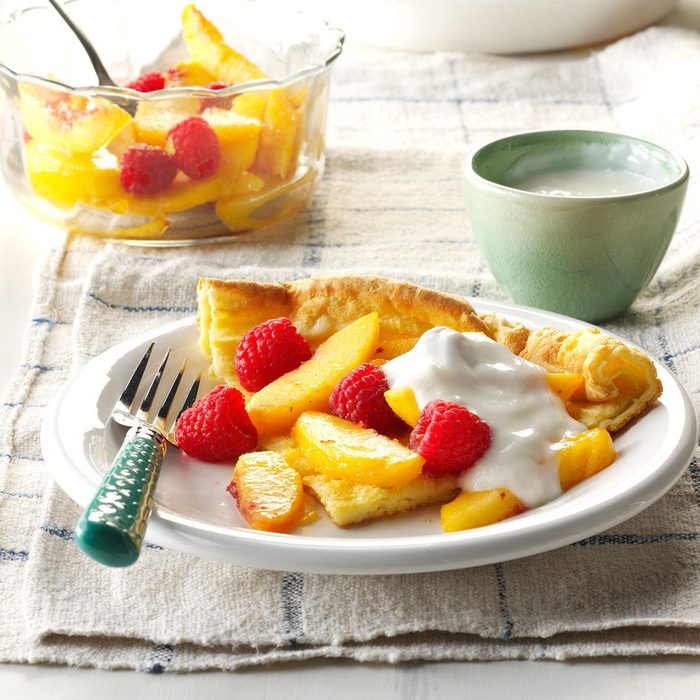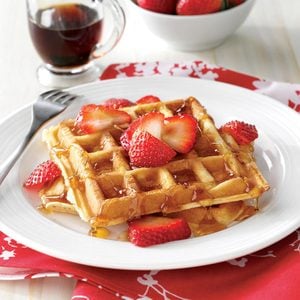 Taste of Home
Taste of Home
It was on a visit to my husband's relatives in Europe that I was given this Belgian waffle recipe. These homemade waffles are great with any kind of topping: blueberries, strawberries, raspberries, fried apples, powdered sugar or whipped topping. —Rose Delemeester, St. Charles, Michigan.
Also, check these
best breakfast recipes to sort your mornings!
Go to Recipe
Blueberry French ToastA local blueberry grower shared this recipe with me, and it's the best breakfast dish I've ever tasted. With the cream cheese and berry combination, this French toast casserole reminds me of dessert. —Patricia Axelsen, Aurora, Minnesota
Amish Breakfast CasseroleWe enjoyed hearty breakfast casseroles during a visit to an Amish inn. When I asked for a recipe, one of the women told me the ingredients right off the top of her head. I modified it a bit to create this version that my family loves. —Beth Notaro, Kokomo, Indiana
Fluffy PancakesI found this fluffy and easy pancake recipe among our old family favorites and adapted it to make a small amount. It's quick and easy to prepare, but we still consider it a special treat. —Eugene Presley, Council, Virginia
Oven Denver OmeletI like omelets but don't always have time to stand by the stove. That's why I favor this oven-baked variety that I can quickly pop into the oven at a moment's notice. My family frequently requests this for Sunday brunch. They always empty the dish. —Ellen Bower, Taneytown, Maryland
Fruity Baked OatmealThis is my husband’s favorite breakfast treat and the ultimate comfort food. It’s warm, filling and always a hit when I serve it to guests. —Karen Schroeder, Kankakee, Illinois.
Farmer's CasseroleBetween family and friends, we have nearly 375 visitors a year! This casserole is handy—you can put it together the night before, let the flavors blend, then bake it in the morning. —Nancy Schmidt, Center, Colorado
Mushroom Asparagus QuicheLoads of asparagus pieces add color and flavor to this hearty, creamy quiche. And its easy crescent roll crust means you'll have dinner ready in a snap! —Sharon A. Fujita, Fontana, California
Blueberry Streusel Coffee CakeThis blueberry coffee cake smells wonderful as it bakes and tastes even better. The moist cake filled with juicy berries and crunchy pecans is a family favorite. It never lasts long at our house. —Lori Snedden, Sherman, Texas
Buttermilk PancakesYou just can't beat a basic buttermilk pancake for a down-home country breakfast. Paired with sausage and fresh fruit, these pancakes are just like the ones you get at Cracker Barrel. —Betty Abrey, Imperial, Saskatchewan
Vanilla French ToastWe discovered this easy French toast recipe in Mexico. We couldn't figure out what made the French toast so delicious until we learned the secret was vanilla. Since then, we've added a touch of vanilla to our waffle and pancake recipes, and it makes all the difference. —Joe and Bobbi Schott, Castroville, Texas
Biscuits and Sausage GravyThis biscuits and sausage gravy is an old southern recipe that I've adapted. Homemade sausage gravy is a classic, hearty breakfast that takes you on a trip to the South every time it's served. —Sue Baker, Jonesboro, Arkansas. Next, check our favorite
vintage breakfasts.
Eggs Benedict CasseroleThis
eggs Benedict casserole is just as tasty as the classic but without all the hassle. Simply assemble the ingredients ahead, and bake it the next morning for an elegant breakfast or brunch. —Sandie Heindel, Liberty, Missouri
Amish Baked OatmealThe first time I had this treat was at a bed-and-breakfast in Lancaster, Pennsylvania. To me, it tasted just like a big warm-from-the-oven oatmeal cookie! —Colleen Butler, Inwood, West Virginia
Italian Brunch TorteWe always serve this impressive layered breakfast bake with a salad of mixed greens and tomato wedges. It is one of our most requested dishes and can be served warm or cold. —Danny Diamond, Farmington Hills, Michigan
Sausage and Egg CasseroleFor the perfect combination of eggs, sausage, bread and cheese, this is the dish to try. My mom and I like this sausage breakfast casserole because it bakes up tender and golden, slices beautifully and goes over well whenever we serve it. —Gayle Grigg, Phoenix, Arizona
German PancakePiping hot and puffy from the oven, this golden pancake made a pretty presentation for a skier's theme breakfast I hosted. Served with homemade buttermilk syrup, it's an eye-opening treat. Make several German pancakes if you're feeding a crowd, and keep in mind that my easy syrup tastes great on waffles and French toast, too. —Renae Moncur, Burley, Idaho
Family-Favorite Oatmeal WafflesThese healthful, good-tasting waffles are a tried-and-true family favorite—even with our two children. My husband and I have a small herd of beef cattle and some pigs. A hearty breakfast really gets us going! —Marna Heitz, Farley, Iowa
Cheesy Hash BrownsThese cheesy hash browns were so popular at the morning meetings of our Mothers of Preschoolers group that we published it in our newsletter. It's a great dish for busy moms because it can be prepared ahead of time. It's perfect for brunches or to serve on Christmas morning. It's creamy, comforting and tasty. —Karen Burns, Chandler, Texas
Crustless Spinach QuicheI served this crustless quiche at a church lunch, and I had to laugh when one guy told me how much he disliked vegetables. Many people were surprised by how much they loved this veggie-filled quiche recipe—and he was one of them! —Melinda Calverley, Janesville, Wisconsin
Bacon and Eggs CasseroleBecause it's fast to fix and such a great hit with family and friends, this egg casserole with bacon is a favorite of mine to make for brunches. Served with a fruit salad, hot muffins and croissants, it's excellent for an after-church meal. —Deanna Durward-Orr, Windsor, Ontario
Also check out this farmhouse-style
bacon grease container that has nearly 12,000 five-star ratings on Amazon.
Banana Blueberry PancakesThis blueberry pancakes recipe is a favorite in our home. My kids don’t even realize how healthy it is! —Kelly Reinicke, Wisconsin Rapids, Wisconsin
Ham 'n' Cheese Omelet RollThis brunch dish has easy ingredients and an impressive look all rolled into one! I love hosting brunch, and this special omelet roll is one of my very favorite items to prepare and share. A platter of these pretty swirled slices disappears fast. —Nancy Daugherty, Portland, Ohio
Rainbow QuicheWith plenty of veggies and a creamy egg-cheese filling, this tasty quiche gets rave reviews every time I make it! —Lilith Fury, Adena, Ohio
Vanilla French ToastWe discovered this easy French toast recipe in Mexico. We couldn't figure out what made the French toast so delicious until we learned the secret was vanilla. Since then, we've added a touch of vanilla to our waffle and pancake recipes, and it makes all the difference. —Joe and Bobbi Schott, Castroville, Texas
Bacon Breakfast PizzaI used to make this bacon breakfast pizza for my morning drivers when I worked at a delivery place. And they just loved it. Breakfast pizza is a quick and easy eye-opener that appeals to all ages. —Cathy Shortall, Easton, Maryland
Overnight Asparagus StrataI've made this tasty egg dish for breakfast, brunch, even dinner as a side dish. This is not your run-of-the-mill strata. —Lynn Licata, Sylvania, Ohio
Baked Cheddar Eggs & PotatoesI love making breakfast recipes with eggs for dinner, especially this combo with potatoes and cheese that's started in a skillet on the stovetop and then popped into the oven to bake. —Nadine Merheb, Tucson, Arizona
Mini Sausage QuichesThese bite-sized quiches are loaded with sausage and cheese—and all nestled into easy crescent roll dough. Serve the cute muffinettes at any brunch or potluck gathering. —Jan Mead, Milford, Connecticut
Orange Ricotta PancakesThese popular pancakes are likely to spark a craving. For a different twist, switch the citrus ingredient to lime or lemon juice.—Brehan Kohl, Anchorage, Alaska
Sausage Spinach BakeA friend gave me the recipe for this delicious dish, which uses a packaged stuffing mix. A salad and bread of your choice is all you’ll need for a filling lunch or dinner. It’s so versatile, you can even serve it at brunch. –Kathleen Grant, Swan Lake, Montana
Cornmeal PancakesI like to joke that these pancakes are so light, you have to hold them down! When we have a chance, we make them with freshly ground cornmeal bought at local festivals. —Betty Claycomb, Alverton, Pennsylvania
Cheese GritsAs a comfy side dish, cheese grits have fantastic potential but sometimes need a flavor boost. For add-ins, try red pepper flakes, fresh rosemary or crushed garlic. —Paula Hughes, Birmingham, Alabama
French Banana PancakesThese pancakes are a real breakfast favorite in our family. Even our 8- and 10-year-old daughters make them all by themselves when they have friends spend the night. Now their friends' mothers are asking for the recipe! —Cheryl Sowers, Bakersfield, California
Brunch Ham EnchiladasWhen I'm expecting company for brunch, the menu often features this tried-and-true casserole. With ham, eggs and plenty of cheese, the enchiladas are flavorful, hearty and fun. And they're easy to assemble the day before.
—Gail Sykora, Menomonee Falls, Wisconsin
Cinnamon Doughnut MuffinsBack when my children were youngsters, they loved these doughnut muffins as after-school treats or with Sunday brunch. —Sharon Pullen, Alvinston, Ontario
Raisin Nut OatmealThere’s no better feeling than waking up to a hot, ready-to-eat breakfast. The oats, fruit and spices in this homey meal cook together while you sleep! —Valerie Sauber, Adelanto, California
Spiced Bacon TwistsA sweet and savory rub makes these tasty twists of bacon deliciously different and worth the extra step to prepare. Cook a bit longer if you want them crispy. Glenda Evans Wittner - Joplin, MO
Apple Pancakes with Cider SyrupTender pancakes are filled with minced apple and raisin, and drizzled with apple cider syrup. They're wonderful in the summer or on a cool fall morning. —April Harmon, Greeneville, Tennessee
Cheesy Egg PuffsMy father loves to entertain, and these buttery egg delights are one of his favorite items to serve at brunch. The leftovers are perfect to reheat in the microwave on busy mornings, so Dad always stashes a few aside for me to take home once the party is over. —Amy Soto, Winfield, Kansas
Broccoli Ham QuicheThis rich ham and broccoli quiche is featured in a family cookbook I put together. My husband is proof that quiche can satisfy even a very healthy appetite. —Marilyn Day, North Fort Myers, Florida
Fluffy Pumpkin PancakesThese pumpkin pancakes are also delicious served with butter or whipped topping and a sprinkle of pumpkin pie spice. Freeze any extras in a single layer on a cookie sheet, then store in a freezer bag. They're great fresh out of the toaster! —Mindy Bauknecht, Two Rivers, Wisconsin
Maple Toast and EggsMy home's in the country, right next door to my sister and brother-in-law's. They and their two children all enjoy this dish each time I serve it as a special evening meal—although it can also be made for breakfast or lunch. —Susan Buttel, Plattsburgh, New York
Cream Cheese & Chive OmeletThe first bite of creamy filling lets you know this isn’t any old omelet. Make it once, and we suspect you’ll be fixing it often. —Anne Troise, Manalapan, New Jersey
Bacon 'n' Egg LasagnaMy sister-in-law served this special dish for
Easter breakfast one year, and our whole family loved the mix of bacon, eggs, noodles and cheese. Now I sometimes assemble it the night before and bake it in the morning for a terrific hassle-free brunch entree. —Dianne Meyer, Graniteville, Vermont
BLT Egg BakeBLTs are a favorite at my house, so I created this recipe to combine those flavors into a warm, cozy casserole. It was such a hit, I served it to my church ladies group at a brunch I hosted. —Priscilla Detrick, Catoosa, Oklahoma
Peach French ToastLet the aroma of baked peaches, brown sugar and cinnamon wake up your family. When you serve the tender slices of French toast, be sure to scoop up the golden syrup in the bottom of the pan and drizzle it over the top. —Geraldine Casey, Anderson, Indiana
Baked Peach PancakeThis dish makes for a dramatic presentation. I usually take it right from the oven to the table, fill it with peaches and sour cream and serve it with bacon or ham. Whenever I go home, my mom (the best cook I know) asks me to make this. —Nancy Wilkinson, Princeton, New Jersey
Sausage and Hashbrown Breakfast PizzaPizza for breakfast? Kids of all ages will love making—and munching—this hearty meal-in-one made with convenient crescent rolls and frozen hash browns. It's even great for camping! —Rae Truax, Mattawa, Washington
Bananas Foster French ToastMmm…bananas Foster for breakfast! This yummy baked French toast serves up all the taste of the spectacular dessert in fine fashion. —Laurence Nasson, Hingham Massachusetts
Meal in a Muffin PanThis meal-in-a-pan breakfast is ideal for busy weekday mornings. I just add fresh fruit and beverages. —Michelle Plumb, Montrose, Colorado
Toad in the HoleAmerican Toad in a hole is one of the first recipes I had my children prepare when they were learning to cook. Much easier than the European version, this fun egg-in-a-hole is sure to please. My "little ones" are now grown (and have advanced to more difficult recipes!), but this continues to be a traditional standby in my home and theirs. —Ruth Lechleiter, Breckenridge, Minnesota
Baked Omelet RollA baked omelet is a deliciously different way to serve eggs. The eggs bake in the oven, so you don't have to keep a constant eye on them like omelets made in a frying pan on the stove.
Cinnamon Fruit BiscuitsBecause these sweet treats are so easy, I'm almost embarrassed when people ask me for the recipe. They're a snap to make with refrigerated buttermilk biscuits, sugar, cinnamon and your favorite fruit preserves. —Ione Burham, Washington, Iowa
Brunch StrataHam, zucchini, mushrooms and cheese flavor this rich, hearty egg dish. It looks irresistible on a breakfast or lunch buffet, and it’s easy to cut into neat squares. Make sure you bring the recipe—everyone will want it! —Arlene Butler, Ogden, Utah
Creamy Frozen Fruit CupsI love to prepare these cool, fluffy fruit cups to give a refreshing boost to many meals. They've been well received at family gatherings and summer barbecues. There's no last-minute fuss since you make them well in advance. —Karen Hatcher, St. Amant, Louisiana
Spinach Swiss QuicheWarm wedges of this tasty quiche are packed with convenient frozen spinach, sweet red pepper and Swiss cheese. My family requests this dish year-round. You can saute the bacon mixture the night before to reduce prep time on busy mornings. —April Milner, Dearborn Heights, Michigan
Green Chile Egg PuffGreen chilies add a touch of Southwest flavor to this fluffy egg dish. The cottage cheese offers nice texture, and people always love the gooey Montery Jack cheese melted throughout.
—Laurel Leslie, Sonora, California
Camper's Breakfast HashWhen we go camping with family and friends, I'm always asked to make this hearty breakfast. This camping breakfast is a favorite at home, too. —Linda Krivanek, Oak Creek, Wisconsin
Egg BurritosZap one of these frozen burritos in the microwave and you'll stave off hunger all morning. This recipe is my family’s favorite combo, but I sometimes use breakfast sausage instead of bacon. —Audra Niederman, Aberdeen, South Dakota
Maple French Toast BakeThis yummy French toast casserole is a breeze to whip up the night before a busy morning. My family loves the richness it gets from cream cheese and maple syrup. —Cindy Steffen, Cedarburg, Wisconsin
German Apple PancakeIf you're looking for a pretty dish to make when having guests for brunch, try this. Everyone I've served it to has enjoyed it—except for one time, that is, when my husband tried to make it following my recipe, which I'd written down incorrectly! If you don't leave out the flour as I did, it'll turn out terrific! —Judi Van Beek, Lynden, Washington
Eggs Florentine CasseroleFor our Christmas brunch, I make this variation on a classic eggs Florentine recipe, adding sausage and spinach to make a snappy casserole. Sometimes I mix in fresh peppers or green chiles, so play with it. —Karen Weekley, Washington, West Virginia
Garden FrittataI created this frittata recipe one day to use up some fresh yellow squash, zucchini and tomato. It's so easy to make because you don't have to fuss with a crust. Give it different twist by trying it with whatever veggies you have on hand. —Catherine Michel, St. Peters, Missouri
Asparagus Swiss QuicheFresh asparagus stars along with bacon, onion and Swiss cheese in this hearty quiche. —Mary Ann Taylor, Rockwell, Iowa
Sausage Egg BakeThis hearty egg dish is wonderful for any meal of the day. I fix it frequently for special occasions, too, because it's easy to prepare and really versatile. For a change, use spicier sausage or substitute a flavored cheese blend.
-Molly Swallow, Pocatello, Idaho
Mom's Potato PancakesThese old-fashioned pancakes are fluffy inside and crispy outside. Onion adds nice flavor. Mom got this recipe from Grandma, so we've enjoyed it for years. —Dianne Esposite, New Middletown, Ohio
Cheesy Vegetable Egg DishI'm a cook at a Bible camp, and this is one of my most popular recipes. Everyone who tries it raves about it. The one that touched me the most was when a 10-year-old boy asked me for the recipe so he could have his mom make it at home. —Elsie Campbell, Dulzura, California
Chocolate Chip Pancakes with Cinnamon Honey SyrupThis is a great breakfast for special days, but it mixes up so fast that it's perfect for busy mornings as well. —LeeAnn Hansen, Kaysville, Utah
Oatmeal Brulee with Ginger CreamThis is an awesome dish for a chilly morning. I love the crispy, caramelized top and raspberry surprise at the bottom.
—Yvonne Starlin, Portland, Tennessee
Mini Spinach FrittatasPeople can't get enough of these pop-in-your-mouth mini frittatas. They're a cinch to make, freeze well and the recipe easily doubles for a crowd. —Nancy Statkevicus, Tucson, Arizona
Mushroom Broccoli QuicheI take this dish to many of my family’s picnics because it's always such a hit. Serve it at any time of day. Quiche makes a great side or meatless main course—and, of course, it's a tasty addition to brunch. —Edie DeSpain, Logan, Utah
Get-Up-and-Go GranolaMy family loves to have this soul-warming granola before hiking, biking or even when camping. It smells delicious while baking up and you can easily make in large batches for special occasions or to send in gift packages to family and friends. —Sabrina Olson, Otsego, Minnesota
Spinach-Mushroom Scrambled EggsMy husband and I had breakfast at a hotel and enjoyed an amazing mushroom and egg dish. As soon as I got home, I made my own rendition. —Rachelle McCalla, Batesville, Arkansas
Calico Scrambled EggsWhen you're short on time and scrambling to get a meal on the table, this recipe is just what you need. There's a short ingredient list, cooking is kept to a minimum. and the green pepper and tomato makes it colorful. —Taste of Home Test Kitchen
Country Brunch SkilletUsing frozen hash browns and packaged shredded cheese shaves minutes off the prep time of this skillet egg dish, making it an appealing meal you can put together quickly. —Elvira Brunnquell, Port Washington, Wisconsin
Hash Brown Egg BrunchSlow cookers aren't just for making dinner. I make this often if we're having company overnight. With just a little planning and not much work, I can prep it the night before and have a lovely breakfast waiting in the morning. —Barb Keith, Eau Claire, Wisconsin
Fruit-Filled French Toast WrapsHere’s my go-to whenever we have brunch guests. If I have extra berries, I just make a fruit salad for later. —Dawn Jarvis, Breckenridge, Minnesota
Southwest Sausage BakeThis layered tortilla dish is not only delicious, but it's a real timesaver because it's put together the night before. The tomato slices provide a nice touch of color. I like to serve this crowd-pleasing casserole with muffins and fresh fruit. —Barbara Waddel, Lincoln, Nebraska
Crab QuicheChopped green onions and sweet red pepper bring a bit of color to this golden entree. The creamy filling features imitation crabmeat and Swiss cheese. —Taste of Home Test Kitchen
Mushroom Sausage StrataThis flavorful casserole is a hearty mainstay for our family's Christmas Day brunch menu. Being able to assemble the recipe ahead of time is a real plus! —Julie Sterchi, Jackson, Missouri
Sunday Brunch Egg CasseroleMy favorite brunch dish got a makeover with egg substitute and lower-fat cheese. The lightened-up version still tastes delicious, but it won't weigh you down. —Alice Hofmann, Sussex, Wisconsin
Tomato Olive QuicheSalty, savory olives, two kinds of onions, juicy tomatoes and layers of cheese make this quiche a dish to remember. —Stephanie Proebsting, Barrington, Illinois
Brunch Egg CasseroleThere aren't many foods that do a better job of combining two meals - in this case, breakfast and lunch - than cheese and eggs. This dish satisfies a mouthful of taste buds and both hearty and light eaters. —Lelia Brown, Annandale, Virginia
Nutty French ToastThis sweet breakfast treat is a cross of caramel rolls and French toast. It's easy to begin the night before. In the morning, just spread on the nutty topping and bake as you are getting ready for the day. —Mavis Diment, Marcus, Iowa
Sausage-Apple Puff PancakeSavory sausage and sweet apples combine in this beautiful breakfast dish. The cheesy topping will definitely make you want seconds. —Carolyn Kumpe, El Dorado, California
Scrambled Egg Hash Brown CupsThey may look like muffins, but these cuties pack all your favorite rise-and-shine ingredients—eggs, hash browns and bacon—into a single-serving cup. Grab one and get munching. —Talon DiMare, Bullhead City, Arizona
Italian Garden FrittataI like to serve this pretty frittata with melon wedges for a delicious breakfast or brunch. —Sally Maloney, Dallas, Georgia
Old-World Puff PancakeMy mom told me her mother-in-law showed her how to make this dish, which became popular during the Depression, on their "get acquainted" visit in 1927. At that time, cooks measured ingredients in pinches, dashes and dibs. But through the years, accurate amounts were noted. My wife and I continue to enjoy this dish today, particularly for brunch. —Auton Miller, Piney Flats, Tennessee
Blueberry Crunch Breakfast BakeBlueberries in season make this a very special breakfast, but I find that frozen berries can work just as well. My grandmother used to make this with strawberries and I always loved to eat it at her house.—Marsha Ketaner, Henderson, Nevada
Sausage, Egg and Cheddar Farmers BreakfastThis hearty combination of sausage, hash browns and eggs is just right for any breakfast. &mdash:Bonnie Roberts, Newaygo, Michigan
Picante Omelet PieThis zippy egg bake is a favorite of one of my daughters. She comes for brunch every week before church, so I serve it often.—Phyllis Carlson, Gardner, Kansas
Orange-Cinnamon French ToastEveryone eats at the same time when you fix this tasty oven-baked French toast. —Bernice Smith, Sturgeon Lake, Minnesota
Overnight Pumpkin French Toast CasseroleRecipes that don't tie me to the kitchen—that’s what I’m all about. I make this luscious dish the night before breakfast or brunch with guests. —Patricia Harmon, Baden, Pennsylvania
Banana CrepesI like to serve this impressive treat at parties. The pleasant banana-orange flavor makes it wonderful for dinner or brunch. —Freda Becker, Garrettsville, Ohio
Savory Apple-Chicken SausageThese easy, healthy sausages taste great, and they make an elegant brunch dish. The recipe is also very versatile: It can be doubled or tripled for a crowd, and the sausages freeze well either cooked or raw. —Angela Buchanan, Longmont, Colorado
Frittata FlorentineMy family is all about brunchy meals like this gorgeous Italian omelet. Lucky for us, it’s loaded with ingredients we tend to have at the ready. —Jenny Flake, Newport Beach, California
Easy Breakfast StrataWe start this strata recipe the night before so it's ready for the oven the next day. That way, we don't have to deal with the prep and dirty dishes first thing in the morning! —Debbie Johnson, Centertown, Missouri
Grandmother's Toad in a HoleI have fond memories of my grandmother’s Yorkshire pudding wrapped around sausages, a puffy dish my kids called The Boat. Slather it with butter and maple syrup. —Susan Kieboam, Streetsboro, Ohio
Veggie-Packed StrataThis is a wonderful, colorful casserole that everyone enjoys. I'm sure you'll be hooked on it after one bite, too. —Jennifer Unsell, Vance, Alabama
Breakfast Sausage BreadAny time we take this savory, satisfying bread to a potluck, it goes over very well. We never bring any home. My husband generally makes this bread and prides himself on the beautiful golden loaves.
-Shirley Caldwell, Northwood, Ohio
BLT Brunch PieMy boys can't wait to pick the first ripe tomatoes in our garden to be used in this terrific pie. It has a tempting filling and tomatoes layered in a melt-in-your-mouth crust. And the crust is so easy to make- you just pat the dough into the pan! —Shara Walvoort, Oostburg, Wisconsin
Zucchini FrittataWhen we travel by car, I make the frittata the night before, stuff it into pita bread in the morning and microwave for a minute or two before I wrap them in a towel so down the road we can enjoy a still-warm breakfast! —Carol Blumenberg, Lehigh Acres, Florida
Sausage Cheese BiscuitsThese breakfast-in-a-biscuit goodies will appeal to the young...and the young at heart. It's one of my favorite recipes because it doesn't require any special ingredients. —Marlene Neideigh, Myrtle Point, Oregon
Puffy Apple OmeletWith all the eggs our chickens produce, I could make this omelet every day! It's a pretty, festive-looking dish, but you could fix it anytime—including for a light supper. —Melissa Davenport, Campbell, Minnesota
Baked Blueberry-Mascarpone French ToastWhen I want something special to serve my guests for a Saturday or Sunday brunch, I turn to this recipe. It never fails. It's wonderful during the spring and early summer because the blueberries are particularly good this time of year. —Patricia C. Quinn, Omaha, Nebraska
Bacon 'n' Egg SandwichesI came across this unique grilled combo when I was digging in my mom's recipe box. The crisp bacon, hard-boiled eggs and crunchy green onions make these cozy sandwiches look impressive when company drops by for lunch. Best of all, they're a snap to assemble. —Ann Fuemmeler, Glasgow, Missouri
Feta Asparagus FrittataAsparagus and feta cheese come together to make this frittata extra special. It's perfect for a lazy Sunday or to serve with a tossed salad for a light lunch. —Mildred Sherrer, Fort Worth, Texas
Hearty Slow-Cooker Breakfast HashThis sweet and savory hash certainly won't leave you hungry—the sausage, veggies and eggs will fill you up. The hint of maple syrup makes it all feel extra cozy. —Colleen Delawder, Herndon, Virginia
Basil Vegetable StrataI've been cooking this strata for years, and my family just can't get enough! Fresh basil gives the healthy brunch dish an added flavor boost. —Jean Ecos, Hartland, Wisconsin.
Apple-Sage Sausage PattiesApple and sausage naturally go together. Add sage, and you’ve got some standout patties. They’re freezer friendly, so I make them ahead and grab when needed. —Scarlett Elrod, Newnan, Georgia
Breakfast TacosThis is a really simple, tasty breakfast. It has been a mainstay for our mornings together as a family. —Jo Ferguson, Arnold, Missouri
Asparagus and Ham StrataFor a quick and easy make-ahead breakfast, do the prep work the night before. Next morning, just pop it in the oven. This casserole version of quiche is so hearty and delicious. —Alla Gray, St. Thomas, Pennsylvania
Rise and Shine ParfaitStart your day with a smile. This fruit, yogurt and granola parfait is so easy to make. If you like, use whatever favorite fresh fruits are in season and are looking best at the supermarket. —Diana Laskaris, Chicago, Illinois
English Muffin Egg SandwichesYou can't beat the delicious combination of mushrooms, onions, peppers and cream cheese! Leave out the red pepper flakes for a less spicy taste.—Amy Lloyd, Madison, Wisconsin.
Mozzarella & Spinach Breakfast CasseroleSun-dried tomatoes and sausage add lots of texture and flavor to this gooey casserole. We've even enjoyed it reheated after a night game at our local college. It's always a winner in my book. —Nancy Murphy, Mount Dora, Florida
Spiced Apple OatmealThese easy apple-y oats let your family have a warm and cozy breakfast no matter how busy you are. —Teri Rasey, Cadillac, Michigan
Stuffing & Sausage StrataWe are major stuffing fans, so we use it in this sausage strata. If you have leftover turkey, try it as a substitute for the sausage. —Elizabeth Ray, Corona, California
Fiesta Egg & Potato BoatsOn a whim, I stuffed eggs into potato shells as a way to use up leftover baked potatoes. It’s the brunch dish people ask for the most. —Lisa Renshaw, Kansas City, Missouri
Mediterranean Veggie Brunch PuffI make breakfast casseroles with whatever I have, like spinach, sweet red pepper and cheddar. With this puff, we like a burst of flavor from Greek vinaigrette. —Angela Robinson, Findlay, Ohio
Raspberry Peach Puff PancakeHere's a simple, satisfying treat that's perfect when you have company for brunch. It's elegant enough that you can even serve it for dessert at other meals.—Taste of Home Test Kitchen, Milwaukee, Wisconsin.
Fiesta Time OmeletI created this dish when I needed to use up some black olives and jalapenos. With the abundant filling, two of these large omelets can feed four people if served with side dishes.—Jennine Victory, Bee Branch, Arkansas.
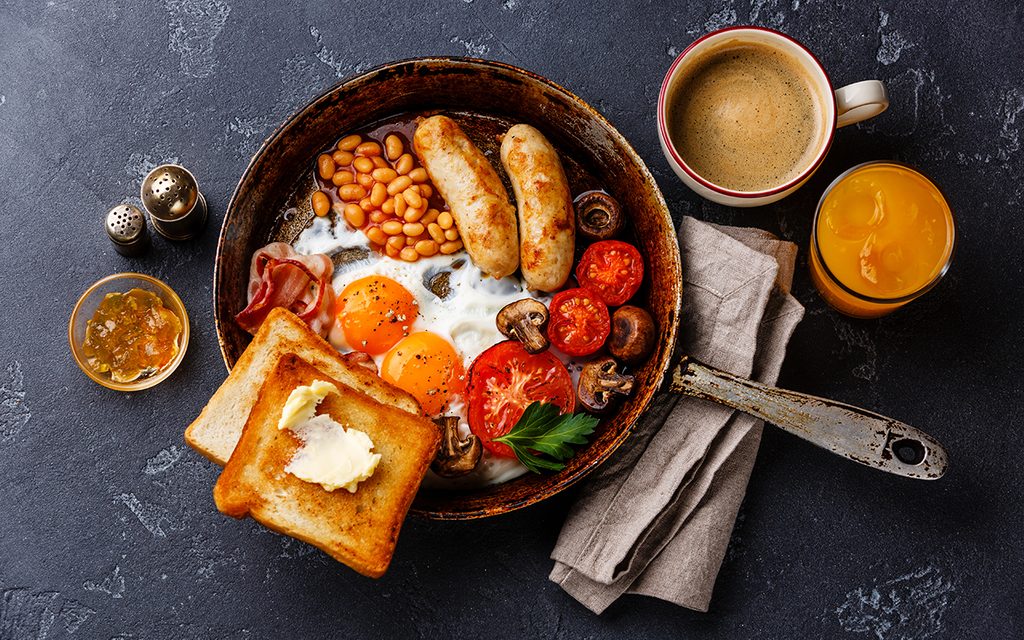 Lisovskaya Natalia/Shutterstock
Lisovskaya Natalia/Shutterstock Taste of Home
Taste of Home

